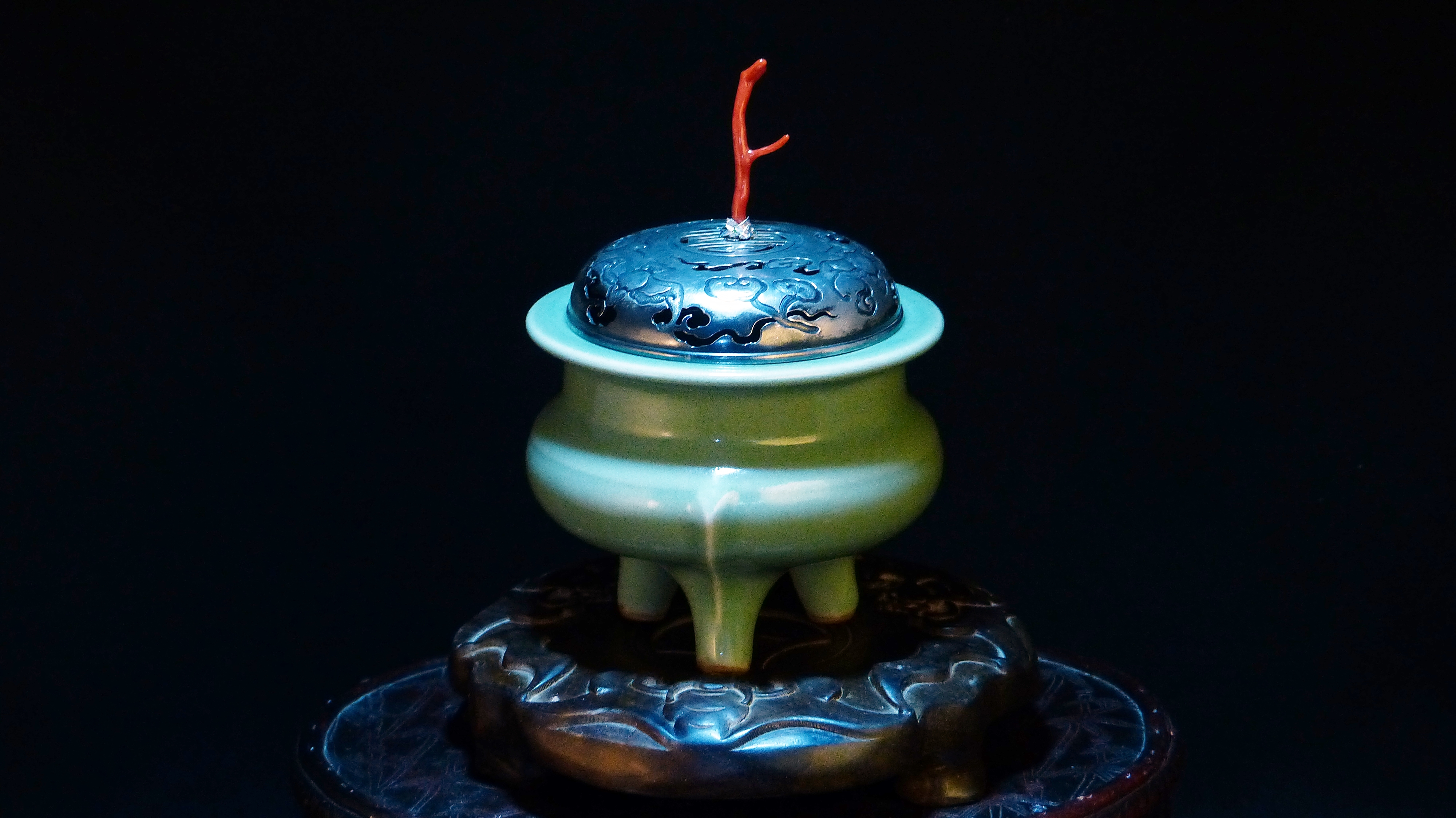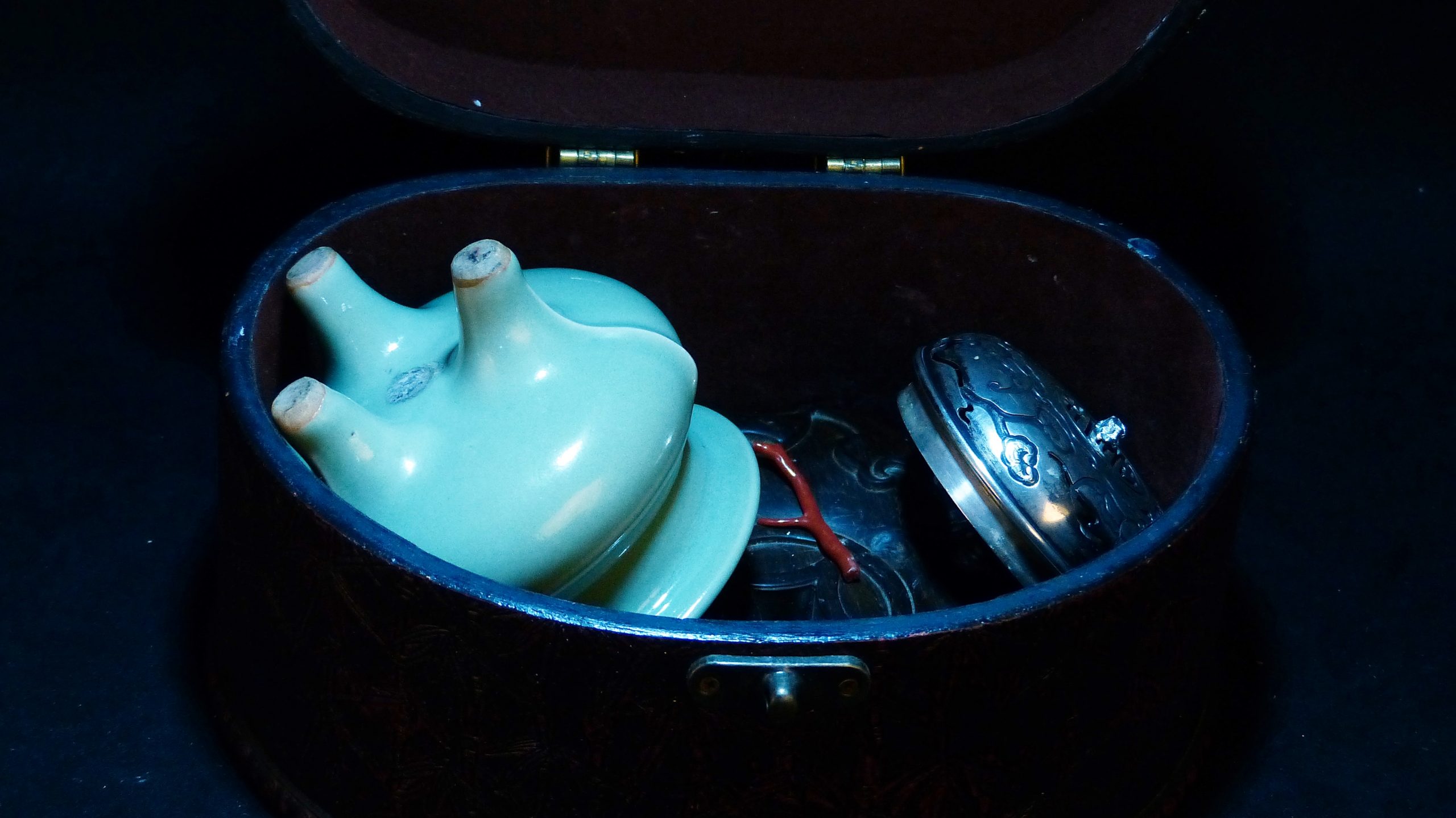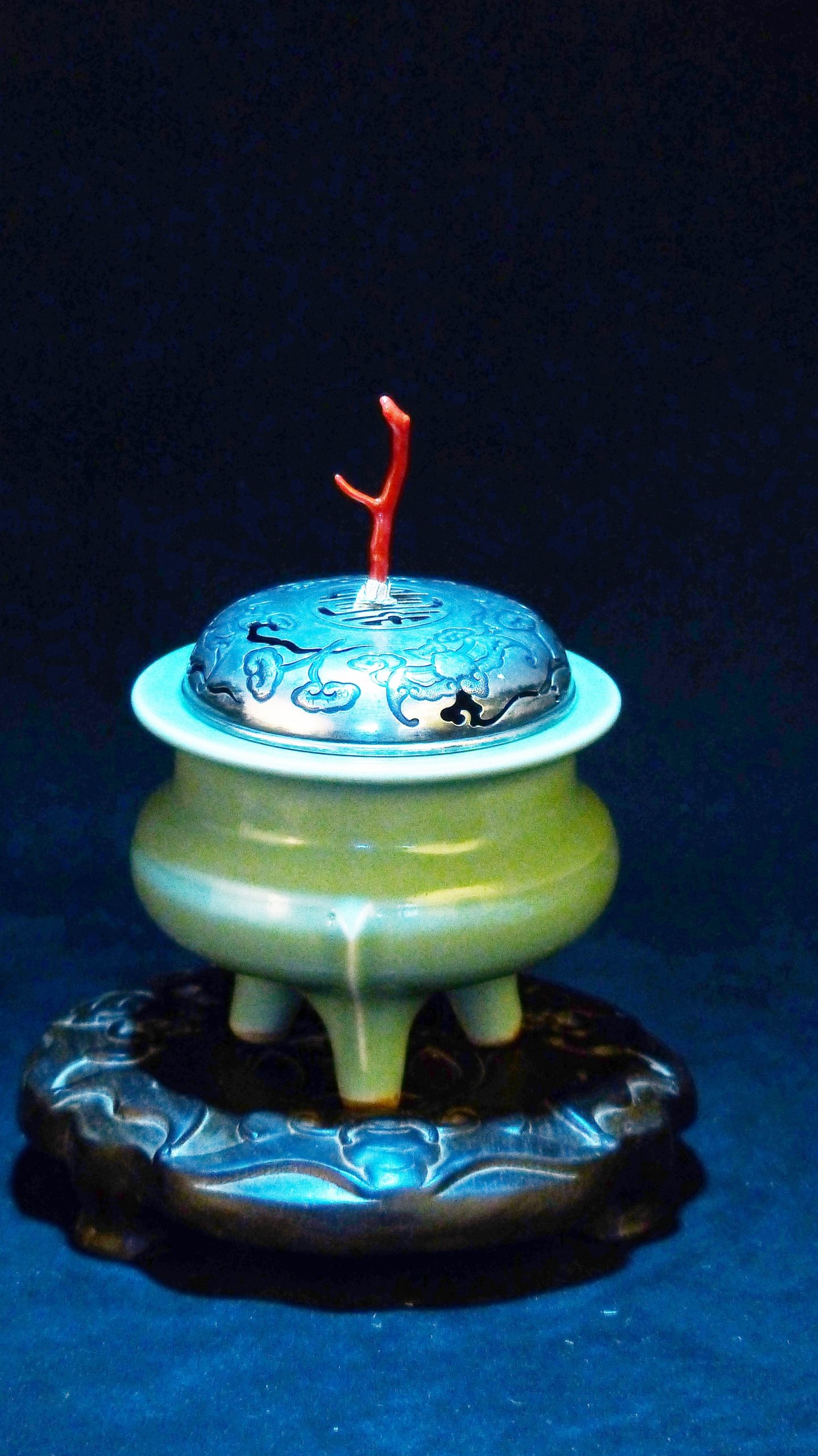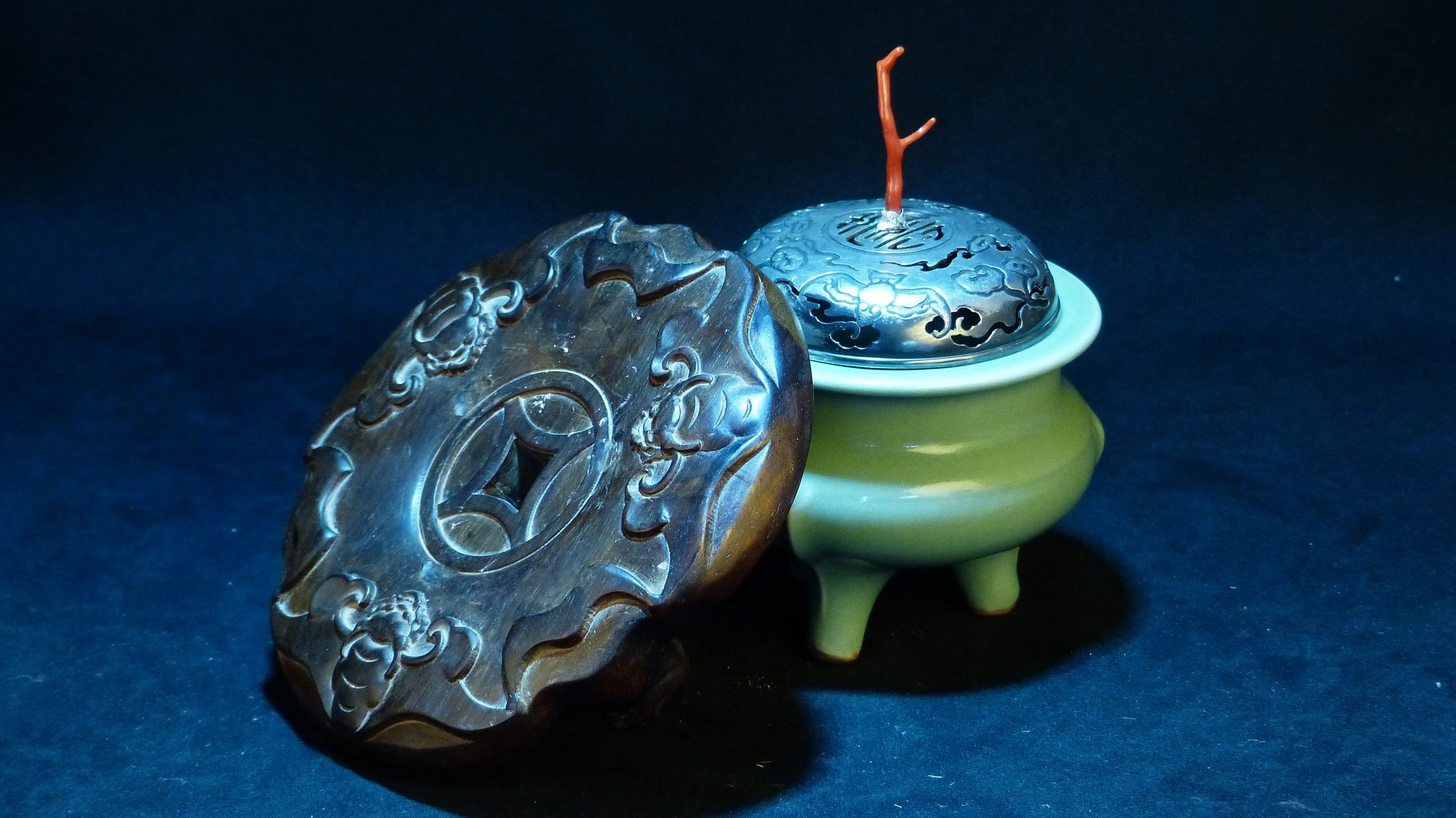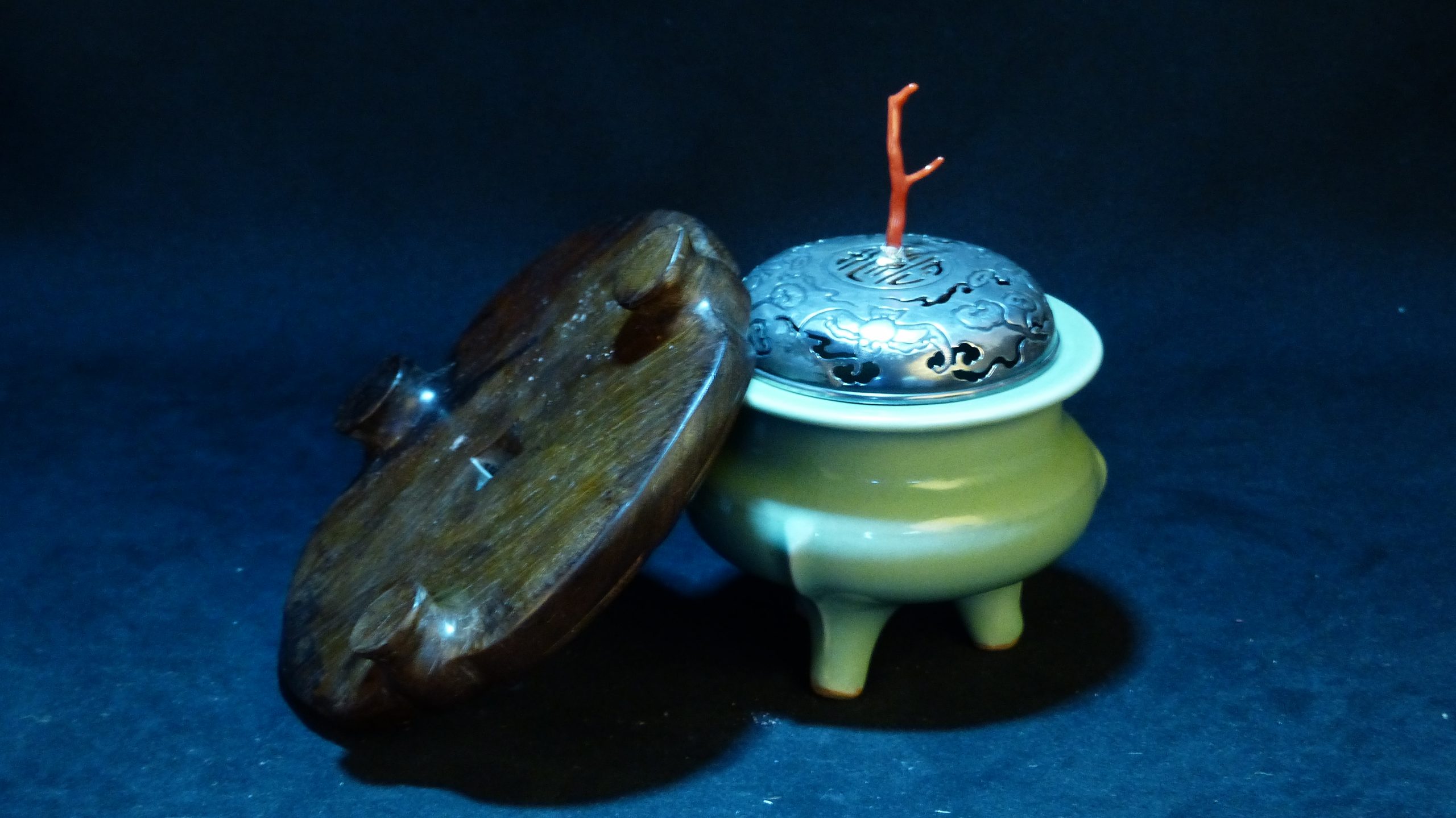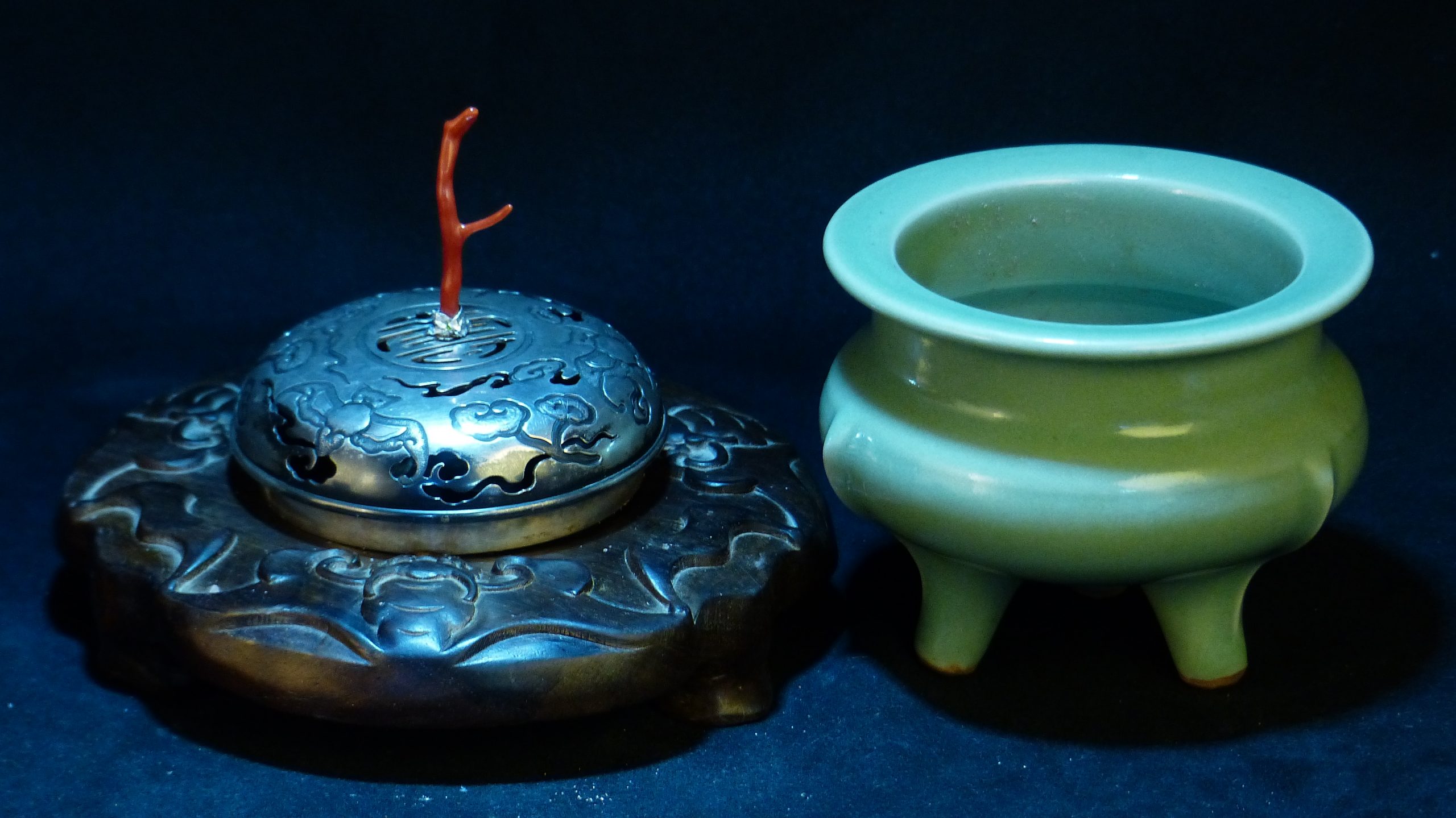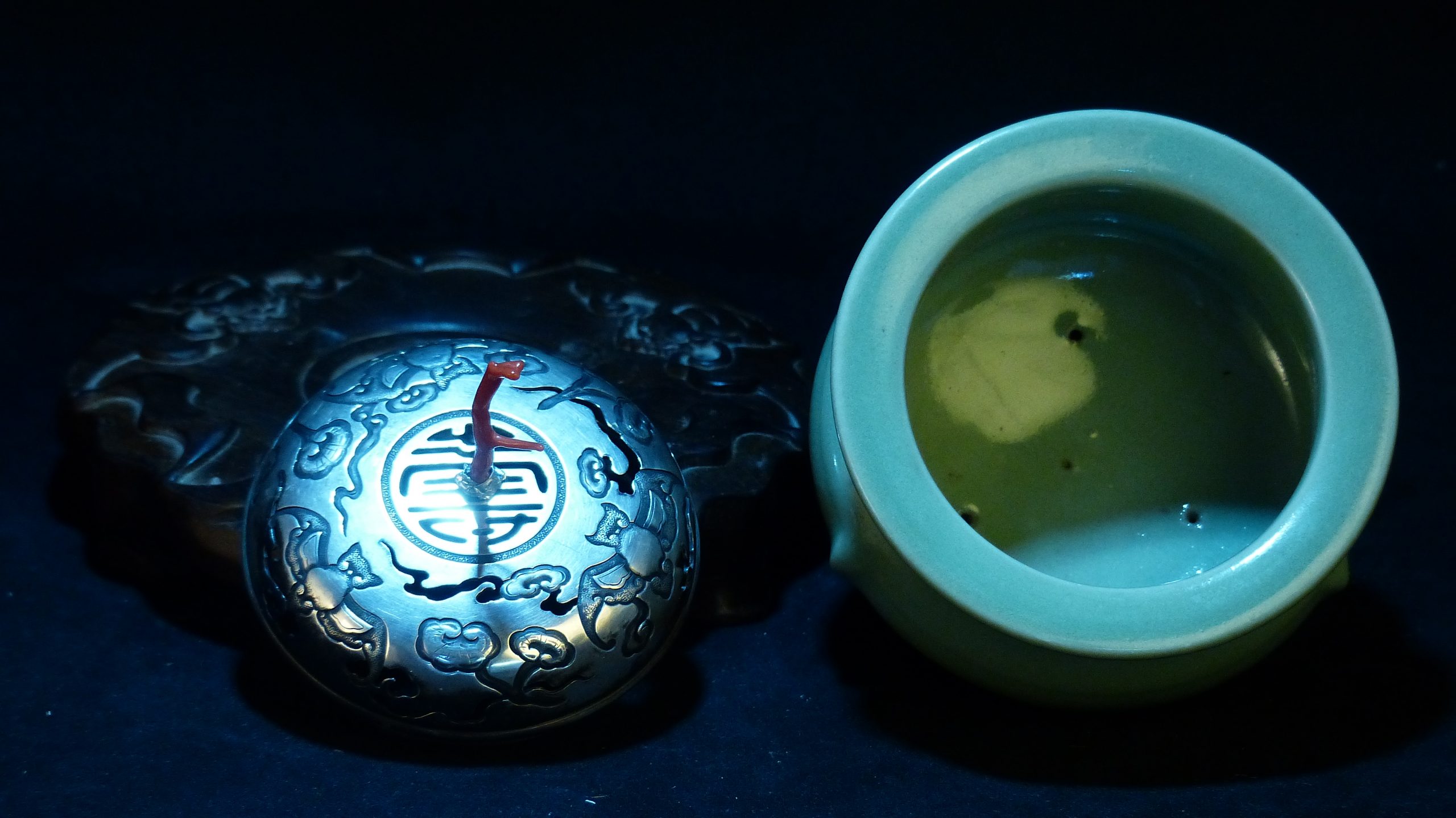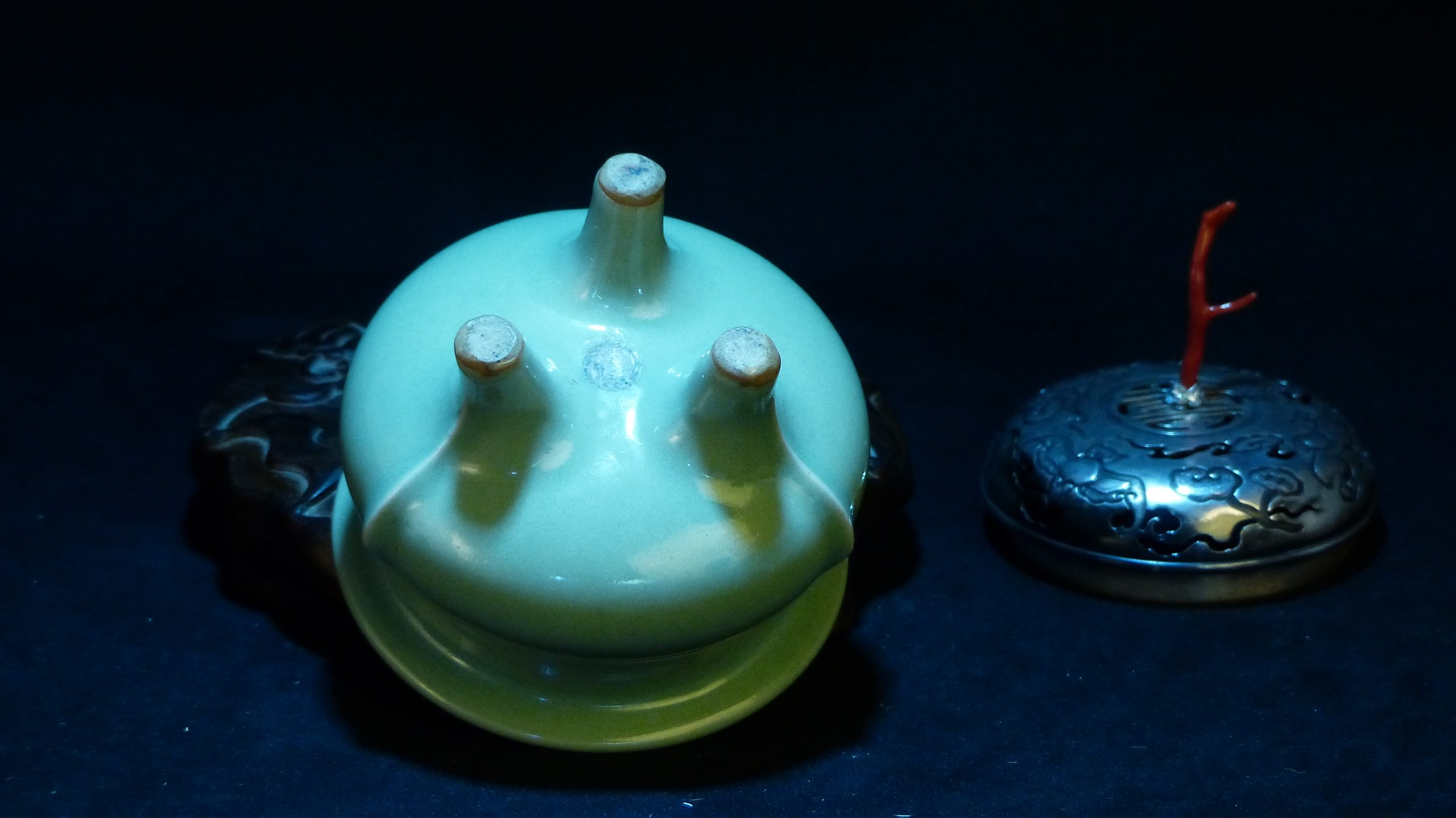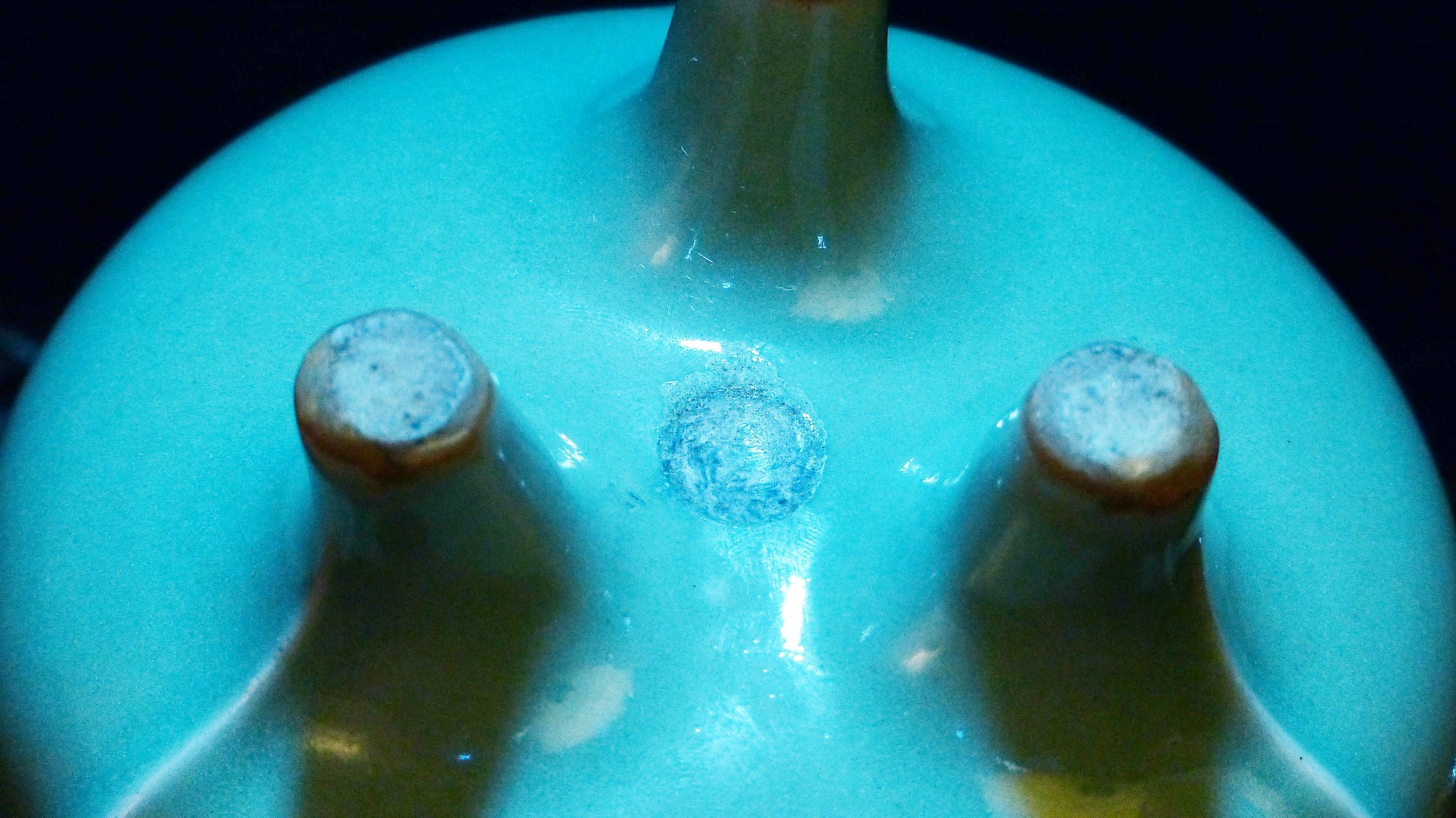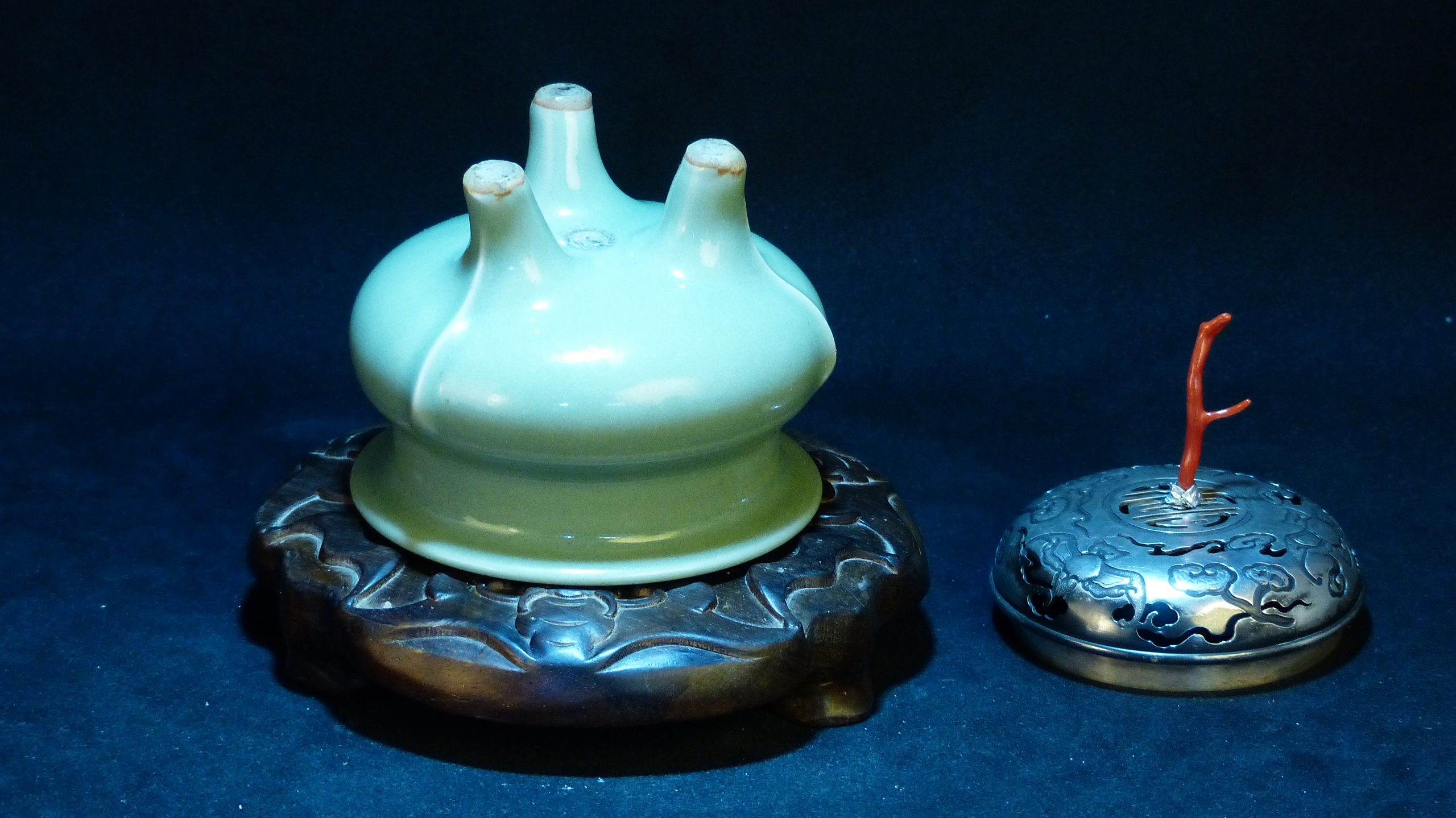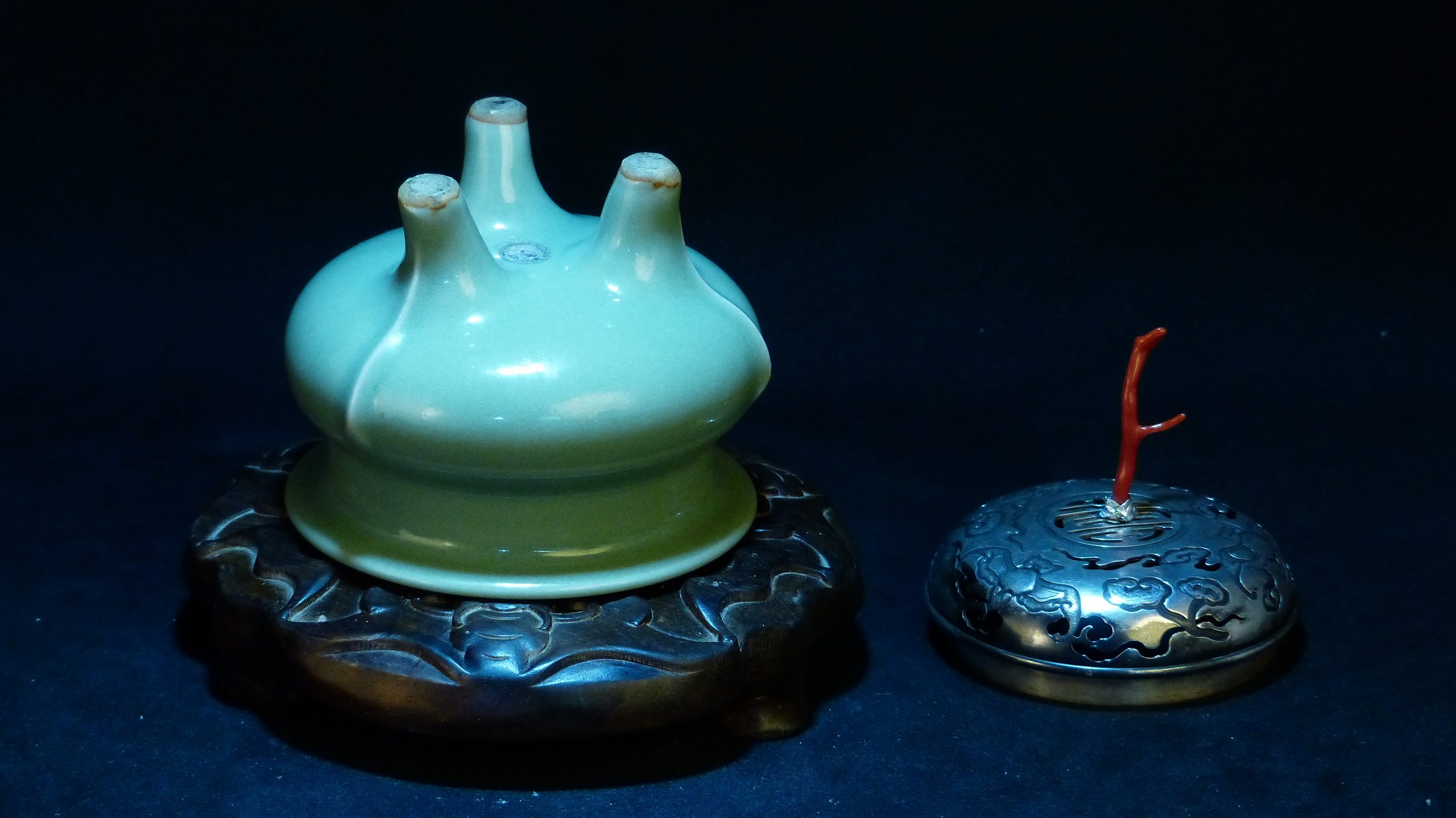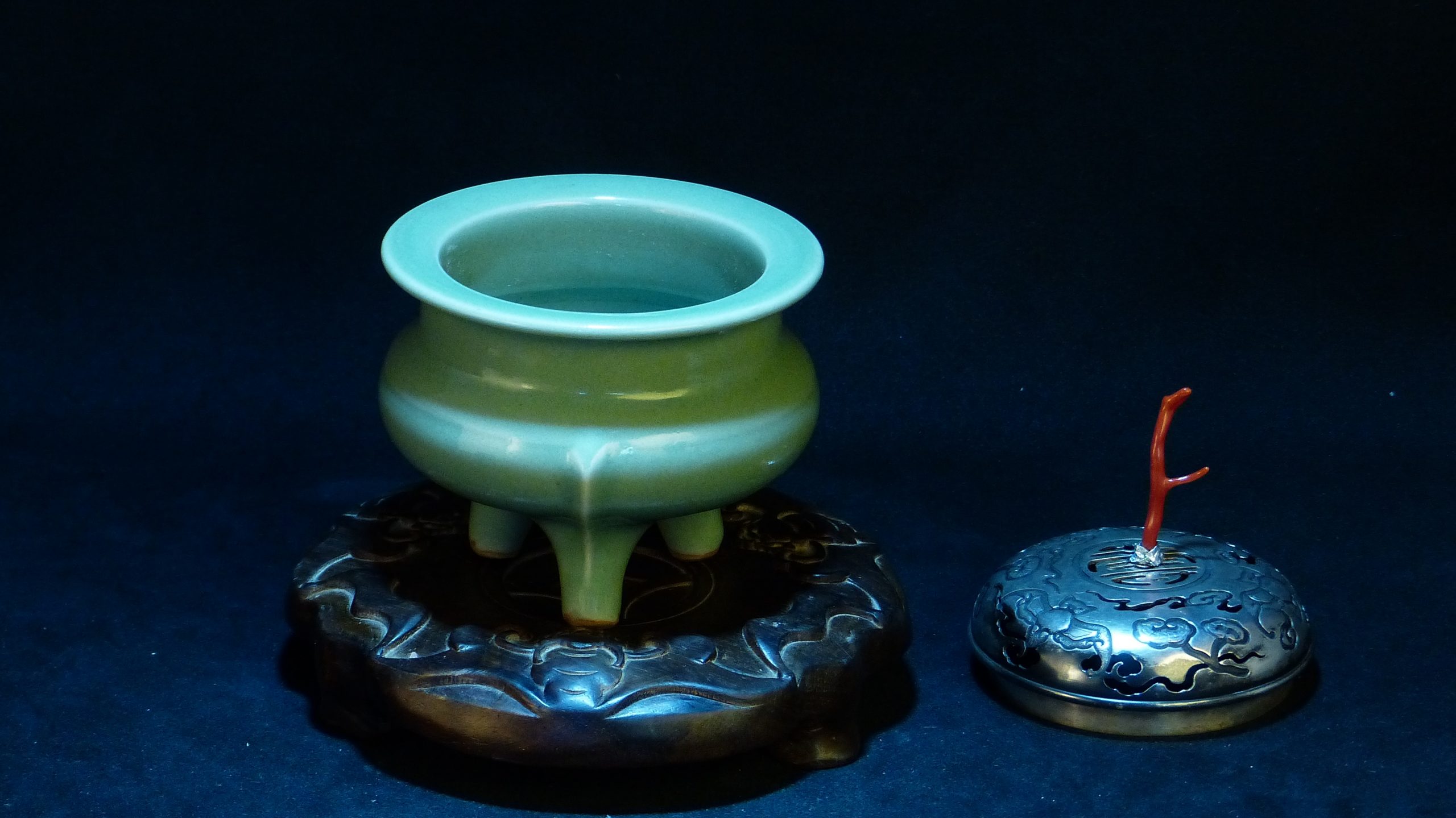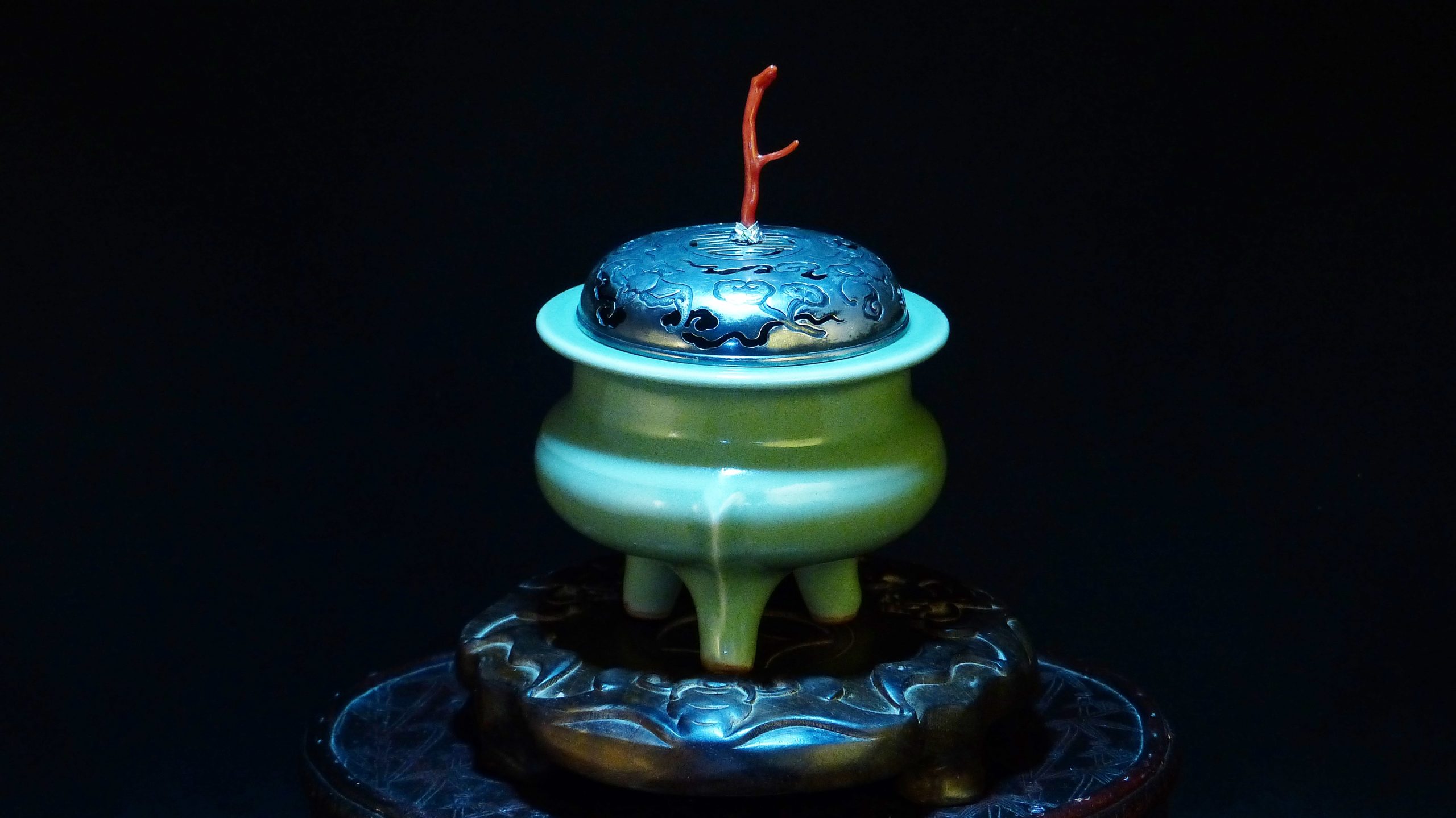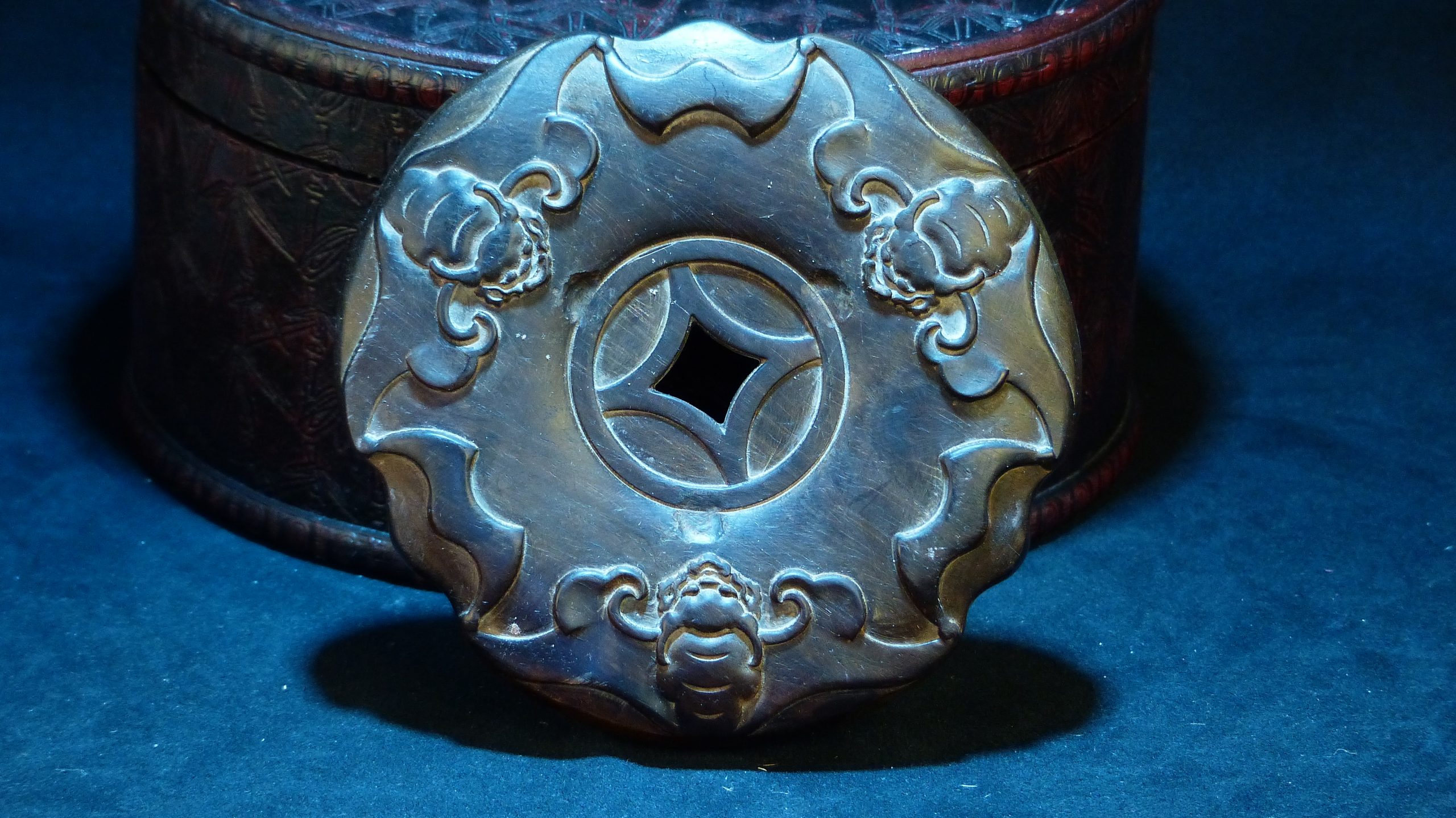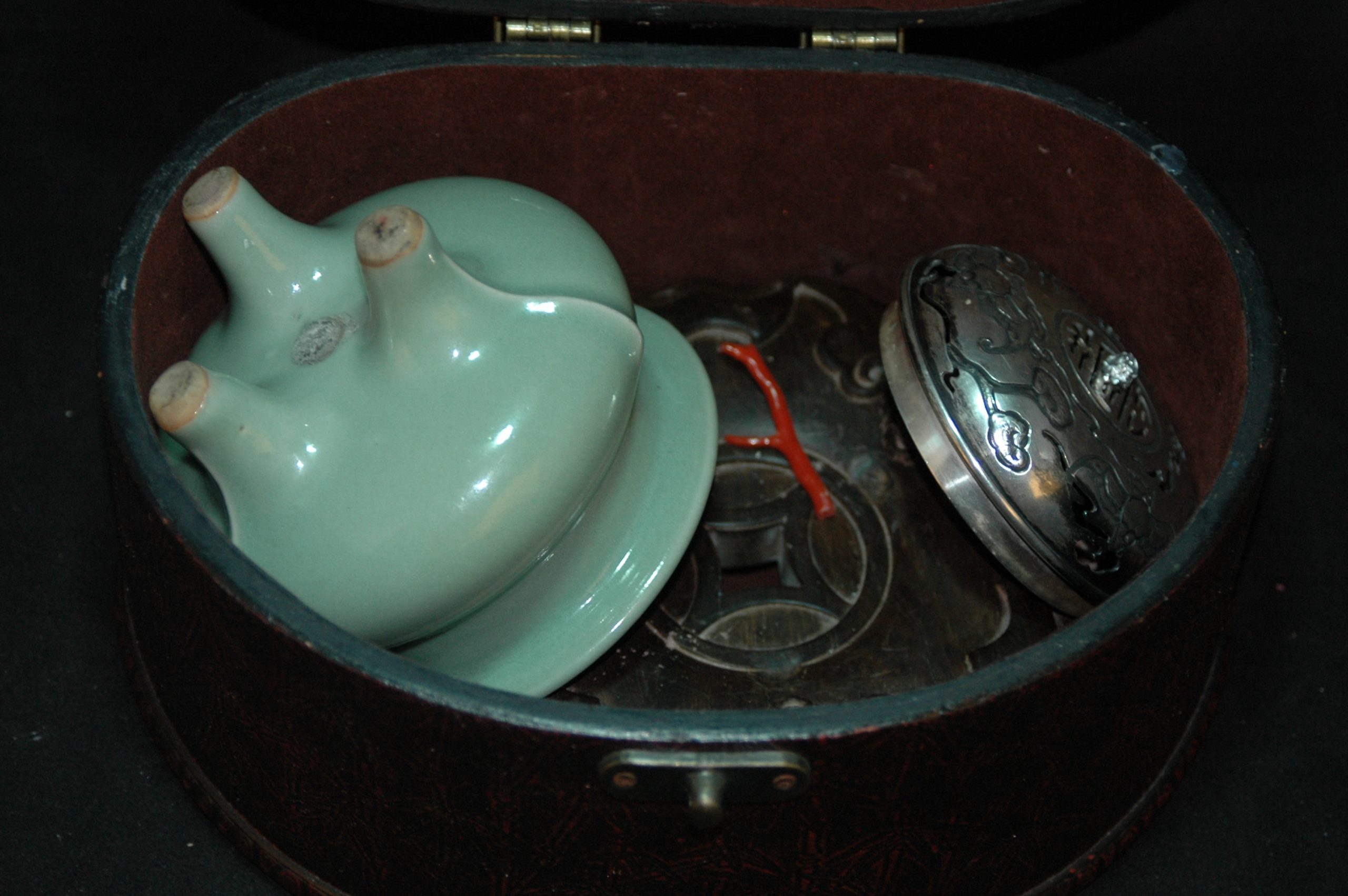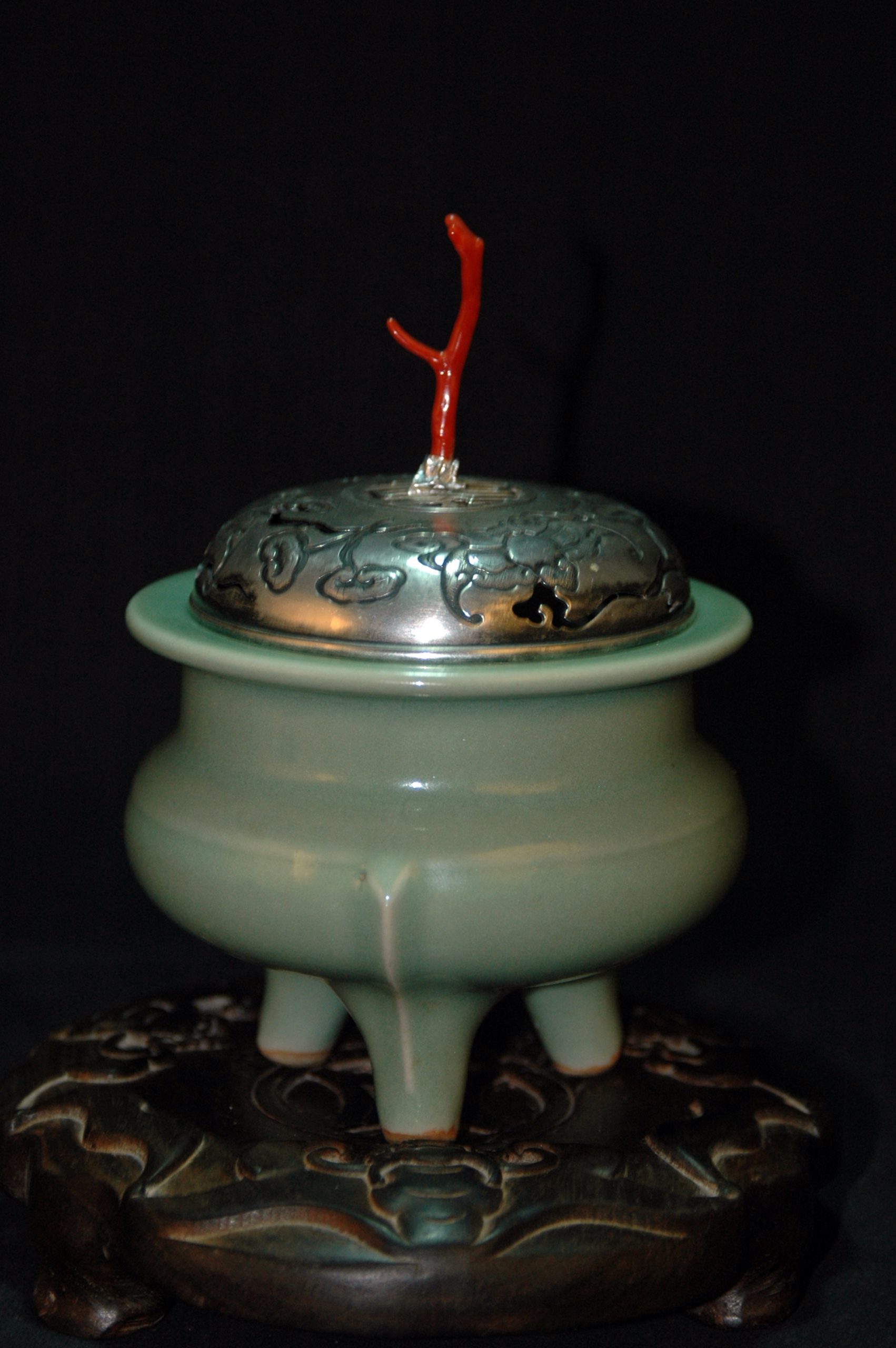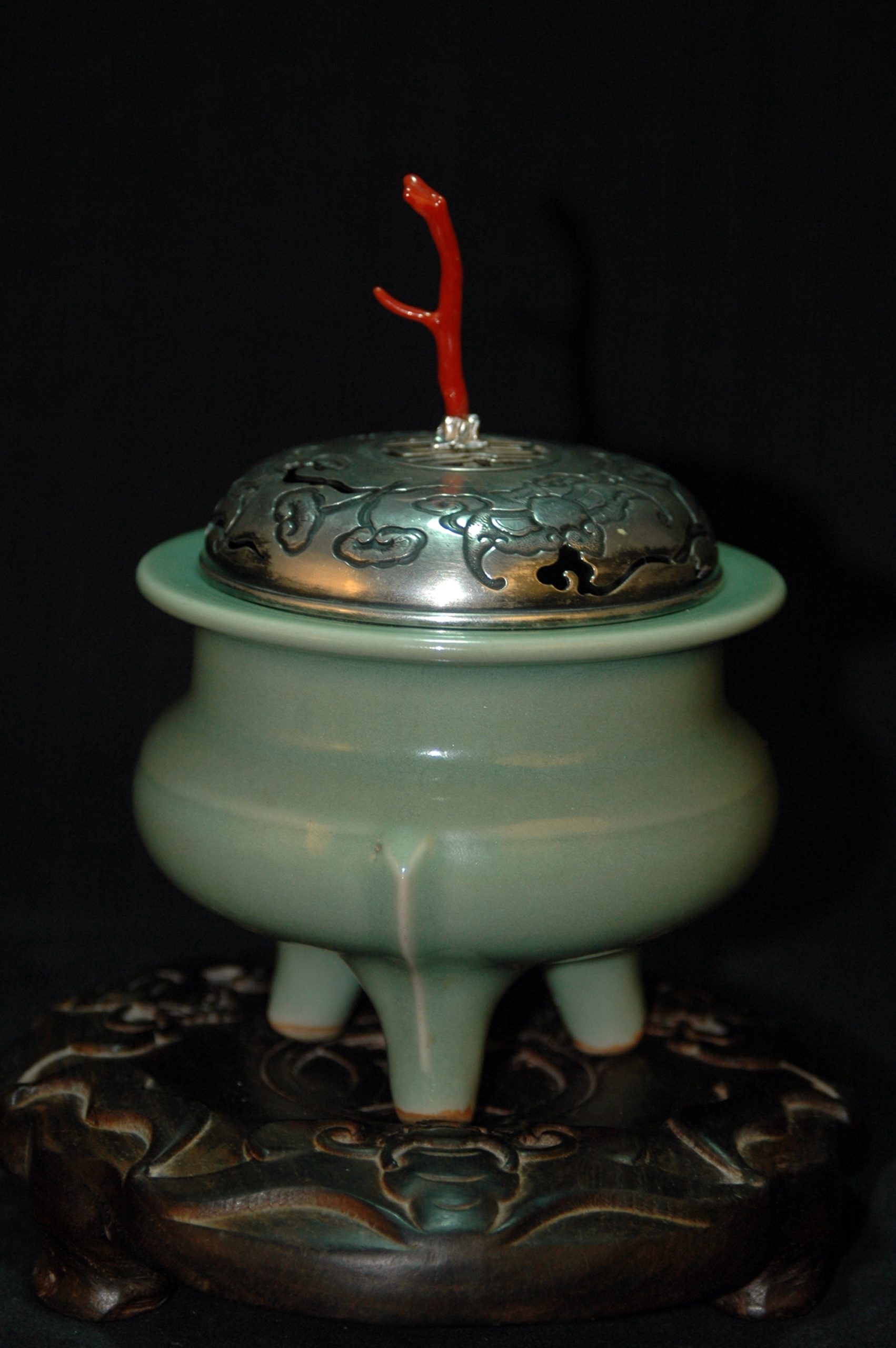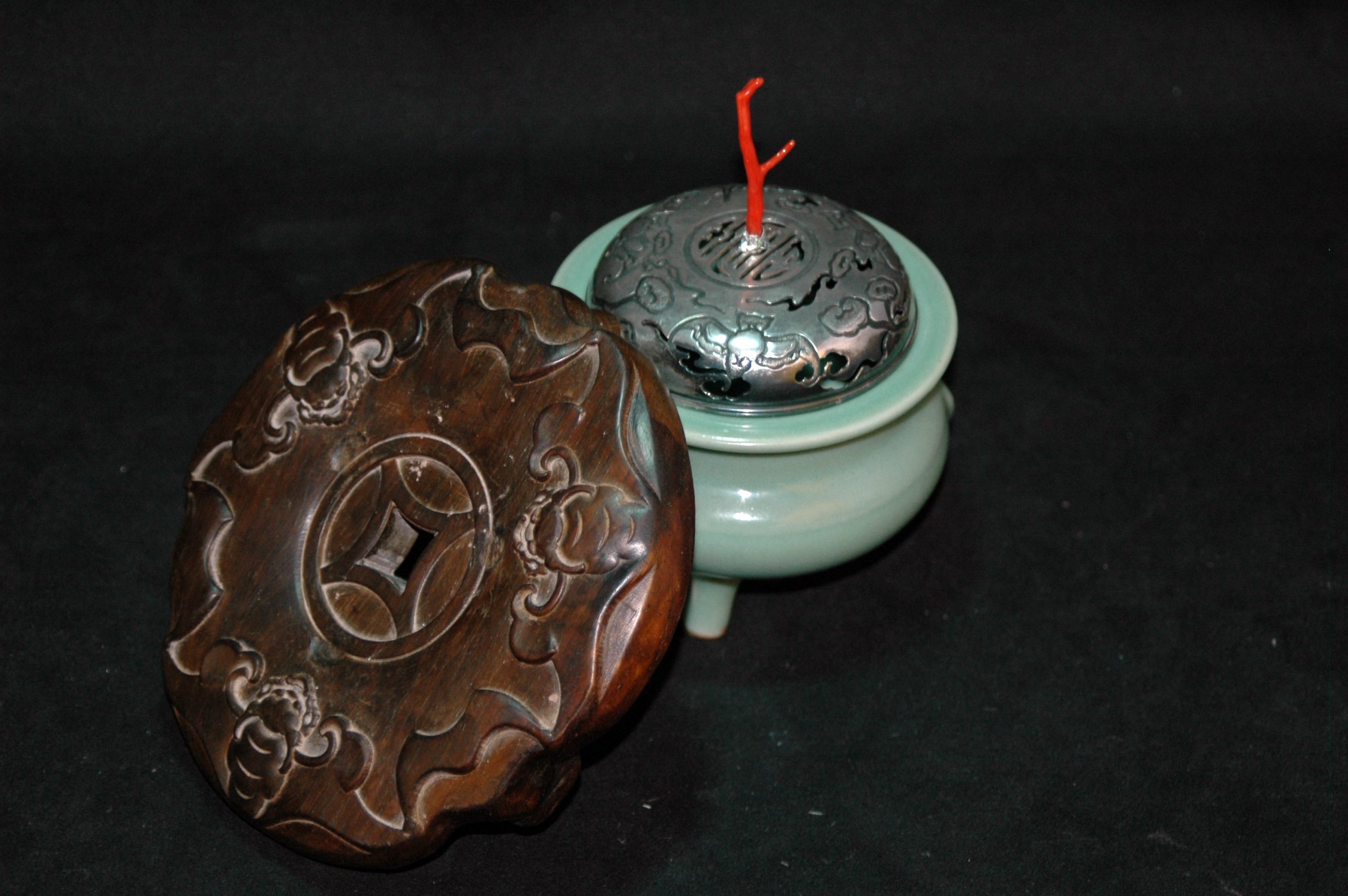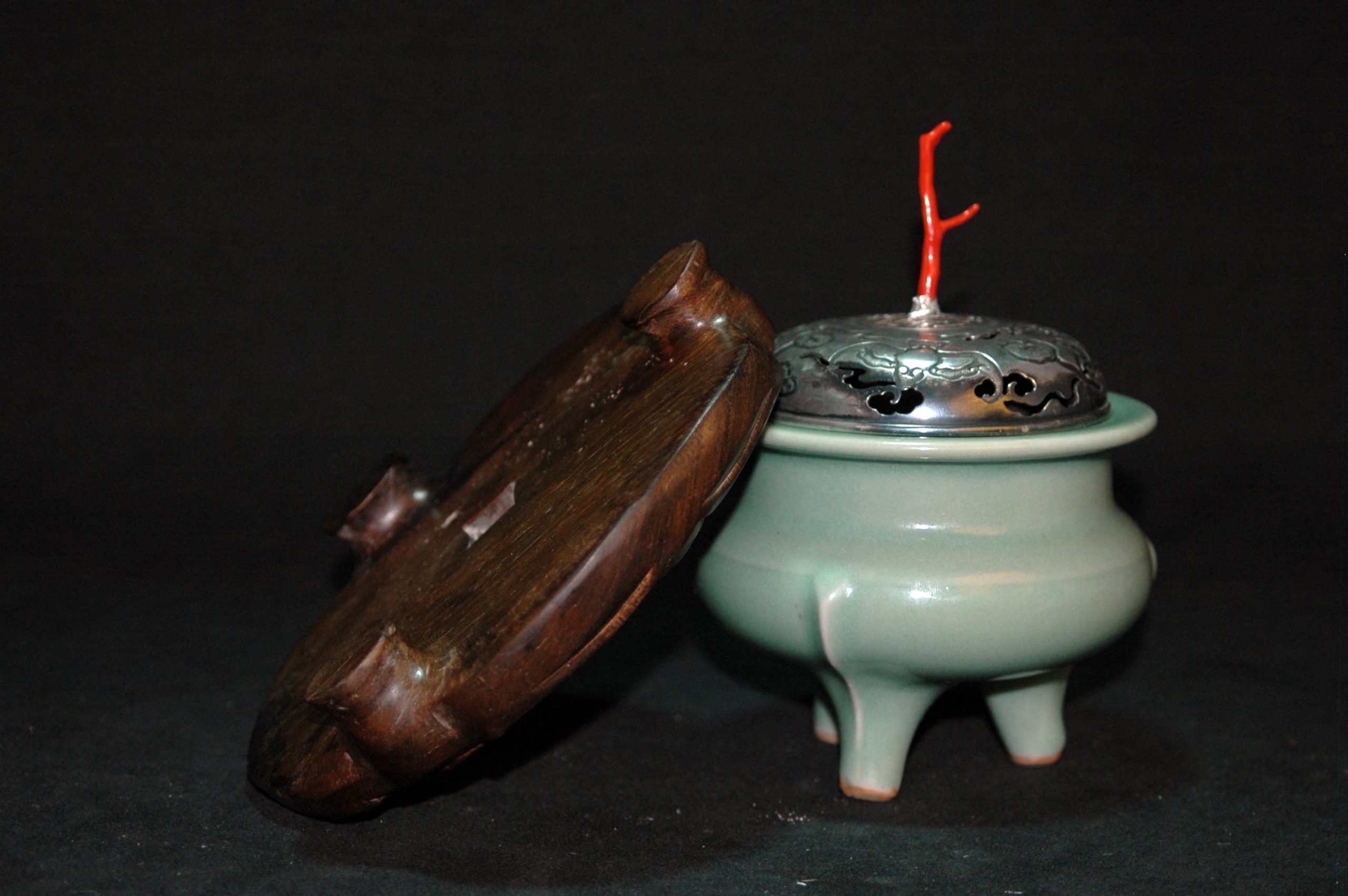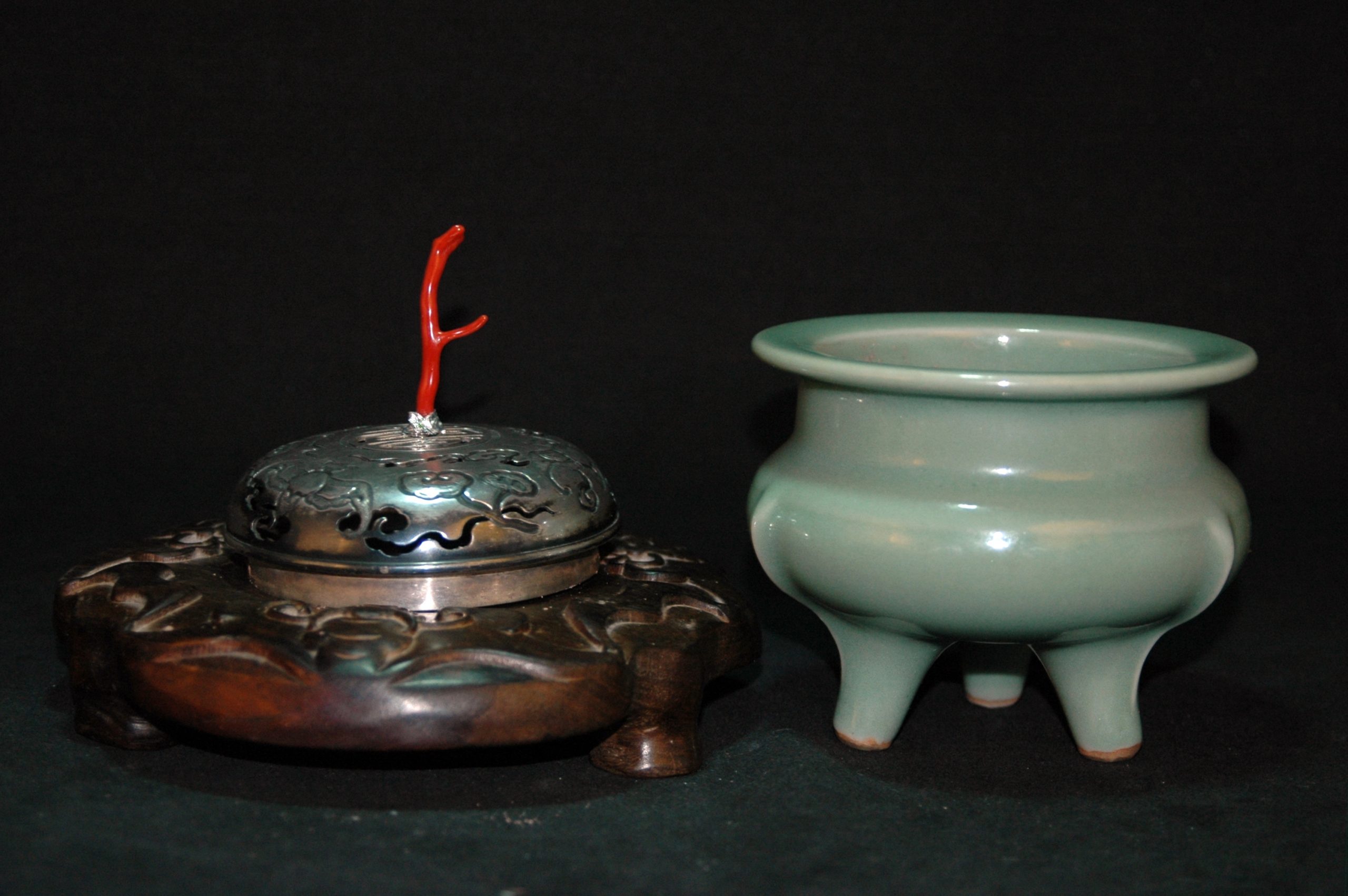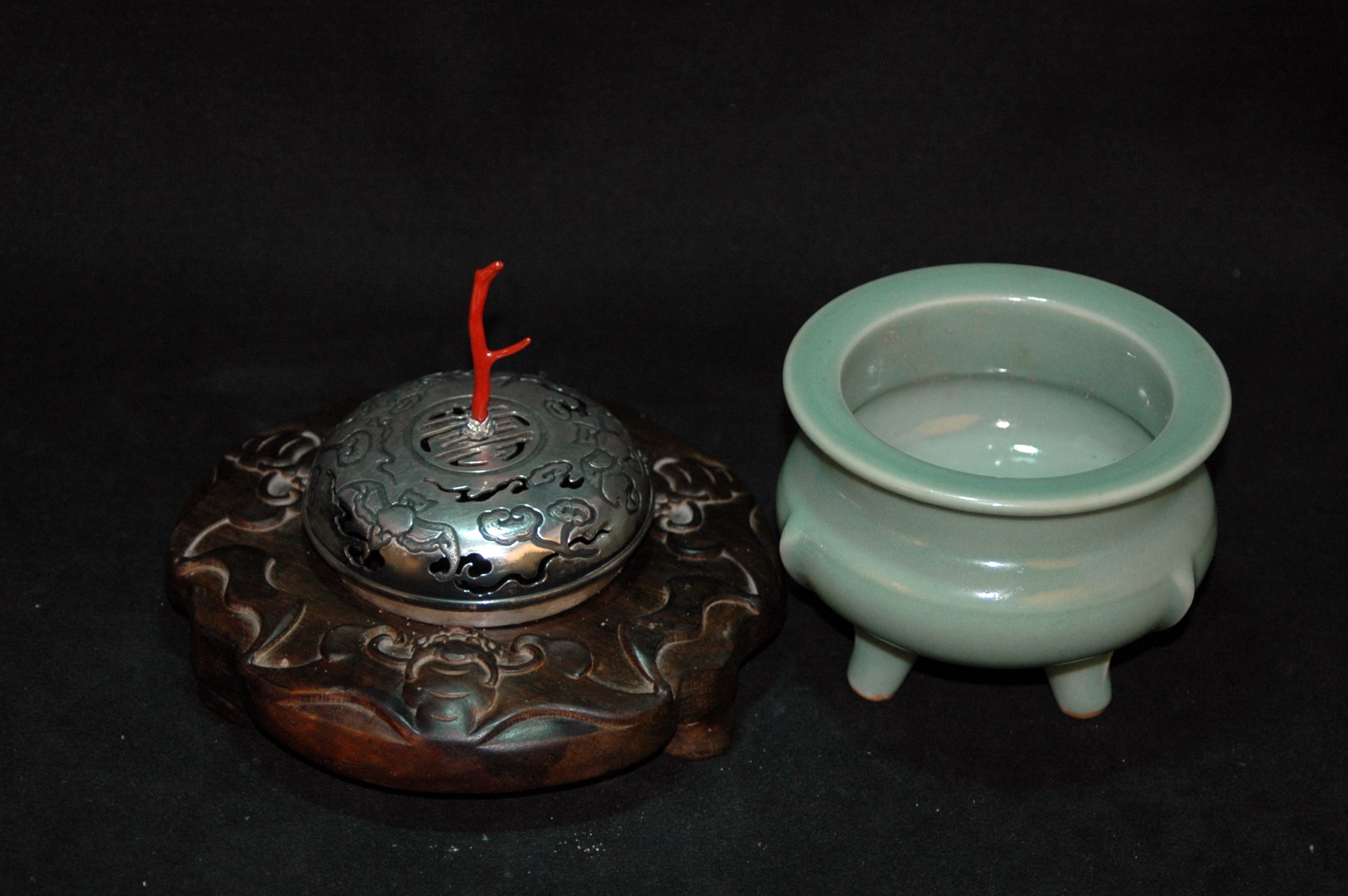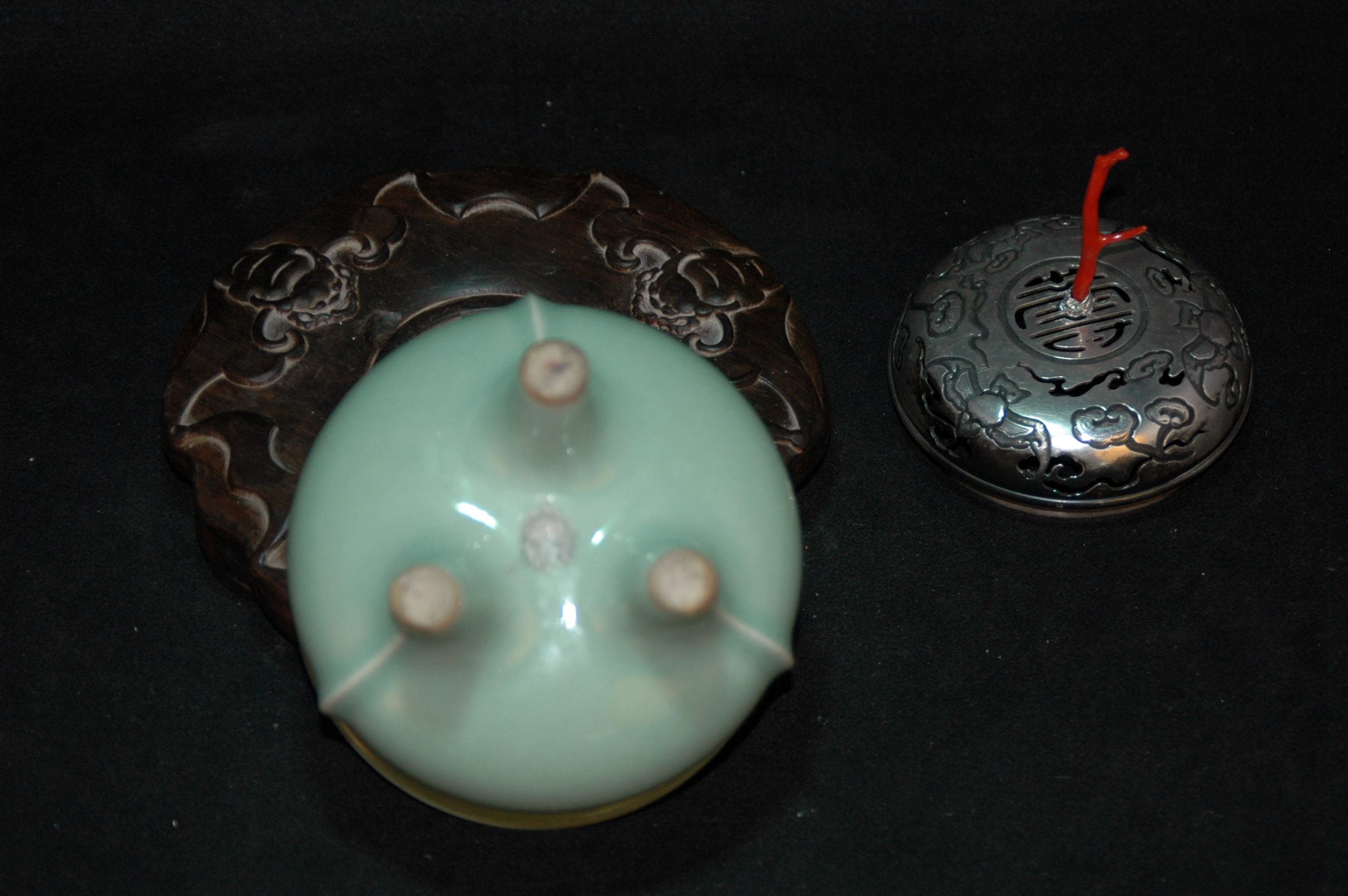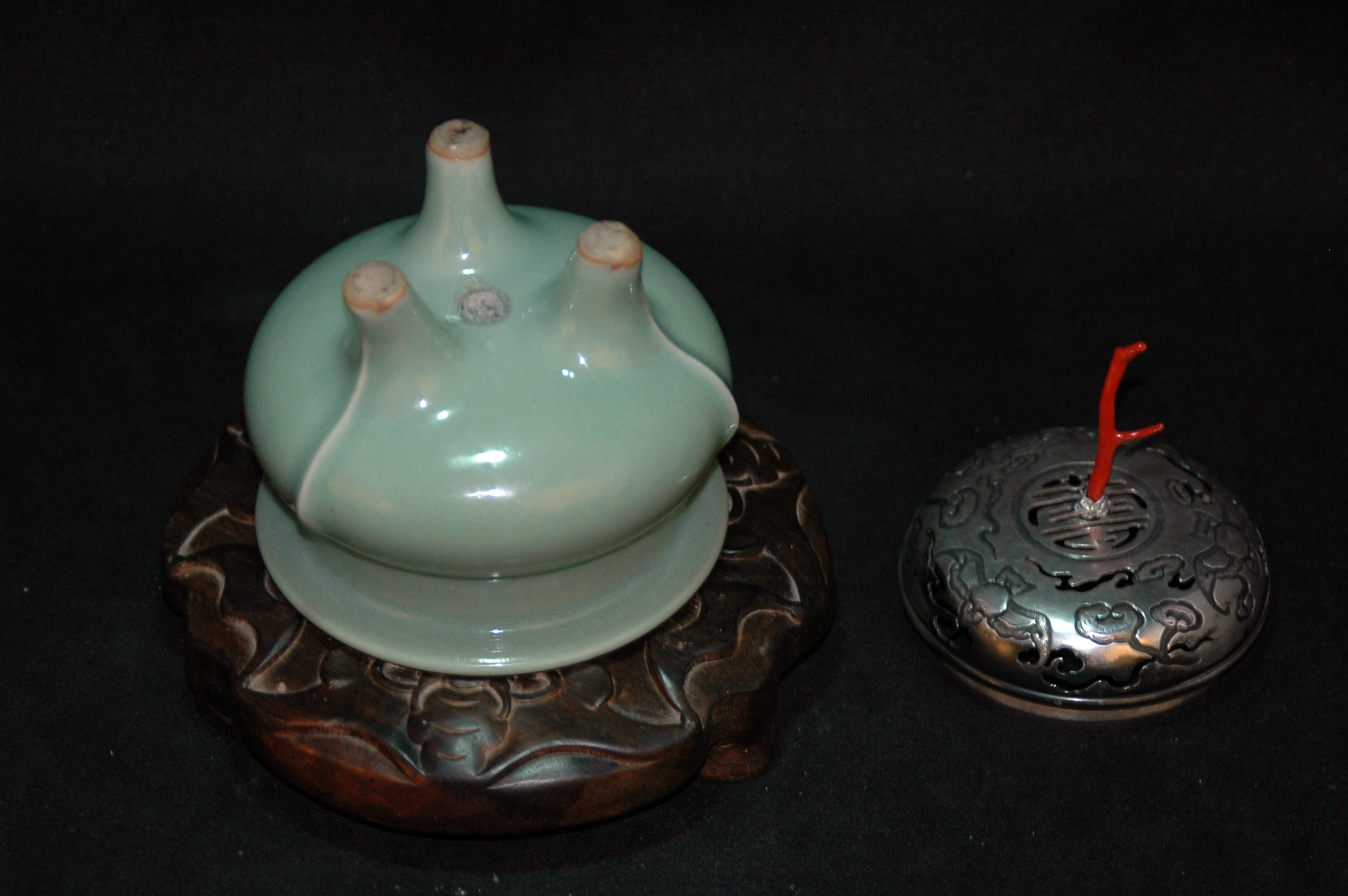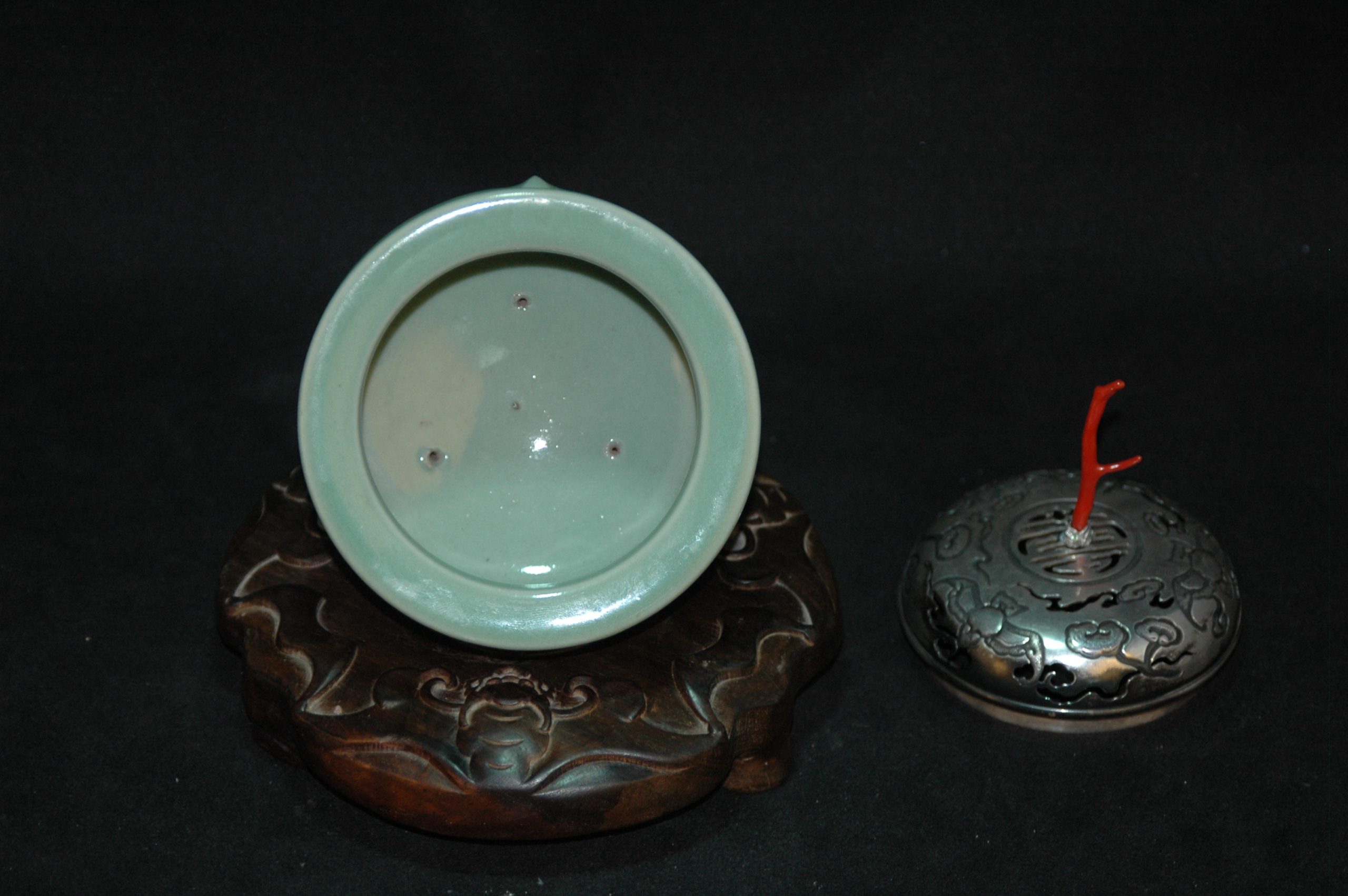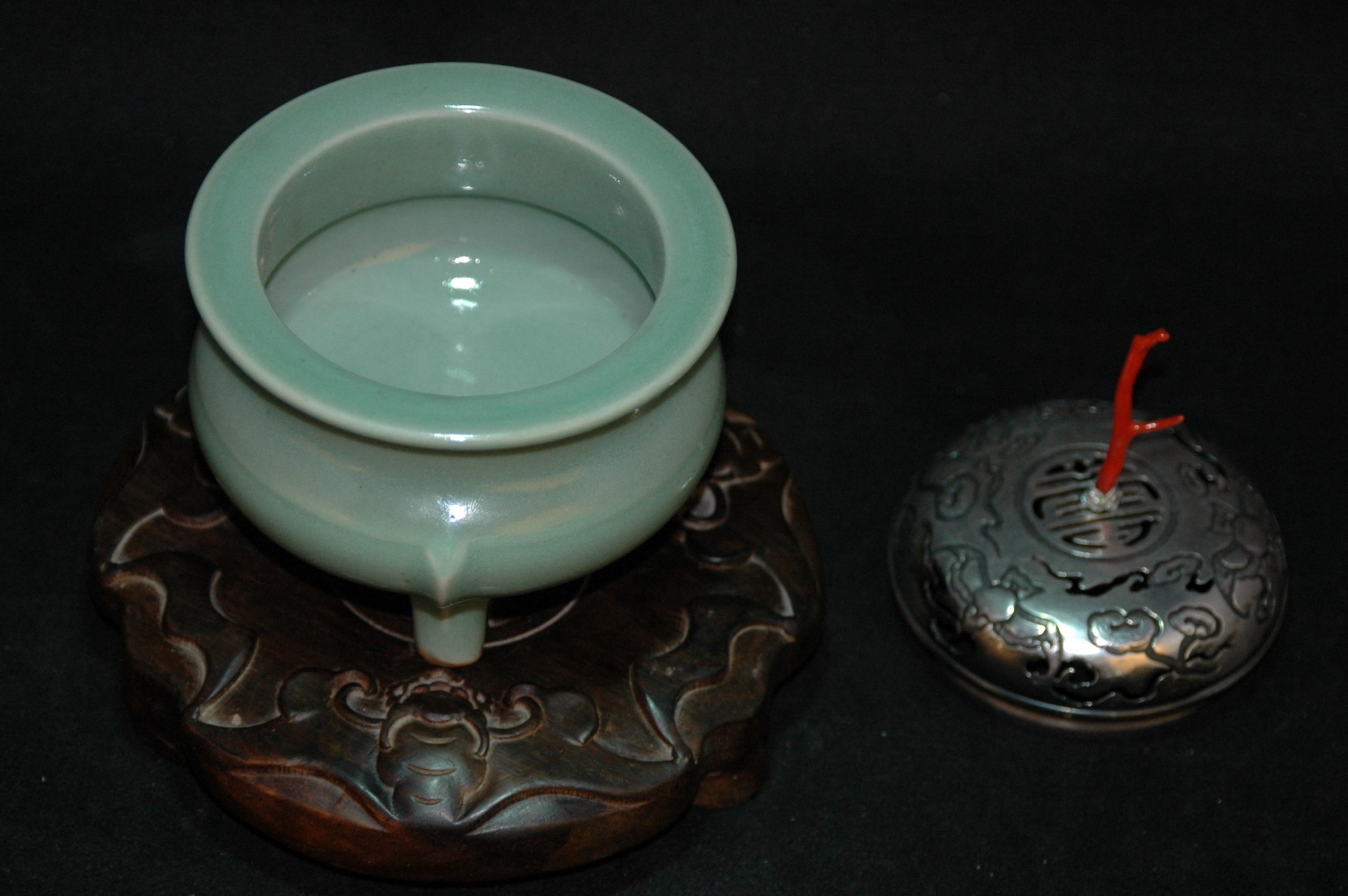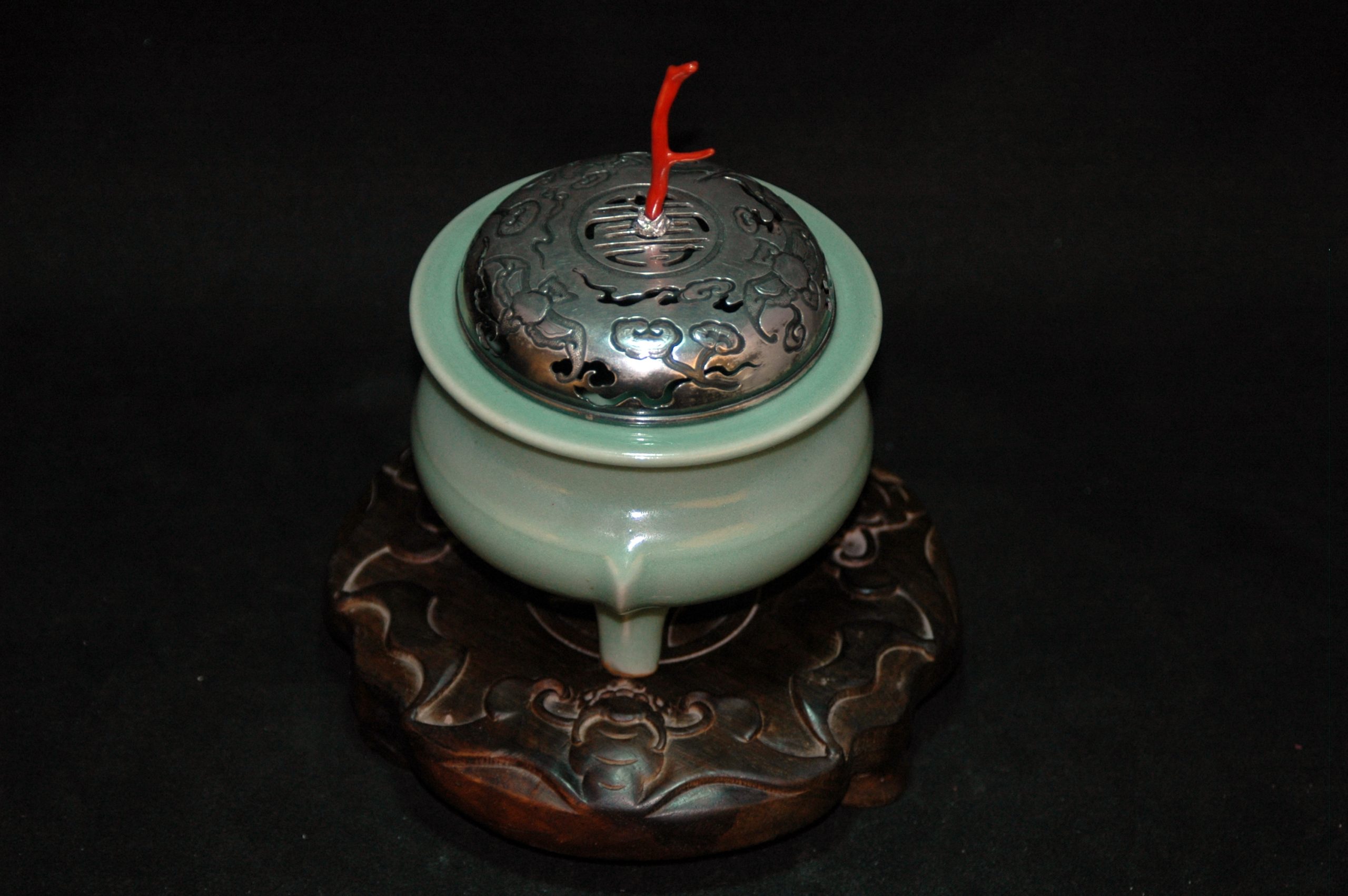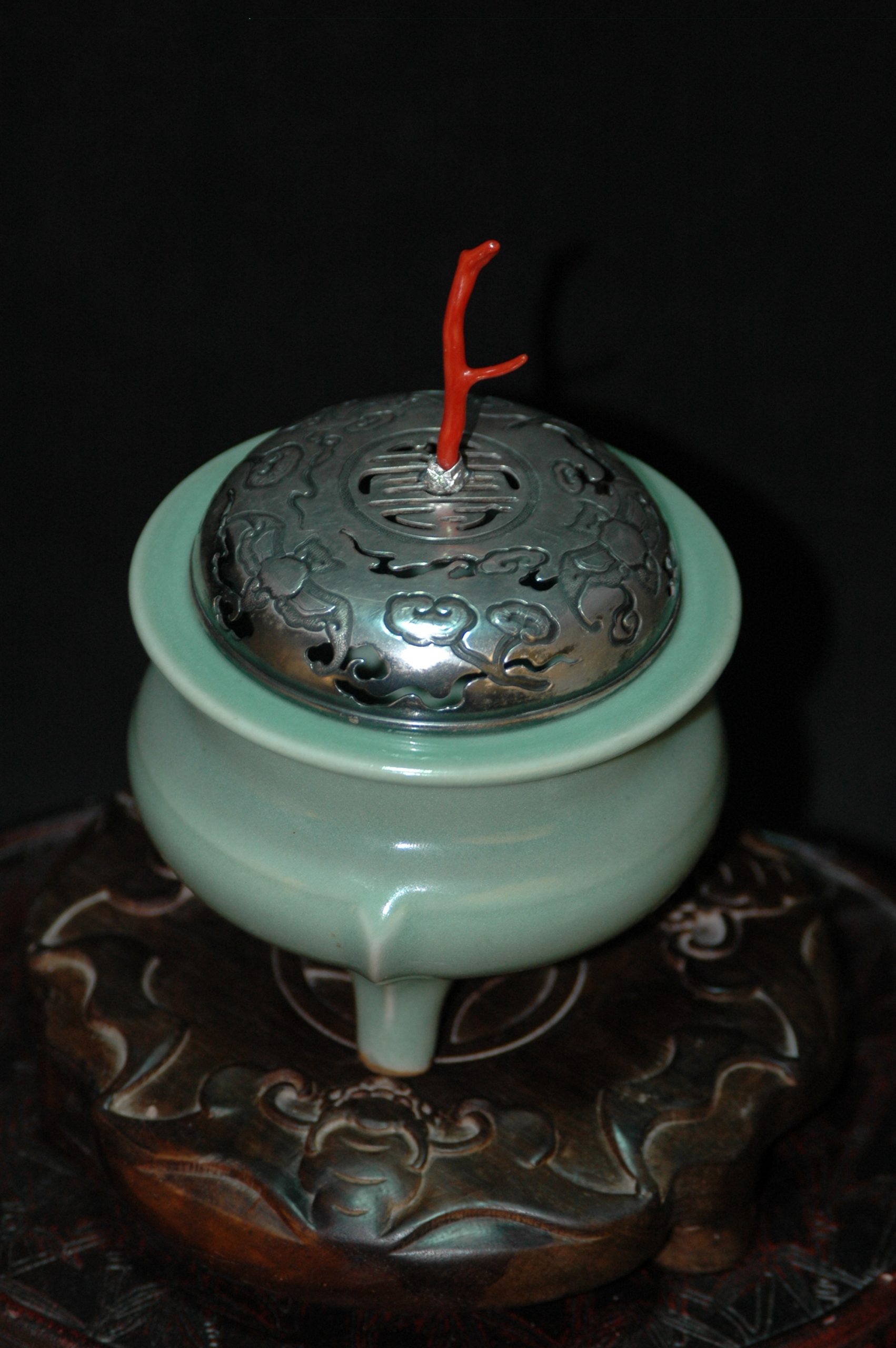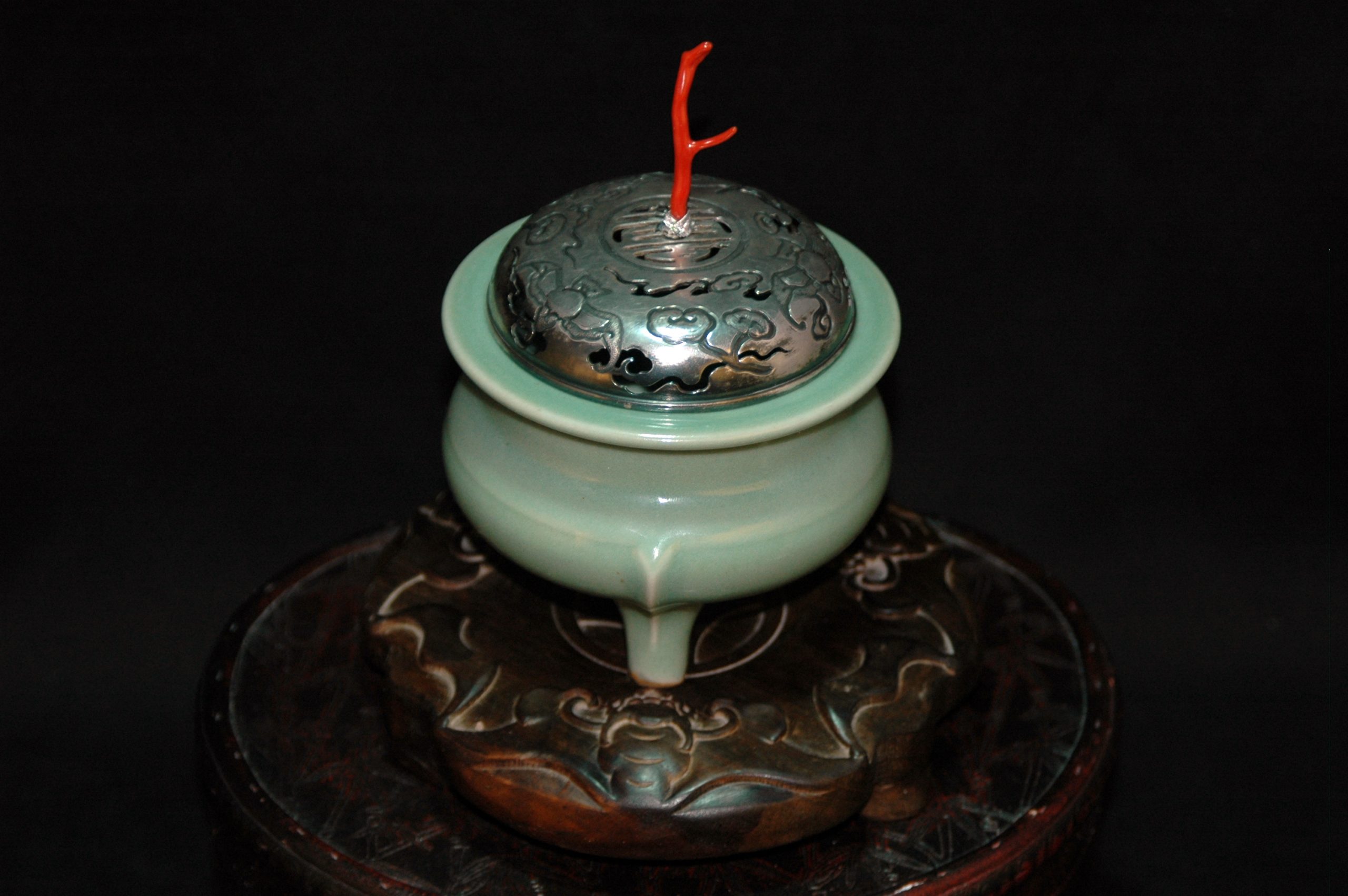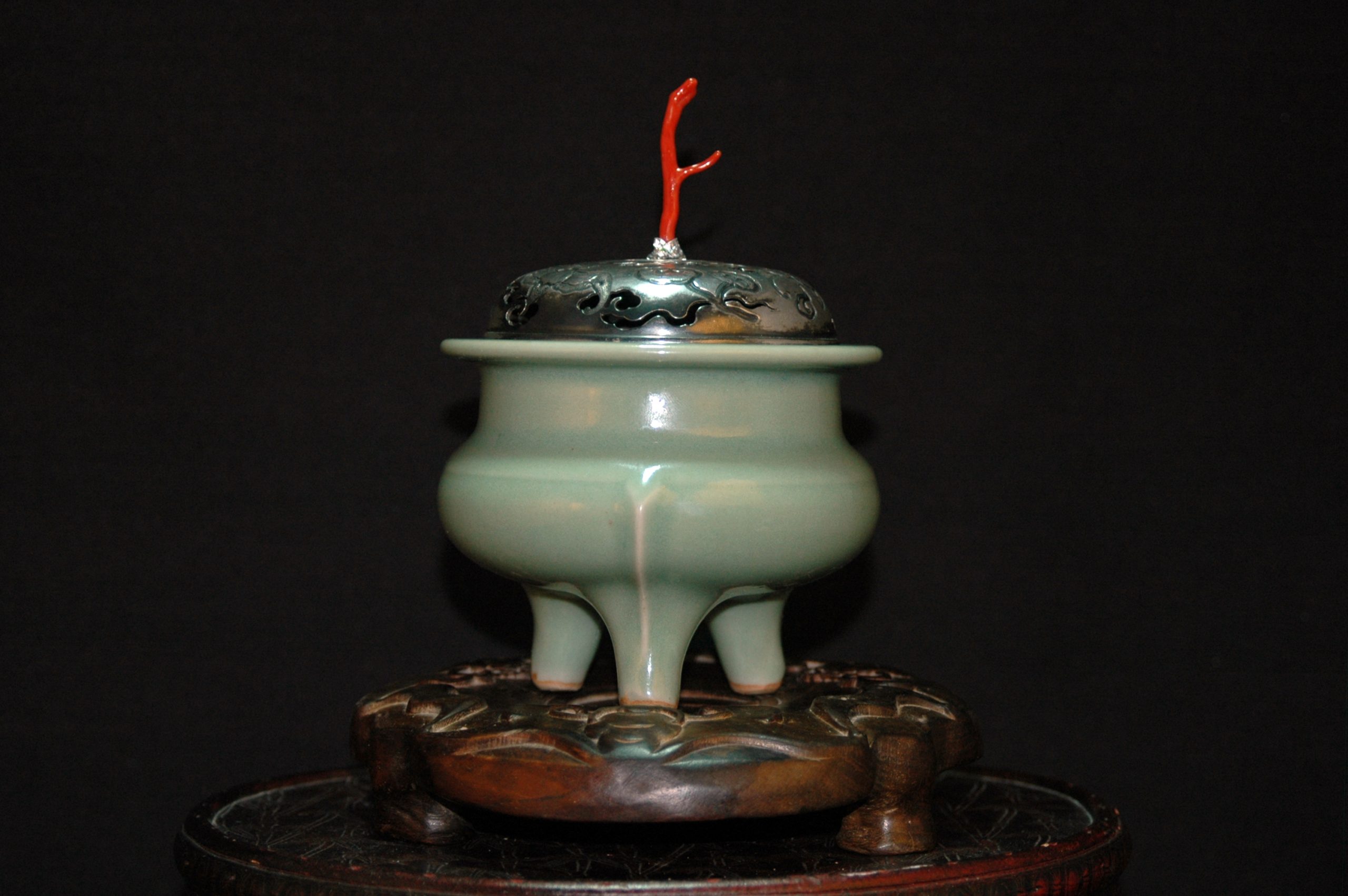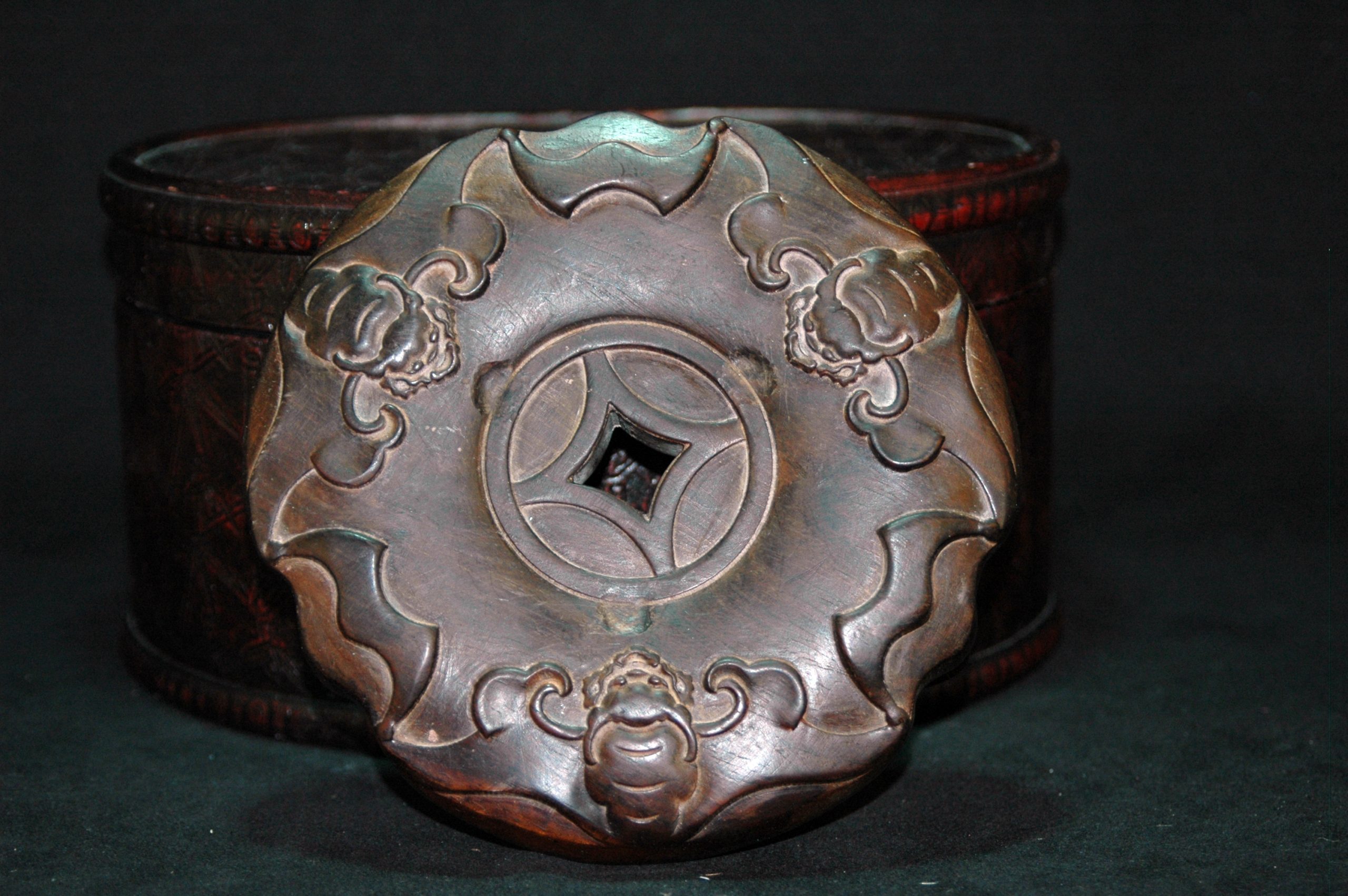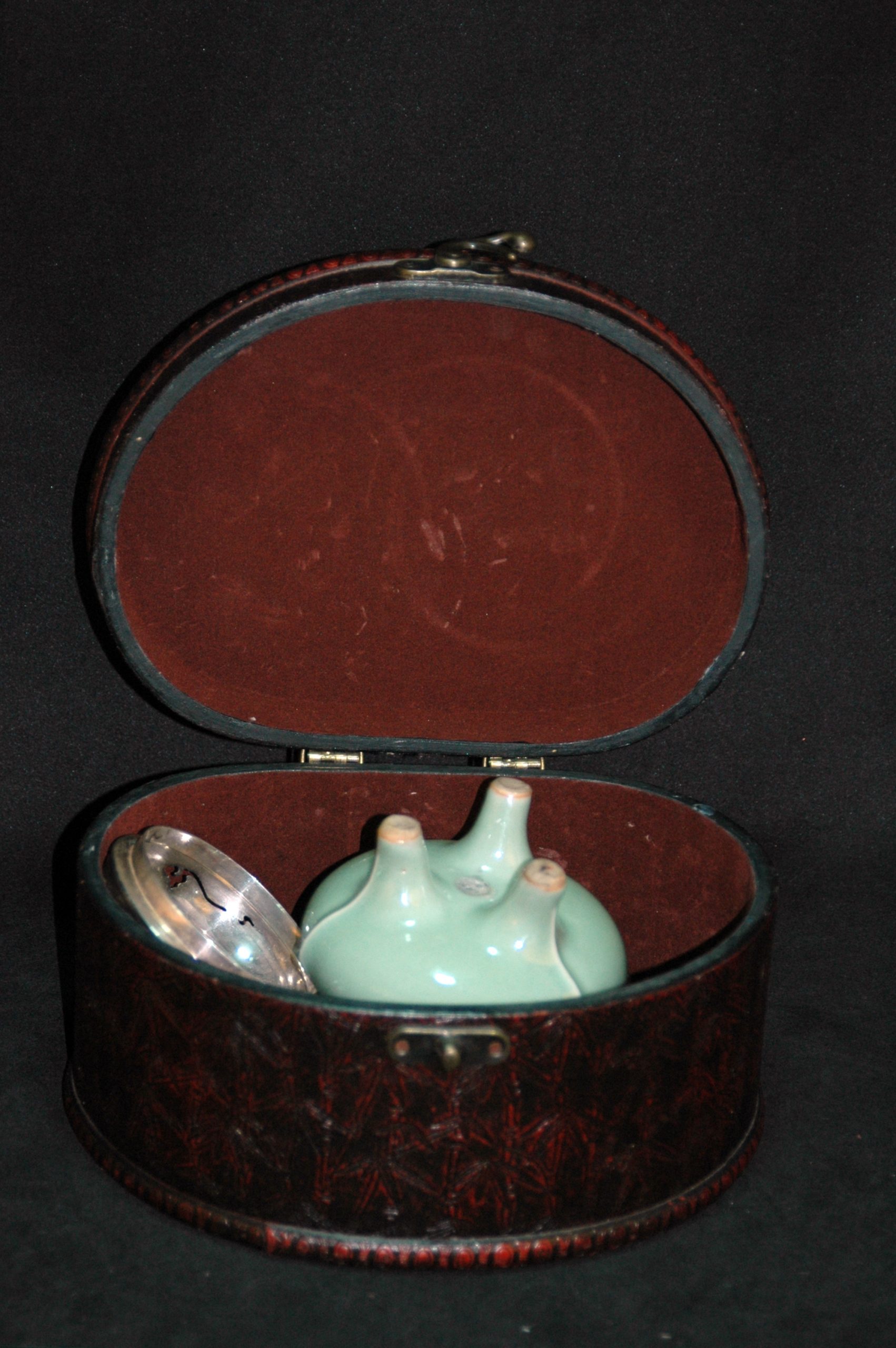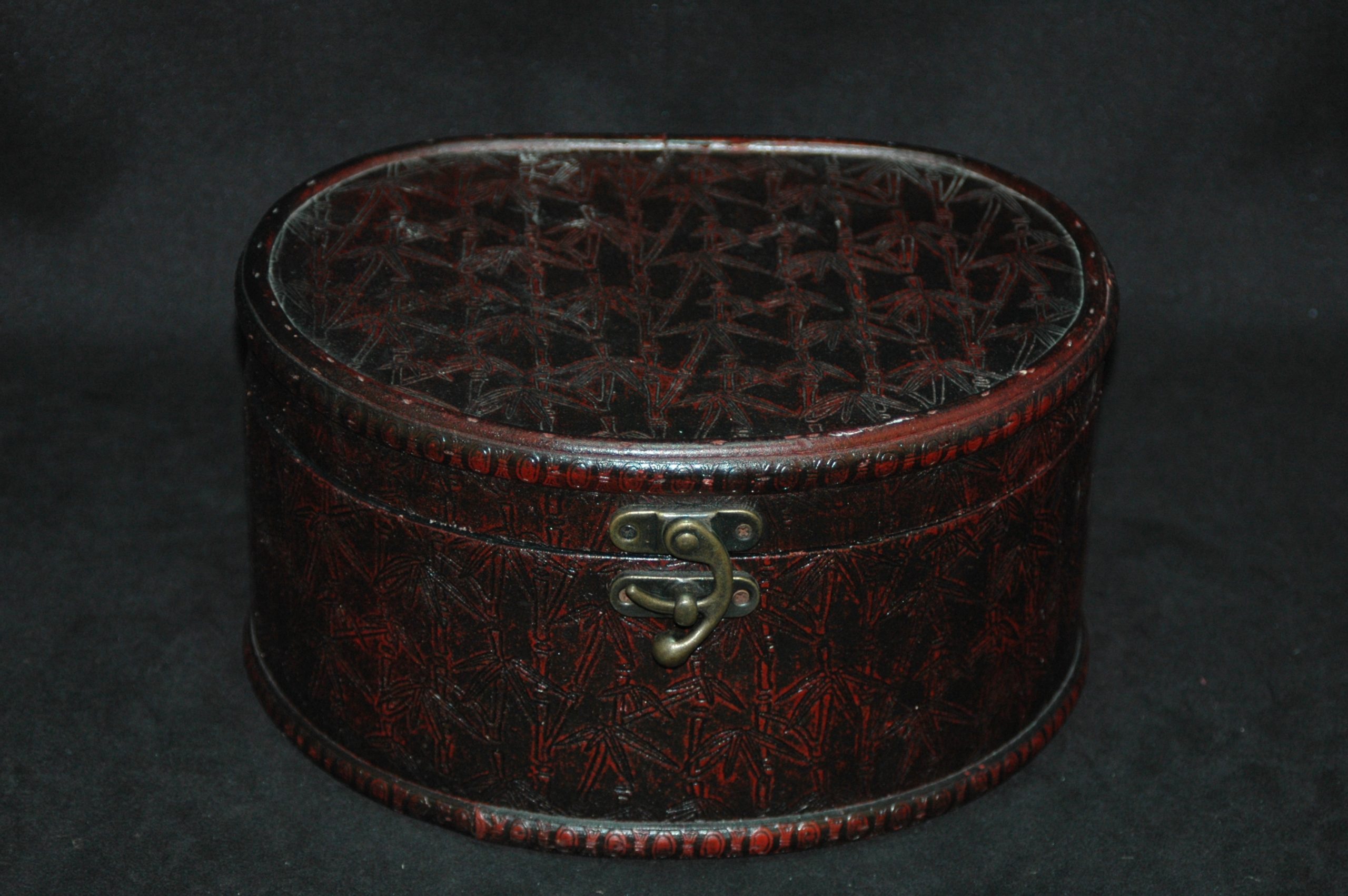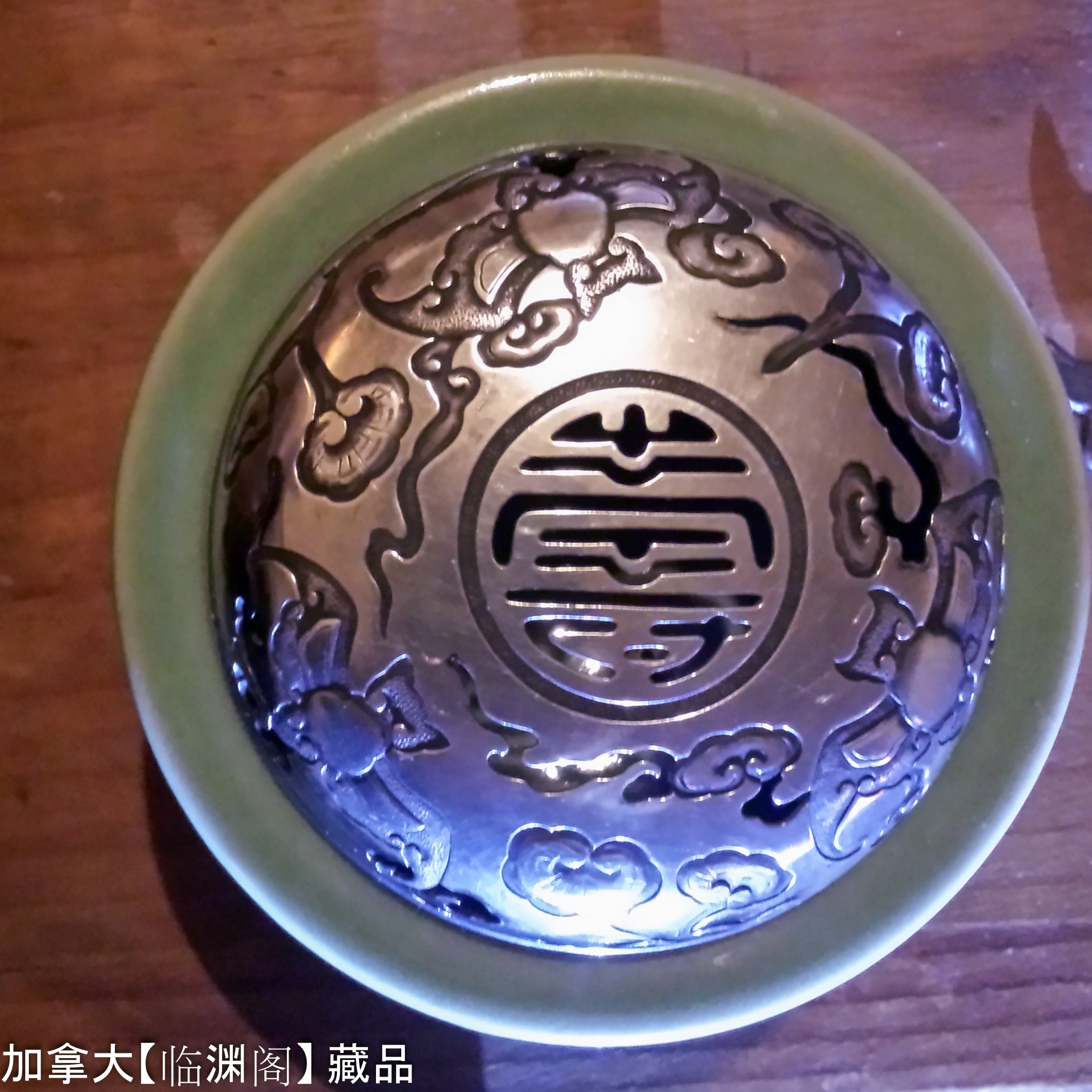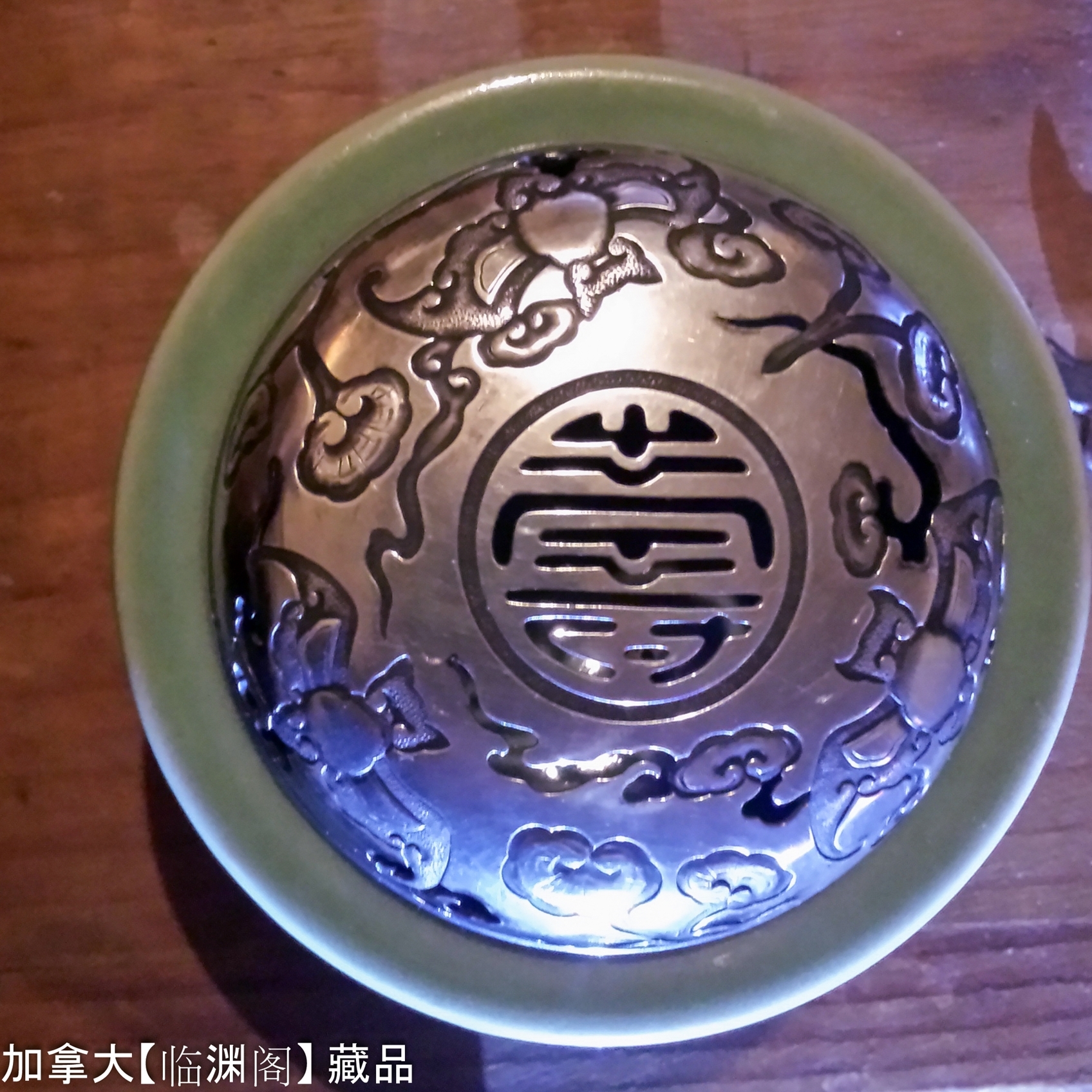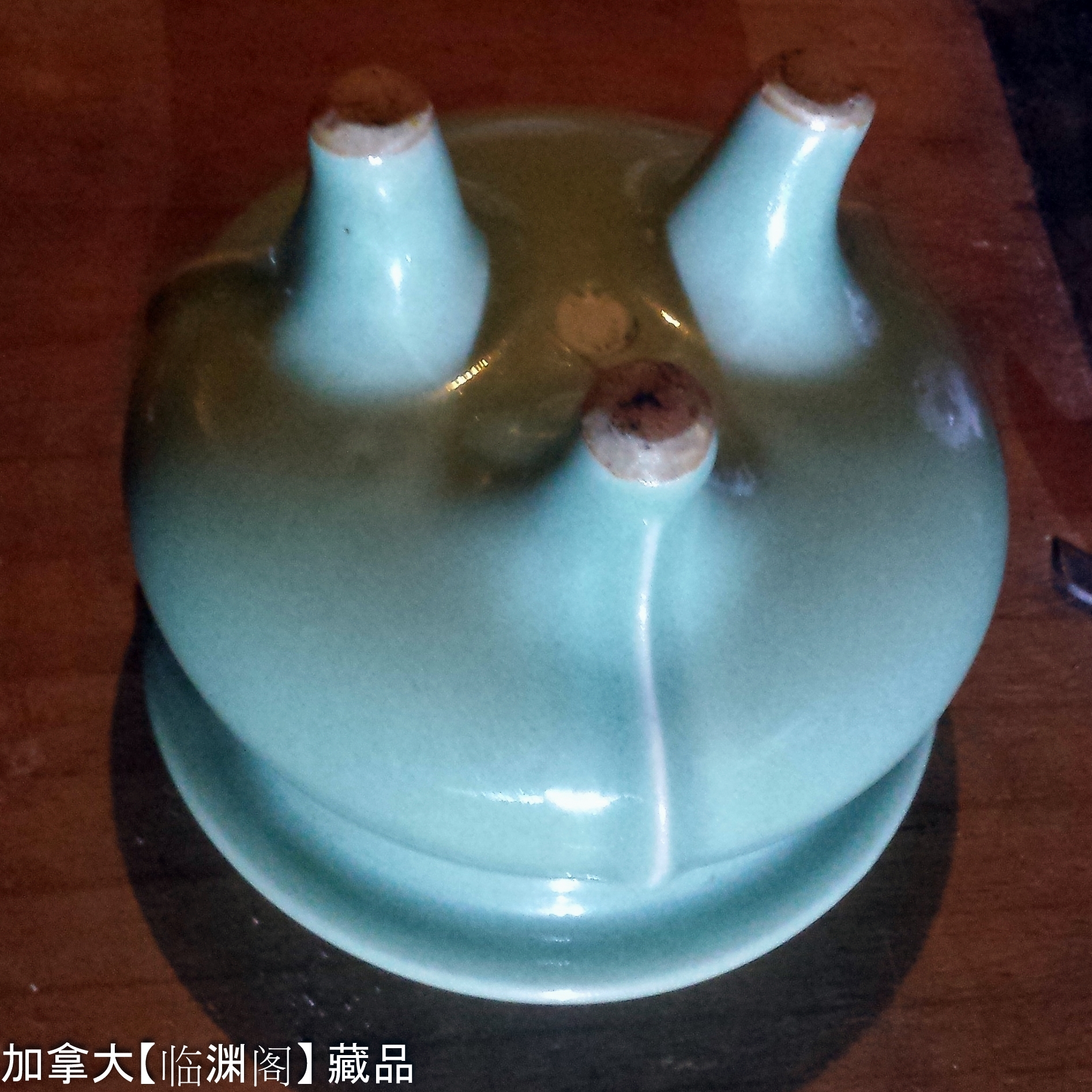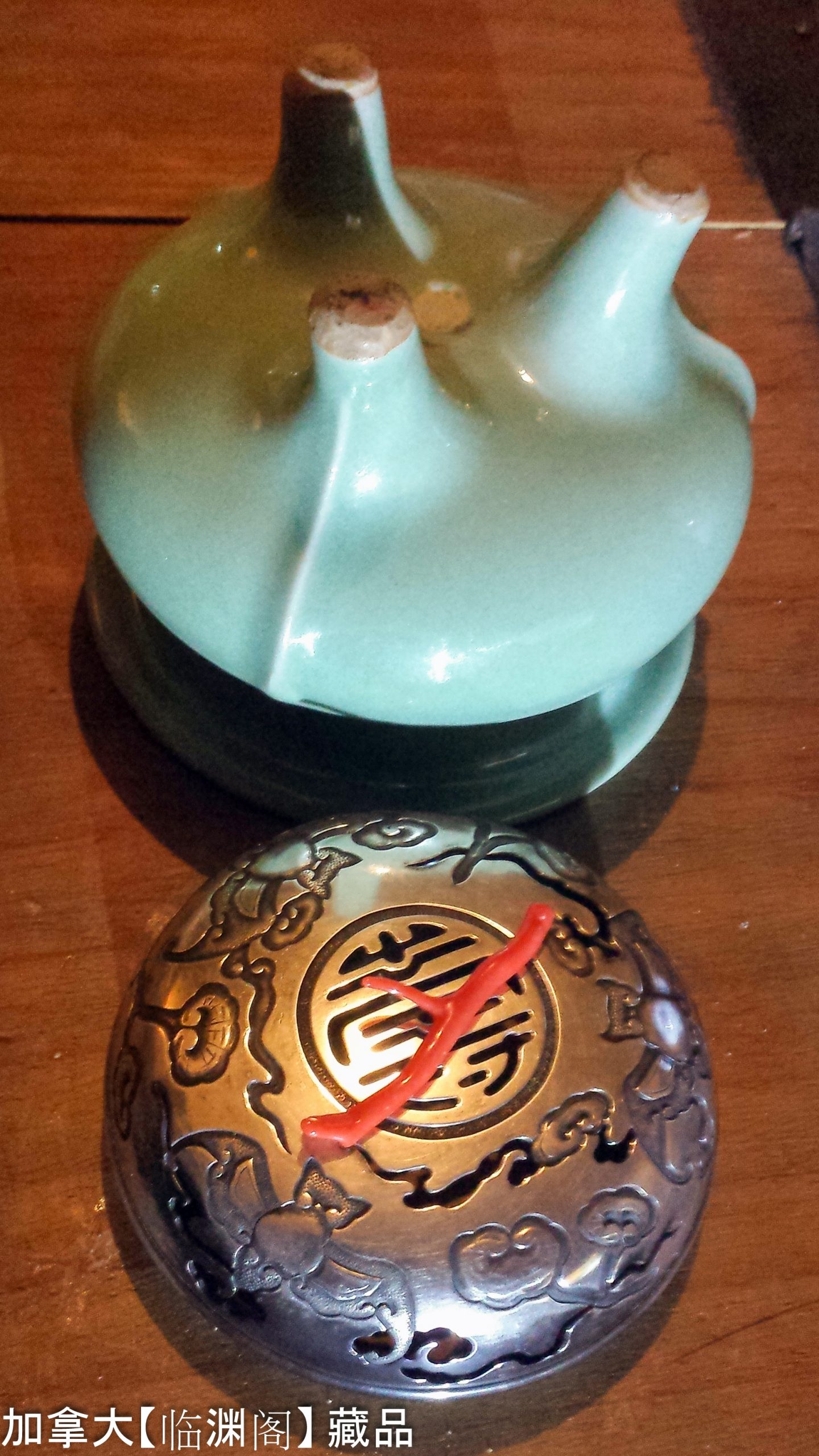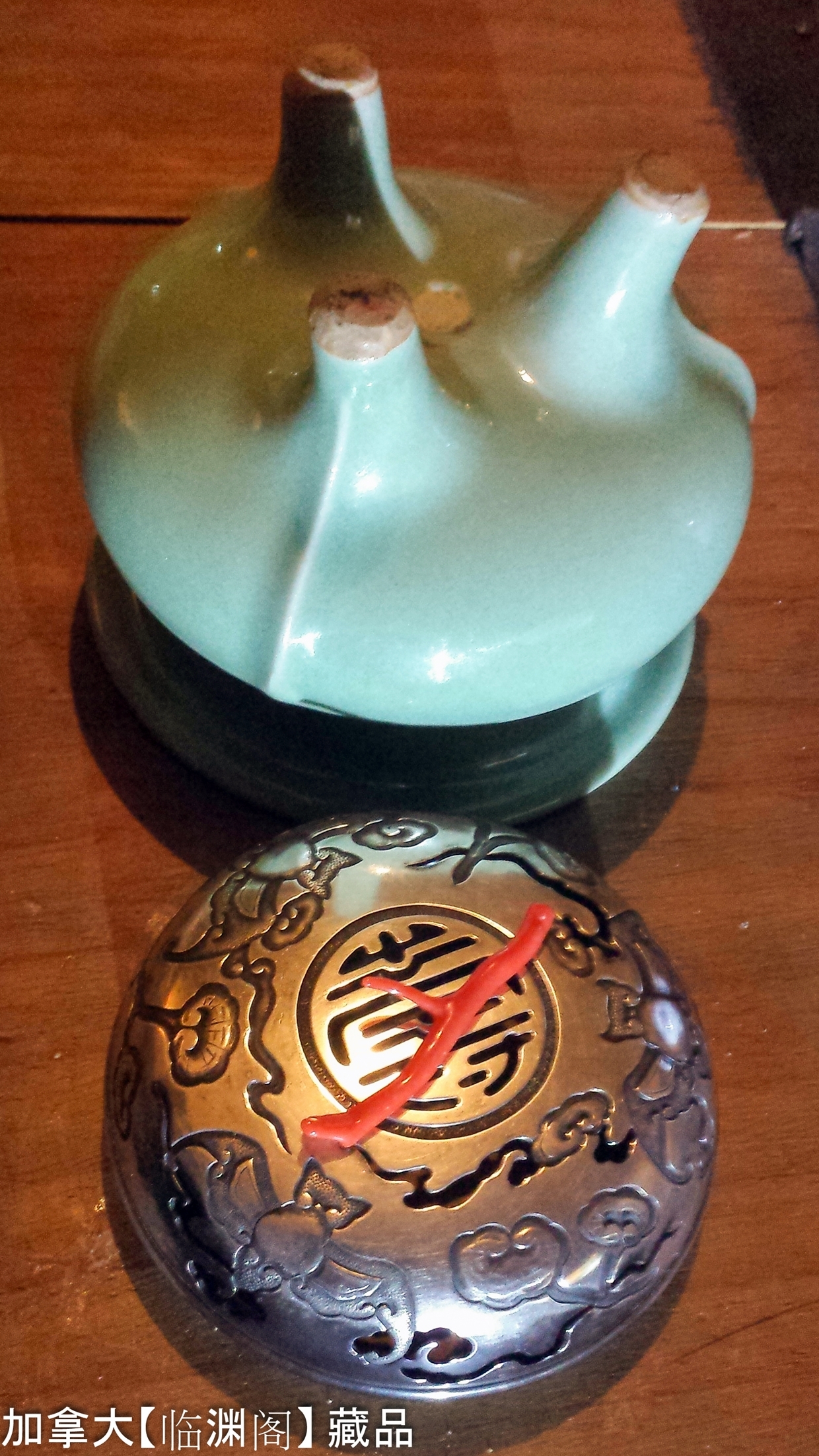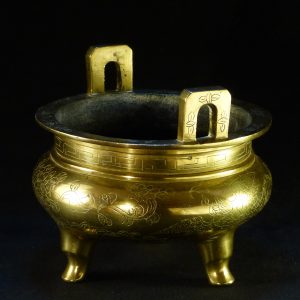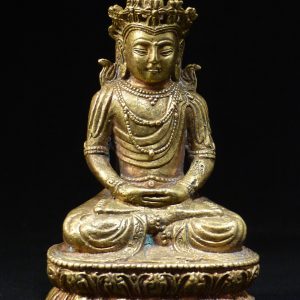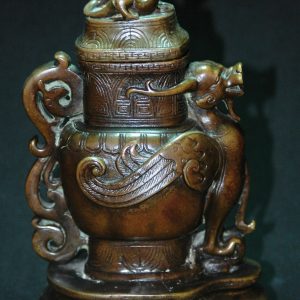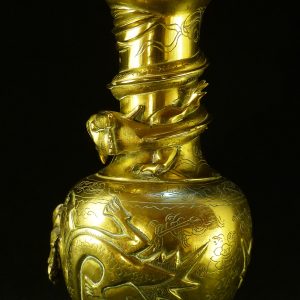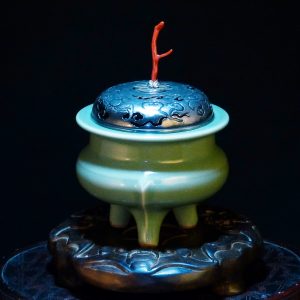Description
南宋 镂空蝙蝠如意寿字银盖 青釉出戟鬲式三足香炉/香薰
参考:苏富比
Important Chinese Art
PROPERTY FROM AN ASIAN PRIVATE COLLECTION
March 22, 01:01 PM PDT
Lot 531 A ‘Longquan’ celadon-glazed tripod censer, Southern Song dynasty
南宋 龍泉窰粉青釉三足爐
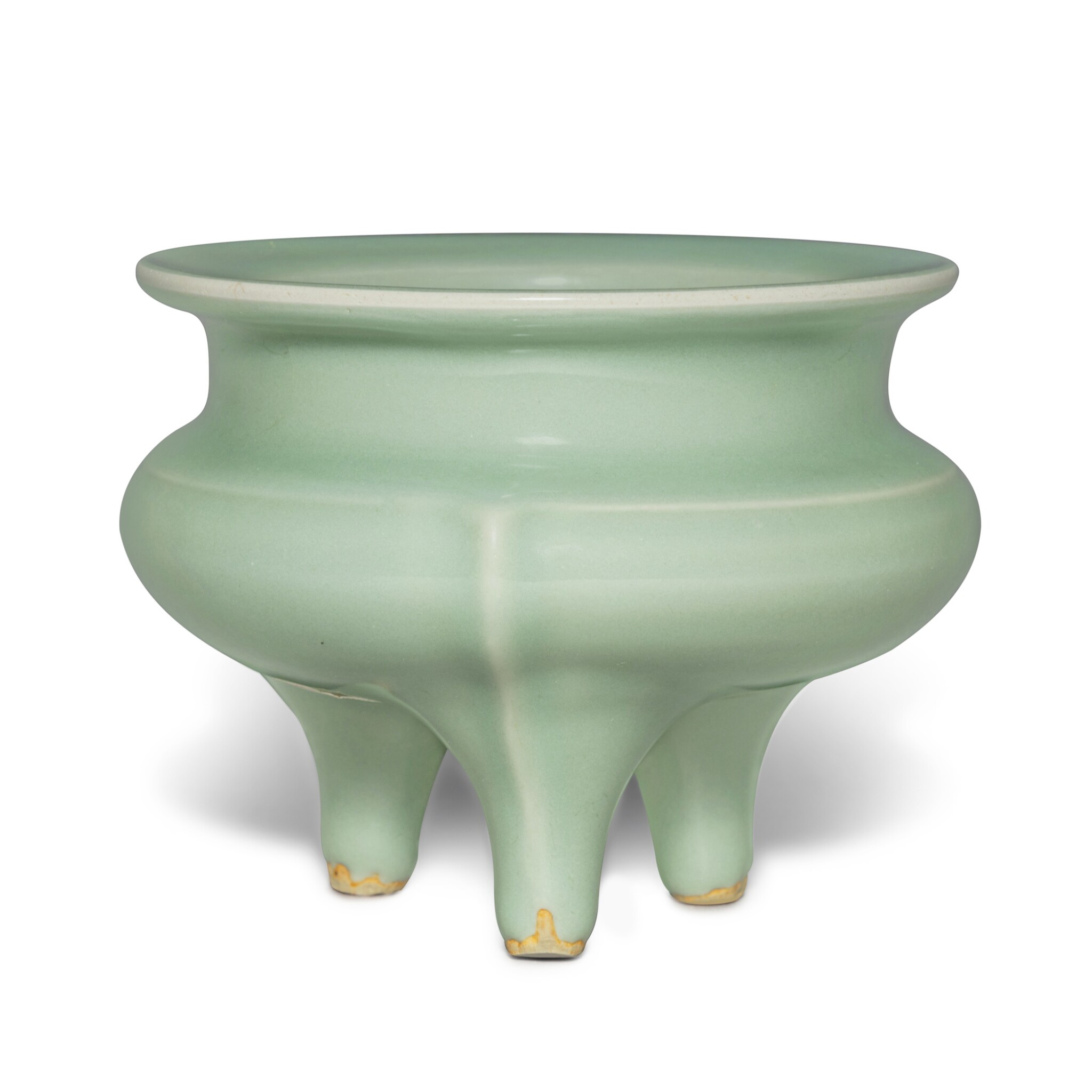
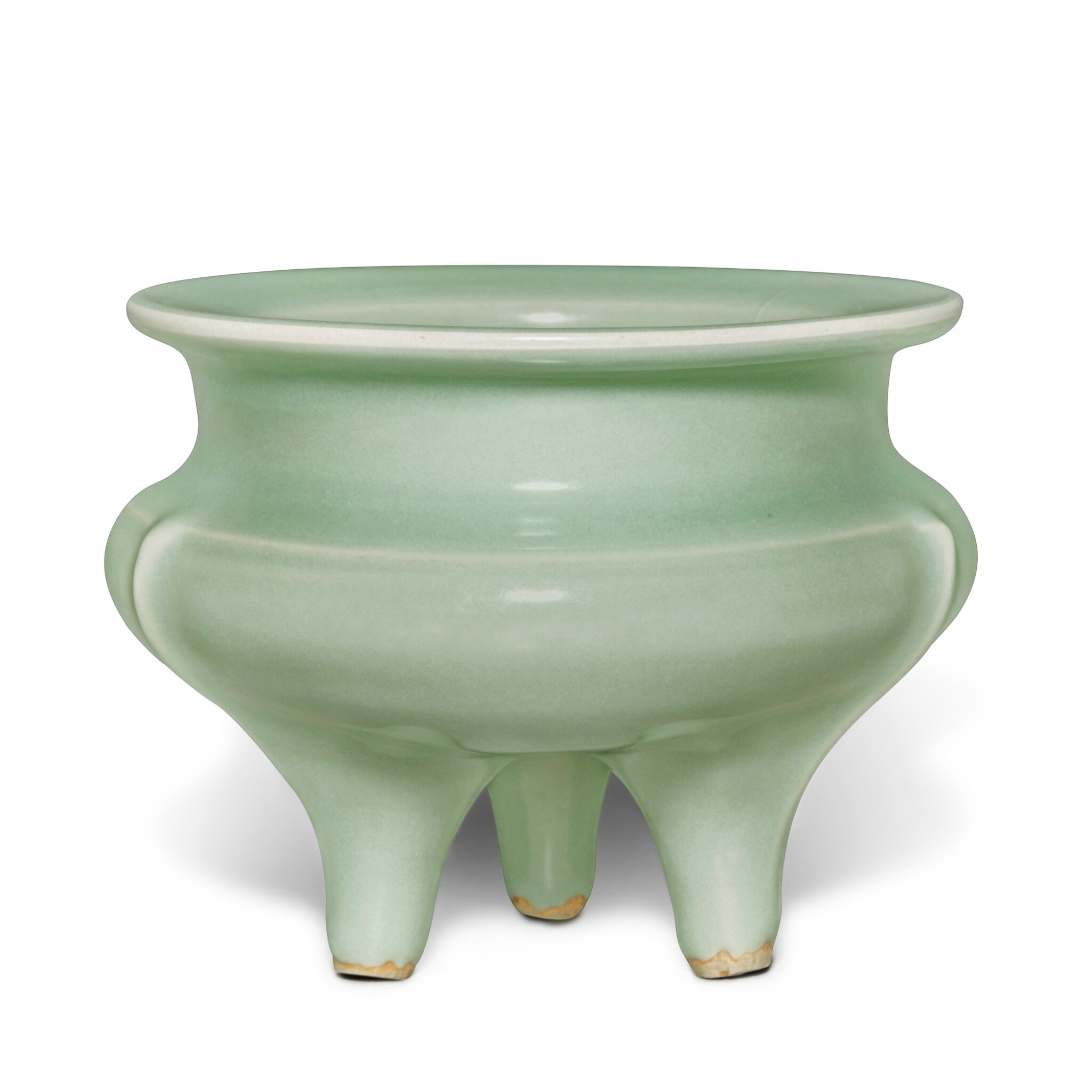
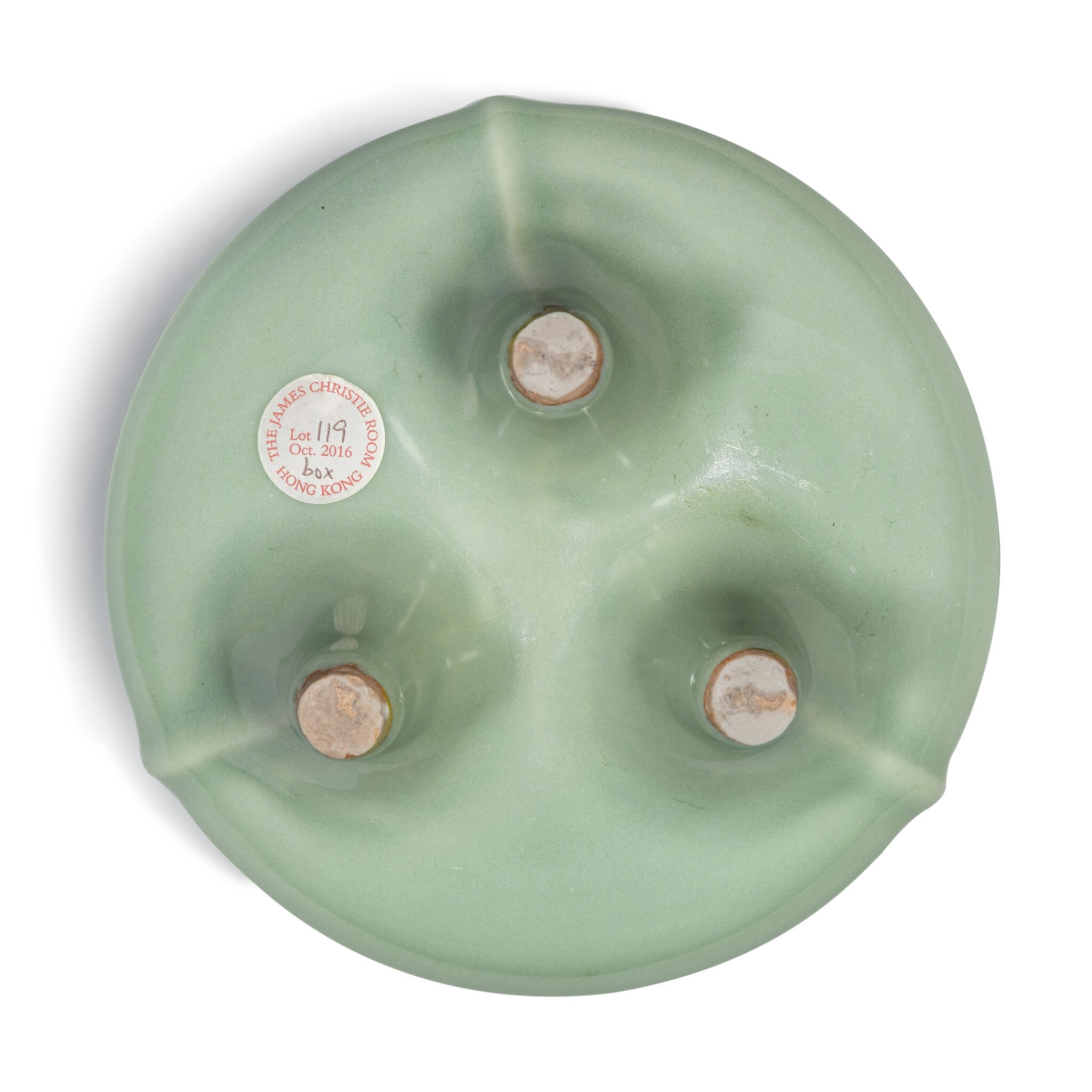
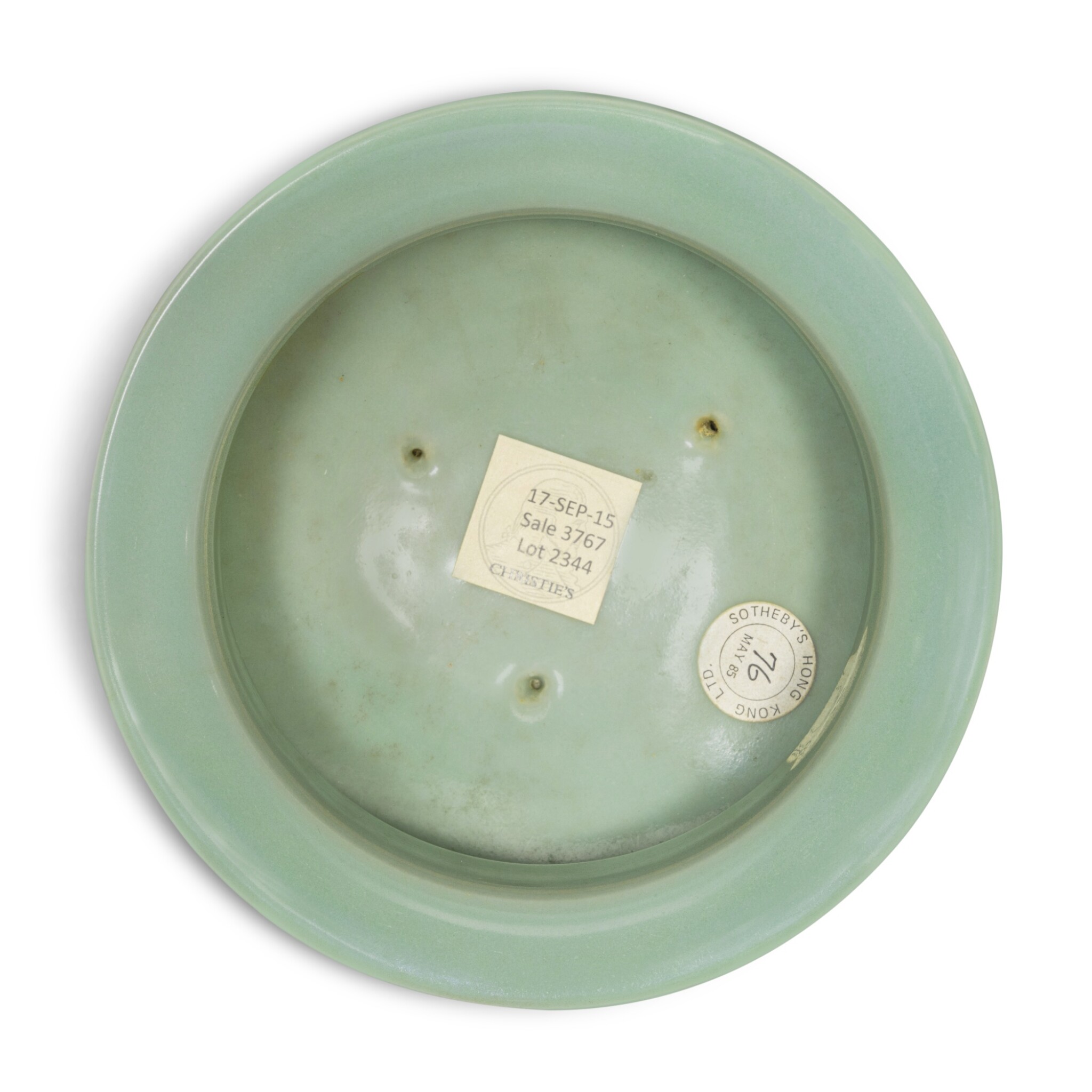
Estimate 80,000 – 120,000 USD
Lot Sold 146,050 USD
A ‘Longquan’ celadon-glazed tripod censer
Southern Song dynasty
南宋 龍泉窰粉青釉三足爐
Diameter 5⅜ in., 13.7 cm
Condition Report
In overall good condition except for an approx. 3.5 cm long faint hairline crack to the rim. Some expected minor wear and firing imperfections, including a minute possible kiln flake to one foot rim.
整體品相良好。口沿見一道約3.5公分長微細沖線。見些許正常輕微磨損及窰燒瑕疵,包括一足內沿見一極微窰磕。
Provenance
Sotheby’s Hong Kong, 21st-22nd May 1985, lot 76.
Muwentang Collection.
Sotheby’s London, 12th November 2003, lot 90.
Asian Private Collection.
Christie’s Hong Kong, 4th October 2016, lot 119.
香港蘇富比1985年5月21至22日,編號76
沐文堂收藏
倫敦蘇富比2003年11月12日,編號90
亞洲私人收藏
香港佳士得2016年10月4日,編號119
Exhibited
Song Ceramics from the Kwan Collection, Hong Kong Museum of Art, Hong Kong, 1994, cat. no. 56.
《關氏所藏宋代陶瓷》,香港藝術館,香港,1994年,編號56
Catalogue Note
The delicate celadon glaze and clear profile of this censer demonstrates the level of artistic and technical refinement achieved at the Longquan kilns during the Southern Song dynasty. Distributed in southern Zhejiang province, these kilns had been producing fine celadon wares in the preceding Northern Song period, although their popularity peaked after the move of the Song capital to Hangzhou. The support of the newly-established Southern Song court and the kilns’ ability to produce very fine wares gave an unprecedented boost to the Longquan kilns. Both the court and scholar-officials that settled in Hangzhou favored wares with seemingly modest forms covered in mesmerizing glazes with a depth of color and tactility that resembled treasured jade. To recreate the jade-like appearance, craftsmen began replacing the traditional lime glaze used for making the celadon tone, with a lime-alkali glaze, which resulted in higher viscosity and softer gloss. The glaze was applied in multiple layers, thus appearing thick and lustrous.
Longquan craftsmen were quick at adapting to the demands of the Southern Song dynasty, whose aesthetic ideals were well-rooted in Neo-Confucian philosophy. Neo-Confucianism gave rise to a centralized bureaucracy governed by scholar-officials selected through civil service examinations. A class of highly educated government officials, who displayed an increasing interest in China’s Bronze Age, thus emerged. This led to a revival of antiquarianism and the study of antiques and history, which were considered a guiding principle in the pursuit of virtue. Potters at manufactories in southern China adopted these principles and introduced archaic forms into their repertoire. The form of the present censer, for example, was inspired by archaic bronze li, food vessels with tri-lobed bodies supported on three legs.
Longquan censers of this form are held in important museums and private collections worldwide: two censers in the Palace Museum, Beijing, are illustrated in The Complete Collection of Treasures of the Palace Museum. Porcelain of the Song Dynasty (II), Hong Kong, 1999, pls 121 and 122; and one in the Tokyo National Museum, is published in Oriental Ceramics. The World’s Great Collections, vol. 1, Tokyo, 1982, pl. 97. For auctioned examples, see one from the collection of Tokiwayama Bunko Foundation, Tokyo, sold in our Hong Kong rooms, 9th October 2020, lot 100.
参考:北京保利拍卖
2023年秋季艺术品拍卖会
佞宋—宋蕴映清晖
5416 明 龙泉窑梅子青釉鬲式炉
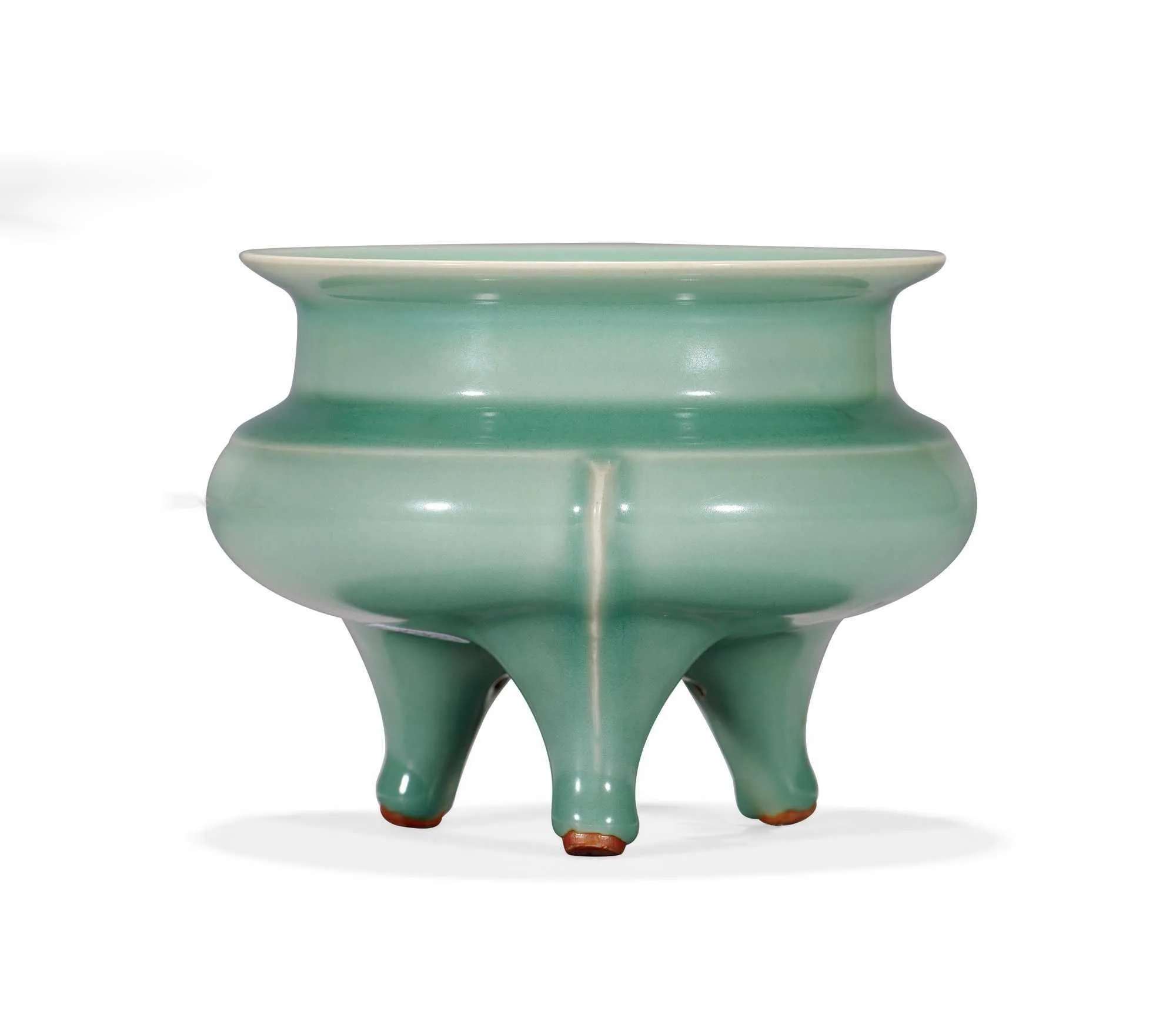
尺寸 高12cm
估价 650,000-850,000
成交价 RMB —
备注
• 伦敦东方陶瓷学会创始人之一Stephen D.Winkworth爵士旧藏 (卒于1938年)
• 卡尔肯普博士(1884-1967年)旧藏
• 2002-2003年购自坂本五郎先生
此件拍品处于保税状态下,具体信息请联系北京保利拍卖中国古董珍玩部工作人员。
此炉板沿口,束颈丰肩,圆鼓腹,下承分档三足,肩部及腹部对应三足出筋,造型仿自商周青铜鬲,造型古朴。
相似的龙泉青釉鬲式炉,见藏于世界各大博物馆及重要私人收藏之中:北京故宫博物院藏二例,刊于《故宫博物院藏文物珍品全集.两宋瓷器(下)》,香港,1996年,卷2,图版121、122;东京国立博物馆藏一例,录于《东洋陶磁大观》,卷1,东京,1982年,图版97;台北国立故宫博物院藏一件相类鬲式炉,断为官窑,录于《故宫藏瓷:南宋官窑》,香港,1962年,图版19;并参考郊坛下遗址一件,经修复后录于《南宋官窑》,北京,1996年,图版XX,编号2。
香港苏富比曾出售相似二例,其一售于2020年10月9日,编号0100,来源于东京常盘山文库收藏,成交价为598万HKD;其二售于“凝盈一色”专场,编号0117,来源于艾弗瑞克拉克伉俪旧藏,其成交价为677万HKD。本品来源于伦敦东方陶瓷学会创始人之一Stephen D.Winkworth爵士旧藏(卒于1938年),后为知名藏家卡尔•坎普博士(1884-1967年)旧藏,在2002-2003年间购自坂本五郎先生。
坂本五郎藏南宋龙泉窑鬲式炉
Sabrina Rastelli 荣思彬
“纯粹如美玉,为世所贵,即官窑之类。”陆深(1477-1544)在《春雨堂随笔》中如此形容章生二掌烧之青瓷,与其兄长章生一主烧之“哥窑”进行对比。尽管几乎可以肯定章氏兄弟的故事为虚构(在陆深1539年发表的随笔之前,中文文献中对此并无记载;参见秦大树,“宋元名瓷哥窑的探索、研究与新发现”,《博物院》,2017年01期,页码93-110;Sabrina Rastelli, ‘The polyhedral and elusive nature of Geyao’, Annali di Ca’ Foscari Serie Orientale 57, 605-626. DOI 10.30687/AnnOr/2385-3042/2021/01/022),却也蕴含一定的真理,描述了某类龙泉窑器物的特点,釉色柔和润泽,呈淡青绿色,使人联想到玉的肌理质感,釉下胎体光滑,呈浅灰色。这一特定种类的烧制持续到12世纪末或13世纪初,直到龙泉窑的陶工彻底改变烧造青瓷的方法。在此之前,龙泉窑烧造青瓷时,仿效的是越窑和耀州窑的传统,即胎呈灰色,器身刻划纹饰,釉色清透呈灰绿,类青柠色。该地区发现的白色瓷石并未促使当地陶工烧造白瓷——而邻省江西饶州(景德镇)的陶工,在10世纪时创烧了后来的青白瓷。在发展出独门的青瓷烧造方法之前,龙泉的陶工将制瓷原料与铁含量高的粘土(紫金土)混合。明明拥有现成的浅色烧制原料,却不利用它们研制白瓷,甚至还用铁含量高的粘土来加深颜色,这似乎并不符合逻辑。然而,有必要强调的是,龙泉地区的瓷石含有某种铁元素,无法烧制成纯白色的胎体。13世纪之际研发出的一种新型烧制方法,充分利用了这种高品质原料,开始单独使用瓷石,或是掺入少量紫金土,作为胎体的配料(现有的科学分析尚不足以就此得出结论;参见柯玫瑰(Rose Kerr)和武德(Nigel Wood)著,《Science and Civilisation in China Volume 5: Chemistry and Chemical Technology, Part 12, Ceramic Technology》,剑桥大学出版社,2004年,页码249-258和574-581)。为了尽可能强调青色釉,釉下胎体最好不是纯白色,因此,这种有所掺杂的龙泉白瓷料(无论是否混合能加深烧制颜色的黏土)其实是非常理想的。这种方法可以制成光滑的浅灰色胎体——正如这只香炉的胎一样——同一种瓷石也被用作釉层的配料,效果令人惊叹。这些原材料中均含有少量的钛(具有强烈的发黄效果)和铁(在还原性气氛下会呈现绿色,然而在钛的作用下则会变黄),还有大量的钾,釉色呈现一种柔和莹亮,缜密润泽的淡青绿色,色调微微发蓝或发绿,若引用中国鉴赏家们青睐的术语,则称之为粉青和梅子青。这些龙泉窑的釉色具有玉质,也是由于其肥厚感,这是通过多个釉层垂流堆叠实现的效果,而后才将器物置于龙窑中烧制,烧制温度为1230摄氏度。
1138年,南宋定都临安(今杭州,位于龙泉以北350公里),并于1149年开设“官窑”,服务于宫廷,窑口临近皇宫,由修内司主管。后又于都城外围的郊坛下设第二处官窑。官窑器釉色发蓝,清透莹润,并有开片,风靡一时,或许这引得龙泉陶工纷纷效仿,并取得了惊人的效果。龙泉的工匠们研发了两种上好的青瓷:一种胎薄泛黑,釉色清透发蓝,釉面时有开片,基本与官窑器一致;另一种胎厚而呈浅灰,釉色似玉,呈现淡蓝或淡绿的色泽。可能是由于修内司官窑和郊坛下官窑无法满足宫廷的需求量,所以皇家在龙泉定烧这种官窑式瓷器,以供给宫廷,也有可能这些瓷器是为了在私有市场出售而烧制,学者们至今未能就此达成一致。但是可以肯定的是,两种青瓷均极富美感,满足了精致讲究的客户群体高雅的审美,比如士大夫。
这件香炉的器型,源于西周时期(公元前1045-前770)的青铜器型——鬲。鬲是一种炊器,特点是器身延伸而出中空圆鼓的三瓣结构,下承三尖足;宽口沿上通常设二耳。这种器型早在新石器时代便已存在,本为陶制。在二里岗时期(约公元前16-前14世纪),青铜鬲被列为组合礼器;随着时间(和地点)推移,鬲的器型比例逐渐改变,在西周时期,双耳已然消失。其功能也产生了变化:从炊粥器变为了盛贮肉类的容器。
仿青铜礼器的陶瓷器型并非新奇之事,然而在宋代,在新儒家政治思想的影响之下,这种实践达到了新的高度。宋代帝王并不自比于汉(公元前206-前220)唐(618-907)先贤,而是致力于复古三代,以巩固皇权,他们自视为古代圣明君主,以正直英明确保天下太平和社会秩序。在这个背景下,古代青铜器备受尊崇(Sabrina Rastelli, ‘The mechanics of change: the aesthetics of Chinese ceramics in the Northern Song (960-1127) and early Jin (1127-1234) dynasties’,收录于Marcello Ghilardi和Hans-Georg Moeller编,《The Bloomsbury research handbook of Chinese Aesthetics and Philosophy of Art》,Bloomsbury Academic,2021年,页码213-240),也就不足为奇了。学识渊博的精英阶层也钟情(如果不至于推崇)古代历史和古器,这些文人通过科举考试参与治理国家,同时又渴望自成一个社会群体,与帝王有所不同。11世纪时,他们加强了私下搜集、探究古器的力度,编撰并发表带有注释的集录,里面包含器物和金文拓片的详细插图。最著名的便是吕大临(约1042-1090)著录的《考古图》,于1092年成书,包括来自不同收藏的200余件青铜器和13件玉器,还有由宋徽宗(1100-1125年在位)敕撰、王黼(1079-1126)编纂的《宣和博古图》,记录了839件器物,包括北宋时期出土的青铜器。宫廷中收藏青铜器的风潮达到了顶峰,宋徽宗改革礼乐制度,并依宫廷所藏古代青铜器的式样铸造新乐器,以此确保正确规范的仪式流程(Patricia Buckley Ebrey,《Accumulating Culture: The Collections of Emperor Huizong》,西雅图和伦敦:华盛顿大学出版社,2008年;Ronald Egan,《The problem of Beauty: Aesthetic Thought and Pursuits in Northern Song Dynasty China》,麻省剑桥和伦敦:哈佛大学亚洲中心,2006年)。
宫廷和文人阶级对古代青铜器显露的兴趣影响了陶瓷的器型和纹饰,出现了礼器的器型和金属器纹样。人们并不收藏陶瓷,因其并非古器;然而,陶瓷被用于日常生活的方方面面,尽管士大夫追求学术和德行,但他们必然不会拒绝美的事物。而且,为了彰显他们独特的身份,品味生活便很重要,而每一个活动(例如品茗)都需要特定的成套器具,包括陶瓷制品(Sabrina Rastelli, ‘The mechanics of change: the aesthetics of Chinese ceramics in the Northern Song (960-1127) and early Jin (1127-1234) dynasties’,收录于Marcello Ghilardi和Hans-Georg Moeller编,《The Bloomsbury research handbook of Chinese Aesthetics and Philosophy of Art》,Bloomsbury Academic, 2021年,页码213-240)。
像这样的龙泉香炉,用于陈设在私家神坛和文人书案上,它具有双重功能,既能散发香气,又能证明主人的精致品味,不仅是精于鉴赏陶瓷,最重要的是精通古代青铜器和仪式规范。
这类龙泉窑既向东出口至朝鲜半岛和日本(1323年沉没于朝鲜半岛沿海的新安沉船便可表明),也向西出口至整个亚洲、中东甚至非洲,但是没有任何一个(中国以外的)地方比日本更欣赏这些器物。1173年,日本与南宋建立了正式的外交关系,在后来的镰仓时代(1185-1333),两国之间交易货物(茶叶、丝绸、漆器、陶瓷),还互相交流习俗和思想。1211年,佛教僧人明庵荣西(1141-1215)在造访中国两次后,撰写了《吃茶养生记》,介绍中国绿茶和饮茶之道,后来发展出了日式茶道。在茶道中,会燃香来营造芬芳的气氛——这种习俗也发展成了一种系统的仪式:香道。日本的精英(无论是佛教僧侣还是武士贵胄)很快便对龙泉窑器物产生了一种特殊的偏爱,欣赏其柔和润泽的青绿釉;在茶道和香道中,具有古代礼器器型的香炉则格外受到钟爱,实际上,很多这类龙泉窑器物从13世纪开始便被世代珍藏。蓑丰和蒋人和在列举出光美术馆馆藏佳器时,提及了被录入重要文化财的那只香炉,保存于镰仓圆觉寺(蓑丰和蒋人和,《Ice and green clouds: traditions of Chinese celadon》,印第安纳波利斯艺术馆,1986年,图录号79)。另有一著名实例,藏于台北故宫博物院。
收录于《故宫藏瓷 – 龙泉窑》,香港,1962年,页码58,图版16)。珀西瓦尔•大维德爵士藏有三件相似例;其中釉面开片的一件(藏品编号PDF 276)收录于《Illustrated Catalogue of Celadon Wares in the Percival David Foundation of Chinese Art》(珀西瓦尔•大维德中国艺术基金会藏青瓷图录,修订版,伦敦,1997年,页码34,编号228),据传为皇家旧藏。
Sabrina Rastelli为意大利威尼斯Ca’Foscari大学中国艺术与考古学教授,自1999年起任教。她在伦敦大学亚非学院获得博士学位。她的研究兴趣包括中国陶瓷的发展、宋代文化、随葬艺术和当代艺术。她是《耀州窑:《重新评价》(2008年)和《中国艺术:从起源到唐朝》(2016年,意大利语)与《马可波罗》系列丛书的主编。
参考:佳士得
23 9月 2021 | 現場拍賣 19547
重要中國瓷器及工藝精品
拍品 721
A SMALL LONGQUAN CELADON TRIPOD CENSER
瓊肯珍藏
南宋 龍泉窯青釉小三足爐
SOUTHERN SONG DYNASTY (1127-1279)
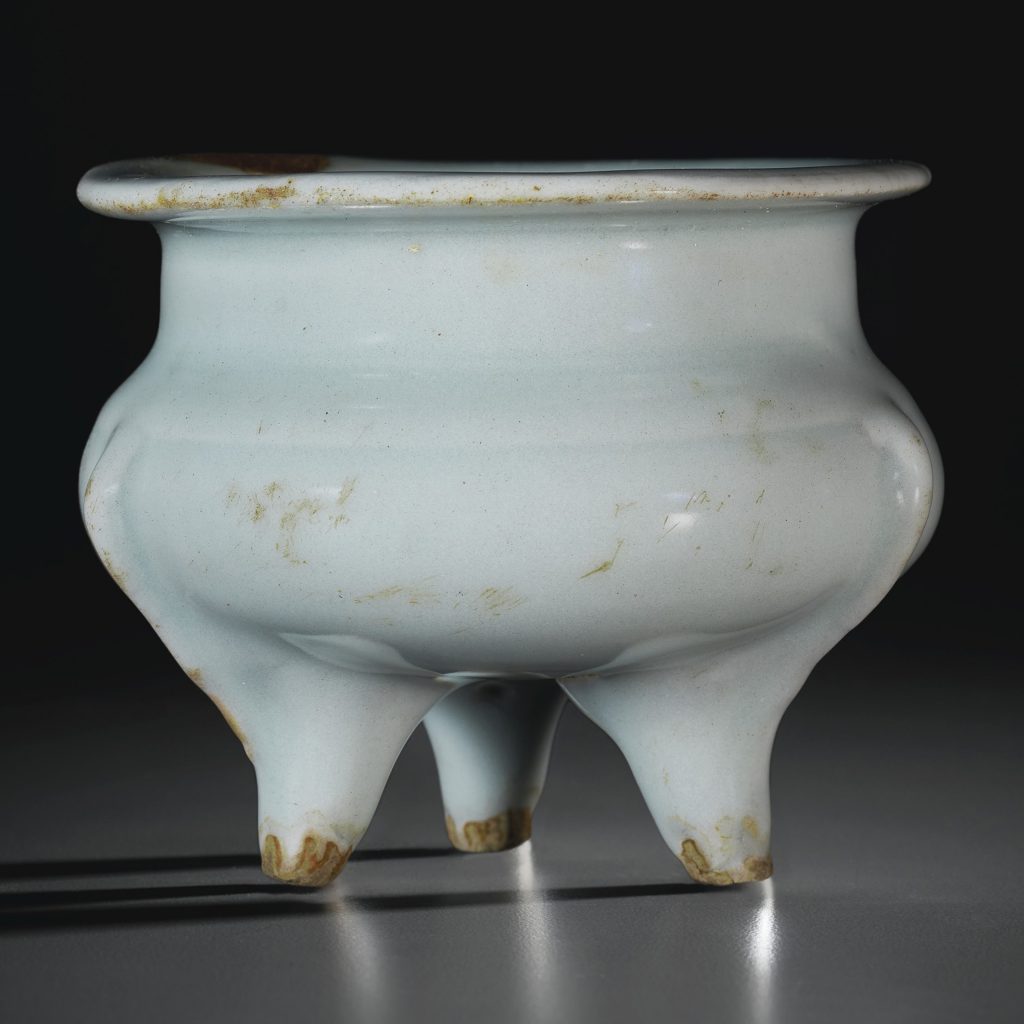
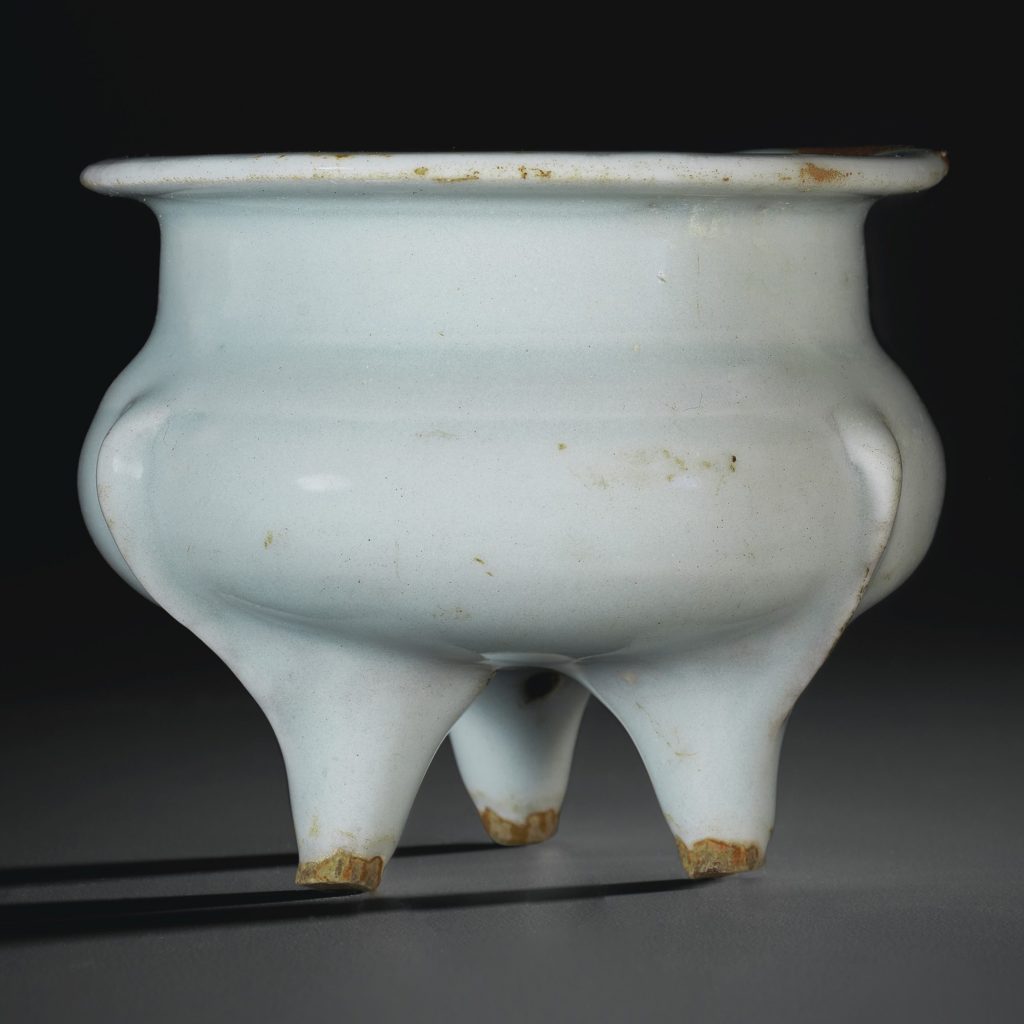
成交價 USD 13,750
估價 USD 8,000 – USD 12,000
南宋 龍泉窯青釉小三足爐
3 ¾ in. (9.5 cm.) diam.
來源
Warren E. Cox & Associates,紐約,1957年。
史蒂芬‧瓊肯三世 (1978年逝) 珍藏。
狀況報告
謹請注意,所有拍品均按「現狀」拍賣,閣下或閣下的專業顧問應於拍賣前親自查看拍品以評鑑拍品之狀況。
– 口部有一區塊經漆及金粉修補
– 口沿及爐側棱脊有磨痕, 表面並有正常磨損
– 兩足與爐身接合處有短燒窯裂紋
– 足底或稍經打磨
参考:佳士得
23 9月 2021 | 現場拍賣 19547
重要中國瓷器及工藝精品
拍品 725
A SMALL CELADON-GLAZED TRIPOD CENSER
瓊肯珍藏
明/清 青釉三足爐
MING-QING DYNASTY (1368-1911)
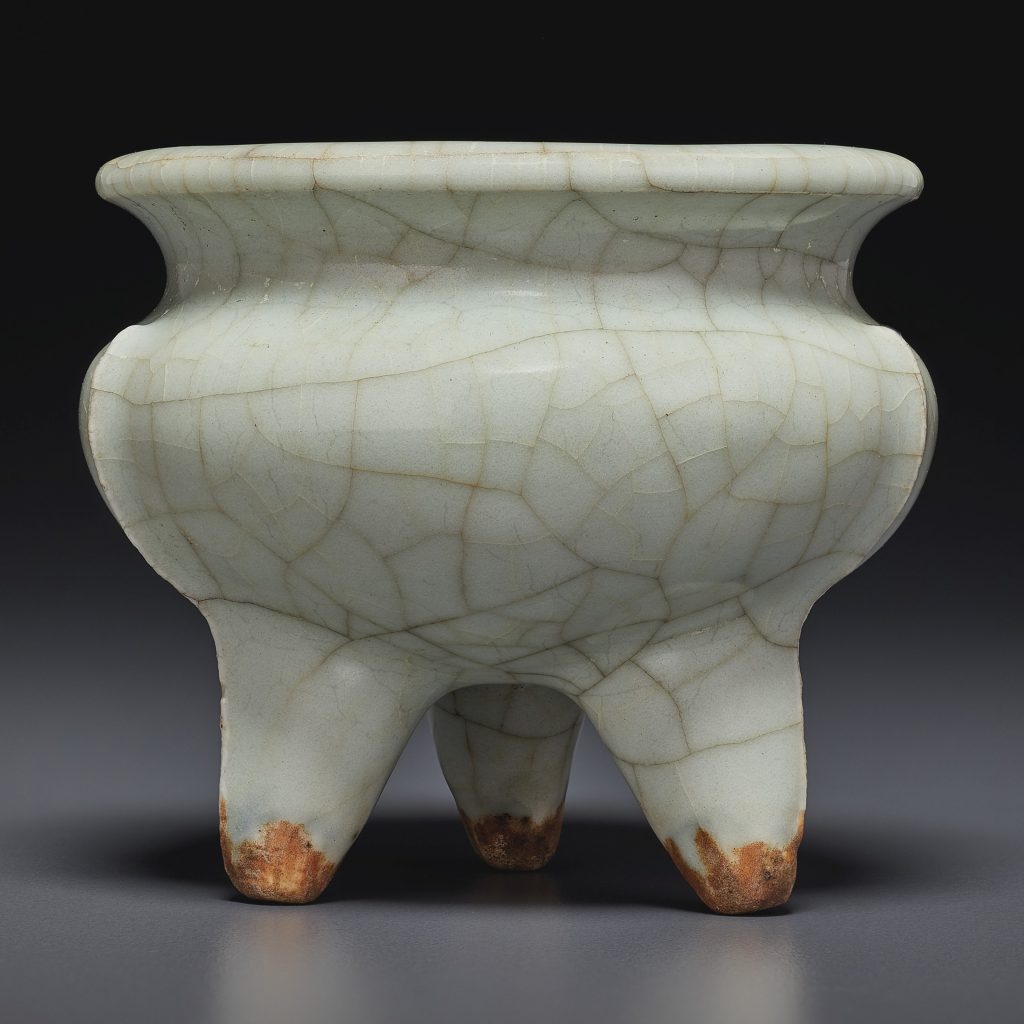
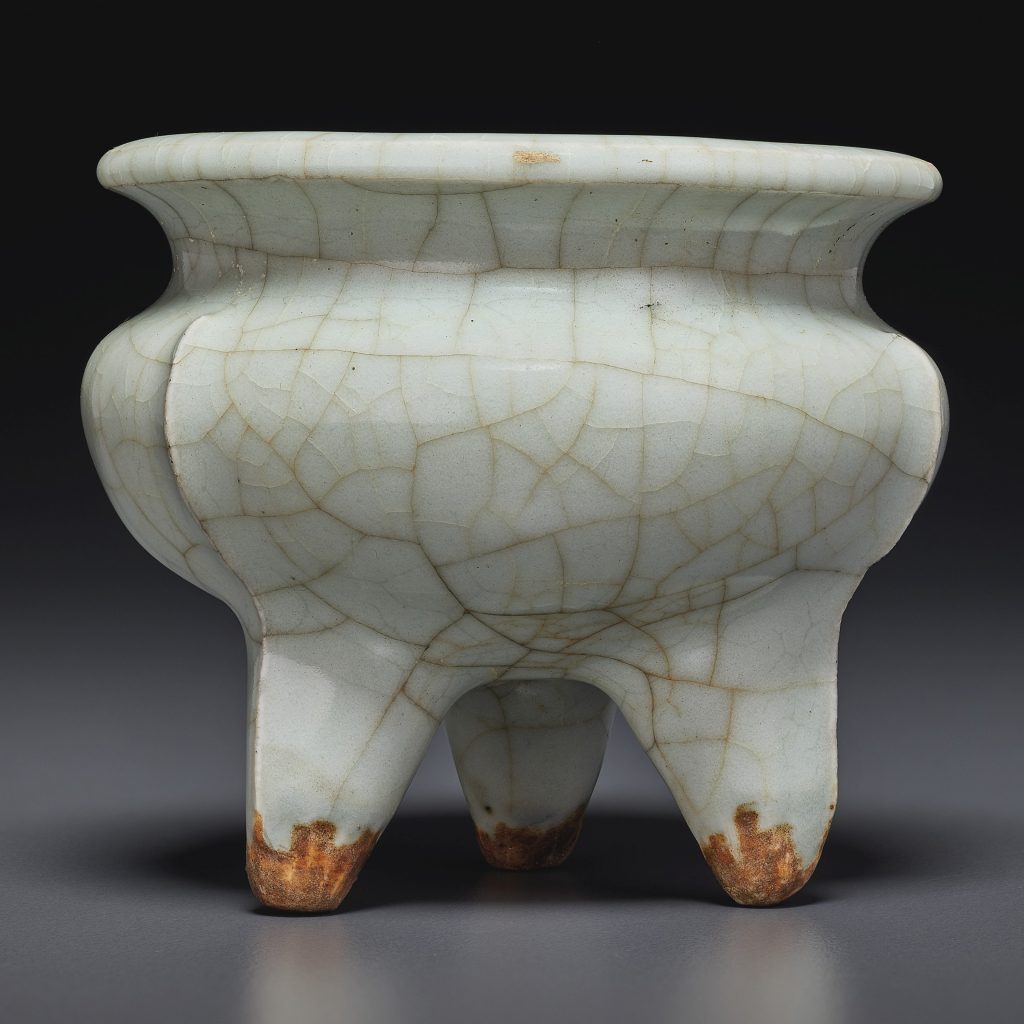
成交價 USD 11,250
估價 USD 8,000 – USD 12,000
明/清 青釉三足爐
3 ¼ in. (8.2 cm.) diam.
來源
史蒂芬‧瓊肯三世 (1978年逝) 珍藏。
狀況報告
謹請注意,所有拍品均按「現狀」拍賣,閣下或閣下的專業顧問應於拍賣前親自查看拍品以評鑑拍品之狀況。
– 口沿有一輕微爆釉
– 邊緣有磨損及有些許其他爆釉
– 如圖錄所見, 有些驚釉
– 足部之底部有正常磨損
参考:佳士得
21 3月 2019 | 現場拍賣 16320
中國瓷器及工藝精品
拍品 1715
A LONGQUAN CELADON TRIPOD CENSER
PROPERTY FROM THE LINYUSHANREN COLLECTION
南宋 龍泉青釉三足爐
SOUTHERN SONG DYNASTY (1127-1279)
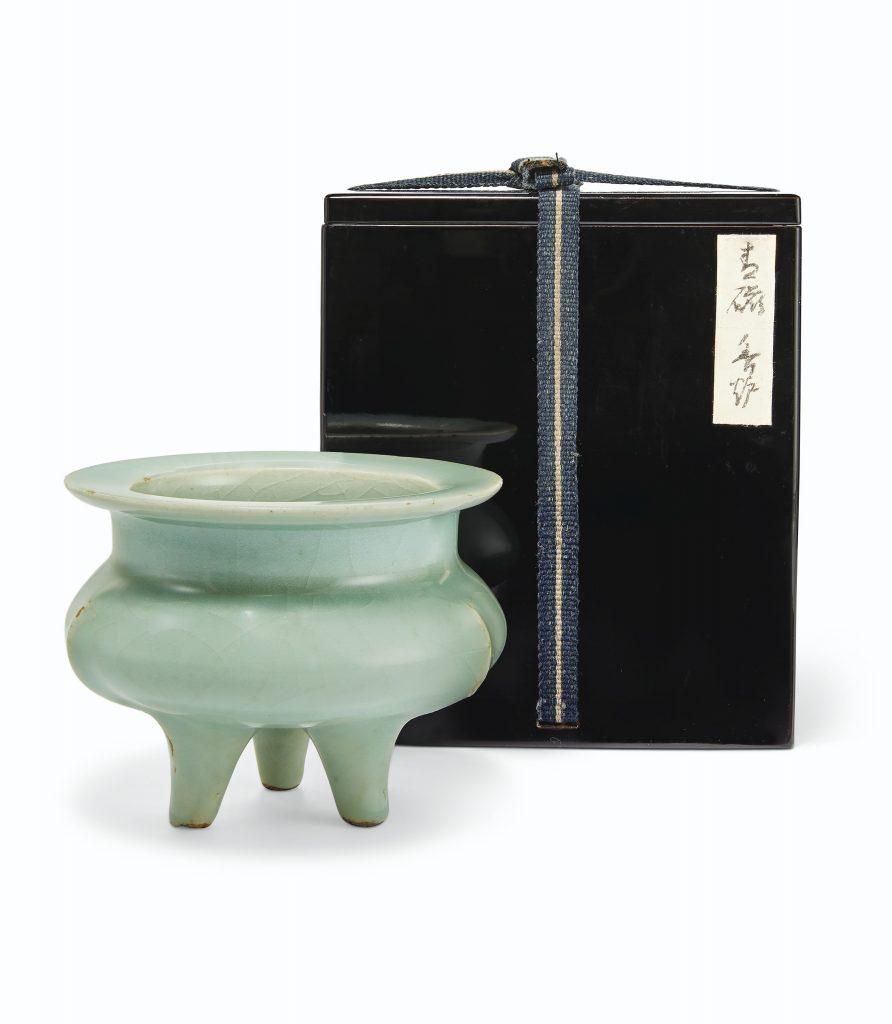
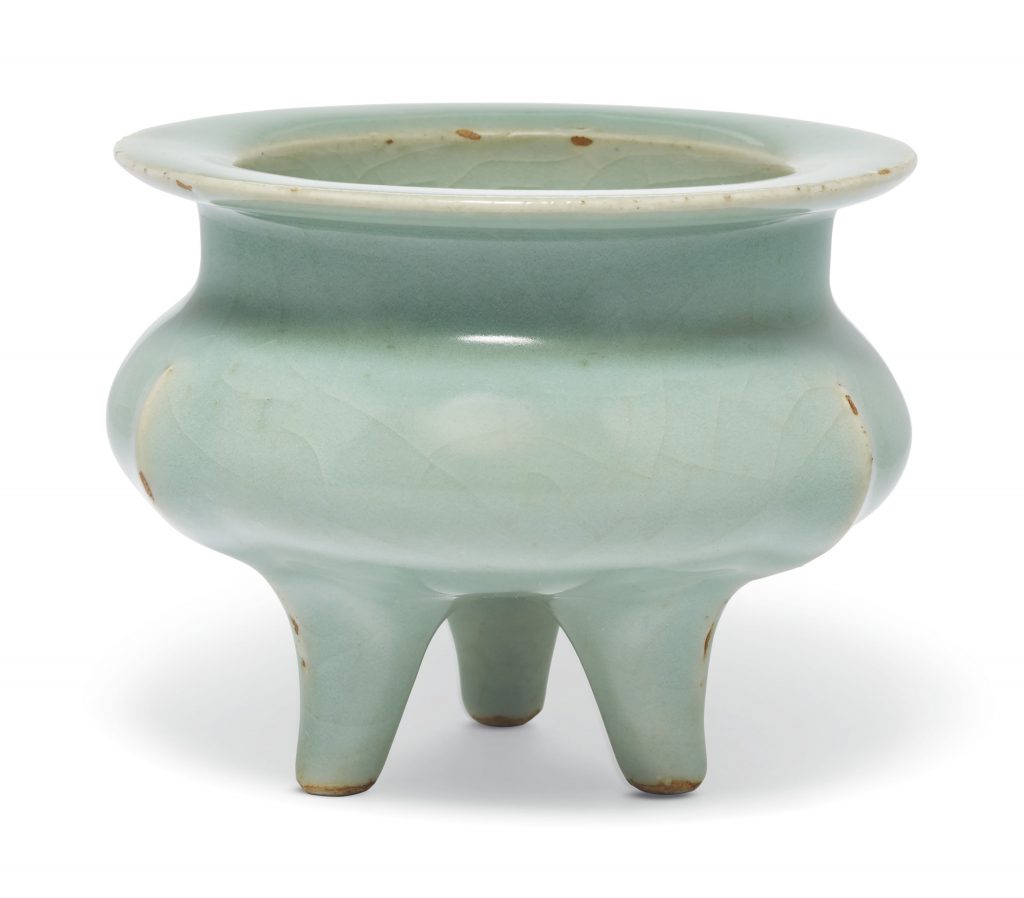
成交價 USD 52,500
估價 USD 10,000 – USD 15,000
南宋 龍泉青釉三足爐
4 ¾ in. (12.2 cm.) diam., Japanese lacquered box
來源
Private collection, Japan.
Sen Shu Tey, Tokyo.
出版
Sen Shu Tey, The Collection of Chinese Art – Special Exhibition ‘Run through 10 years’, Tokyo, 2006, p.60, no.72.
展覽
Tokyo, Sen Shu Tey, The Collection of Chinese Art – Special Exhibition ‘Run through 10 years’, 22 – 23 November 2006.
参考:佳士得
3 10月 2016| 現場拍賣 12557
古今 | 佳士得
拍品 119
A LONGQUAN CELADON TRIPOD CENSER
THE PROPERTY OF A PRIVATE ASIAN COLLECTOR
南宋 龍泉青釉鬲式爐
SOUTHERN SONG DYNASTY (1127-1279)
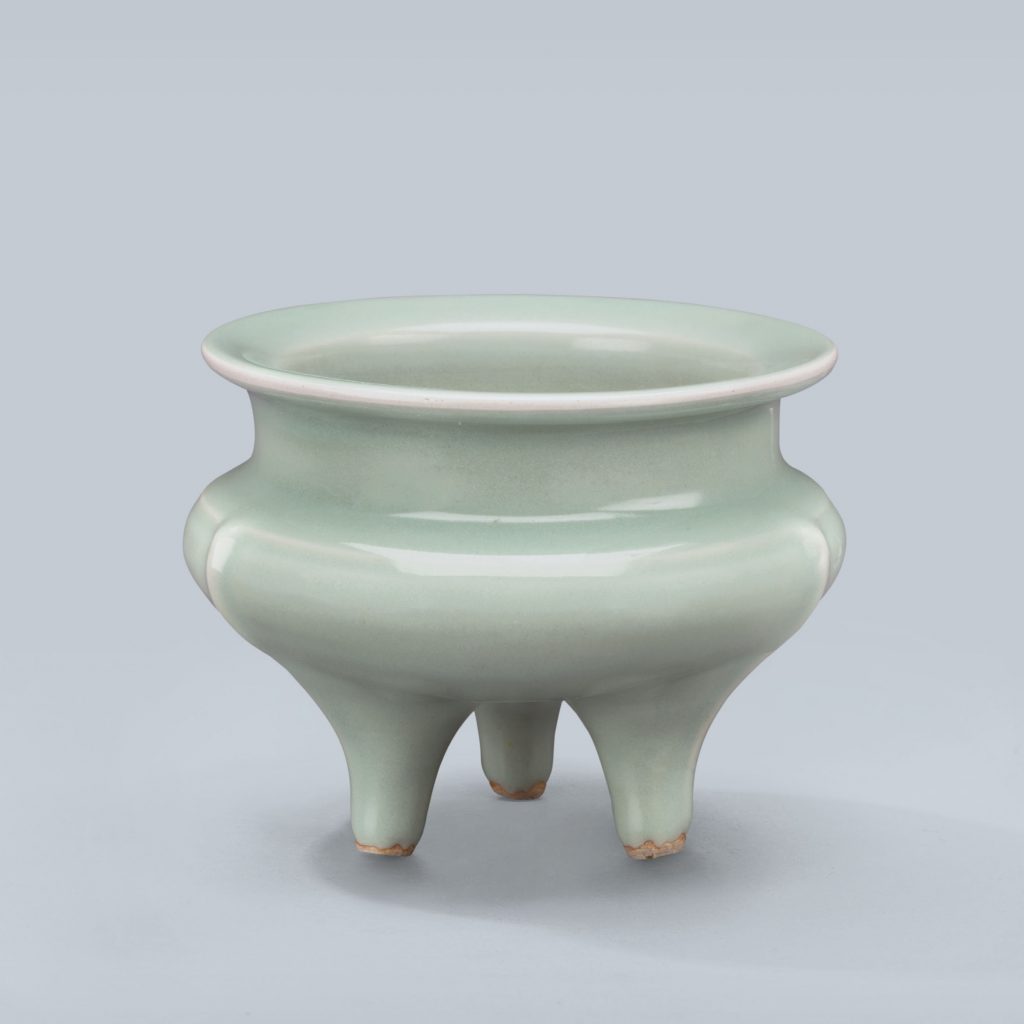
成交價 HKD 750,000
估價 HKD 300,000 – HKD 500,000
南宋 龍泉青釉鬲式爐
SOUTHERN SONG DYNASTY (1127-1279)
5 3/8 in. (13.7 cm.) diam.
來源
香港蘇富比,1985年5月21-22號,拍品76號
關善明珍藏
倫敦蘇富比,2003年11月12日,拍品90號
展覽
香港藝術館,《關氏所藏宋代陶瓷》,1994,圖錄圖版56號
狀況報告
謹請注意,所有拍品均按「現狀」拍賣,閣下或閣下的專業顧問應於拍賣前親自查看拍品以評鑑拍品之狀況。 – 整體品相良好,惟邊沿有些微磕,屬正常現象
– 口沿有一道細沖
– 口邊緣經輕微打磨
– 兩足經輕微打磨
参考:
香的历史可追溯到战国时期
南宋龙泉窑梅子青釉鬲式香炉
香炉是古人用以薰香取暖、除异味、添香气以及书房焚香,后多用于为神佛烧香。出香的历史可追溯到战国时期,汉六朝以后,佛教盛行,以焚香供神佛,寄托人们的情感,因而各种形制的香炉就多了起来。宋代焚香和祭祀的习俗更甚,焚香与烹茶、插花、挂画并列为文人四艺,颇受文人喜爱。此时香炉比较小,以仿古式样的小型香炉最具特色。有的为开敞式,上面不加盖子,有的有盖,宋人日用焚香,都用这一类小型香炉,在宋墓及宋代文化地层中都出土有瓷质的香炉,其样式较多,有鬲式香炉、莲花香炉、球形香炉、奁式香炉、三足香炉等。
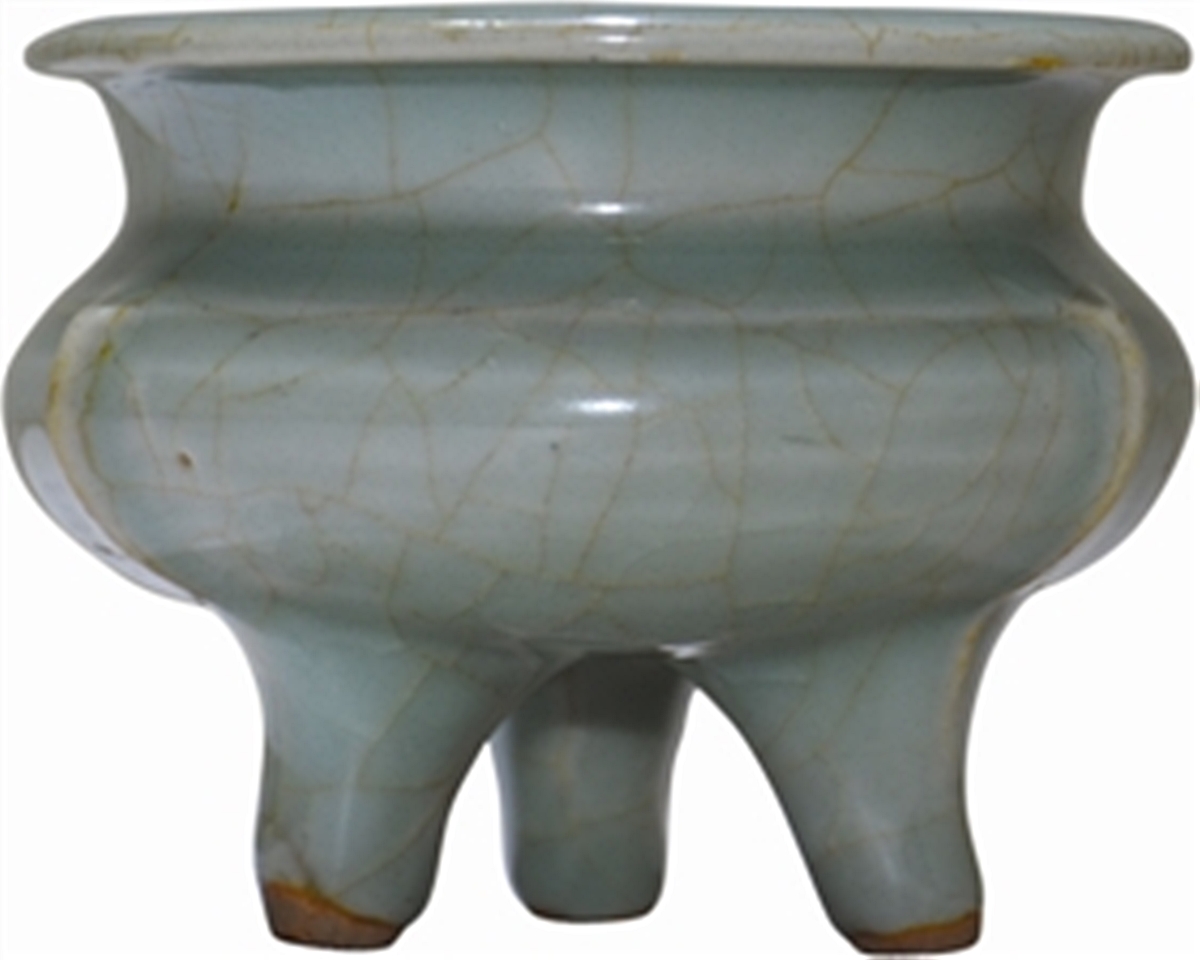
镇江扬中永鑫堂藏南宋龙泉窑梅子青釉鬲式香炉(见图),高6.8厘米,口径8.5厘米。平沿,束颈,扁鼓腹,圆底下承三足。腹部与足面有三角形凸棱线,通常称其为“出筋”,这是烧造过程中釉层积聚厚度的变化而在腹足间显示出“出筋”。“出筋”是南宋龙泉窑装饰特征之一。胎灰白色,全器施梅子青釉,釉层丰厚,釉色如诗中所说:“琢瓷作鼎碧于水”将其形容的浓翠莹润,如青梅色泽,故而得名。此炉的形制是仿古代青铜器的样式烧制,其外形简练,线条曲直有致,肩、腹部及器足凸起的三条棱线,逼真地摹仿了青铜器的构造。
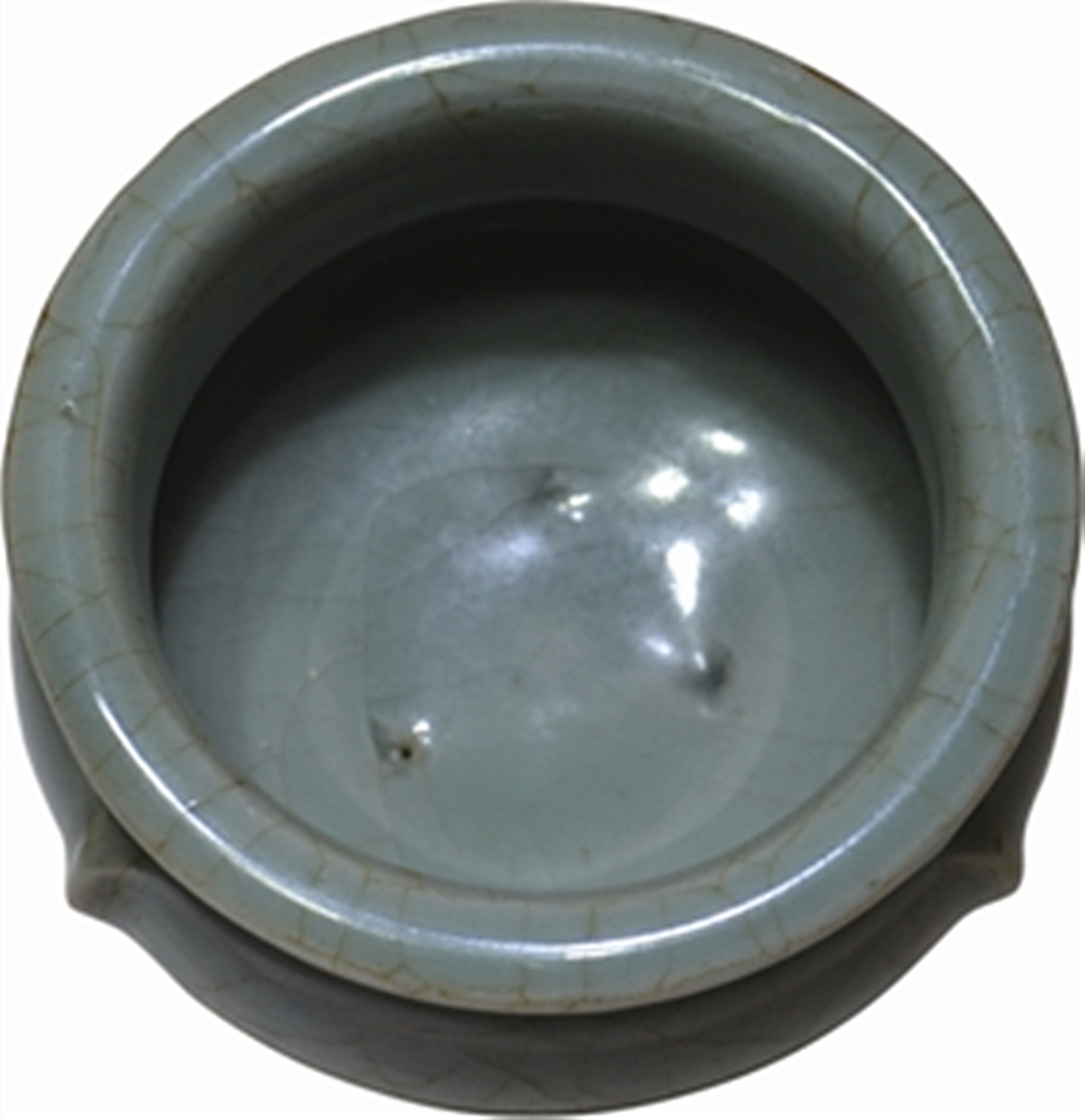
龙泉窑是继越窑之后兴起的又一个重要青釉瓷窑场,形成于北宋早期,衰落于清中期。北宋时期龙泉窑青釉瓷尚保留着越窑、瓯窑和婺州窑的遗风,釉呈浅青或青黄色,釉层薄而透明。南宋为龙泉窑发展时期,产品形成独特的风格。此时由于熟练掌握了胎釉配方,多次上釉技术以及烧成气氛的控制,釉色纯正,釉层加厚,成功地烧成了粉青釉和梅子青釉,达到青釉史上的高峰。南宋时期龙泉窑在釉料的配方中进行创造性改革,将石灰釉改用石灰碱釉,从而打破了传统石灰釉一统天下的局面,这种釉在高温中粘度较大,流动性较小,釉层较厚,1件釉层较厚的瓷器,需要经过三四次的上釉,有的釉厚达到1.5毫米以上。在金村、大窑、溪口等窑址发现的生烧坯和素烧坯标本,胎呈红色较硬,厚厚的没有烧成的釉作乳白色的粉末状,明显地分为三层或四层。这种厚釉的表面光泽显得更加柔和,特别是梅子青和粉青釉,梅子青釉色莹润青翠,犹如青梅。龙泉窑青釉瓷由于釉层较厚,难以透出釉下的刻划纹样,重于器物的造型设计,以此突出釉色之美。如梅子青釉鬲式炉,腹部到足面呈现的“出筋”,既加强了器物的美感,又体现梅子青釉的青翠欲滴之美。
(文章来源:收藏快报 江苏 刘丽文 李荣生)
参考:大英博物馆
British Museum
Museum number:PDF.279
incense-burner
南宋 龙泉冬青釉三足鬲式香爐
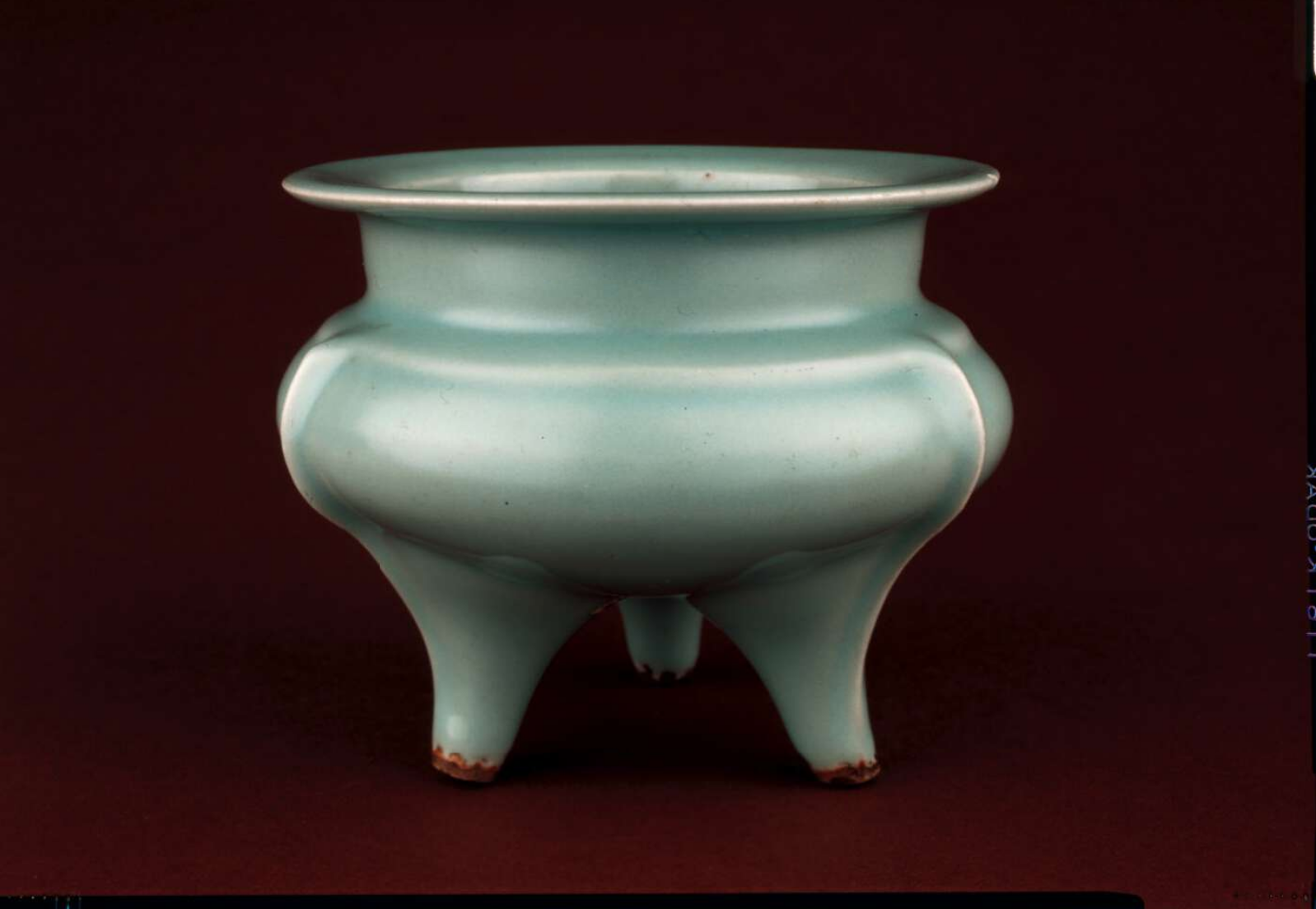
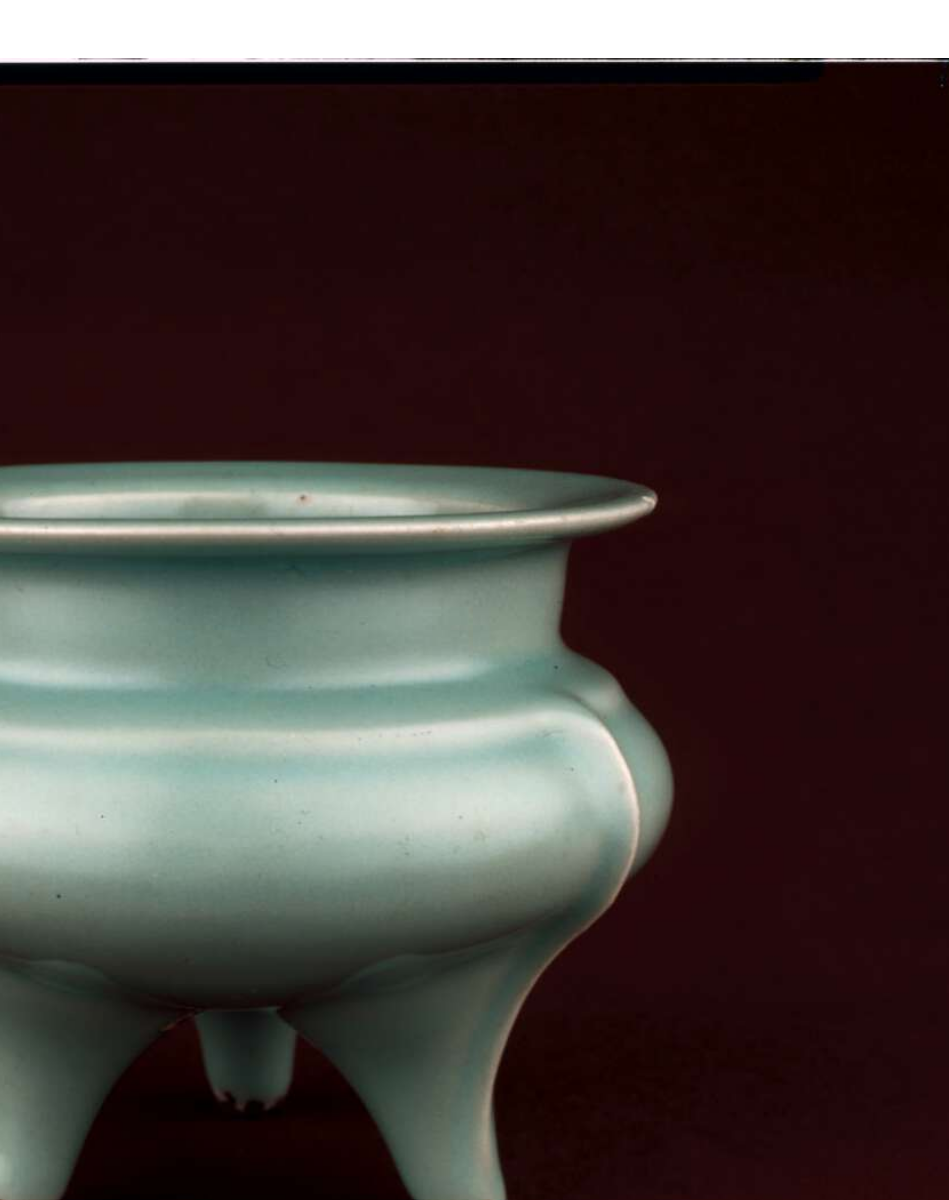
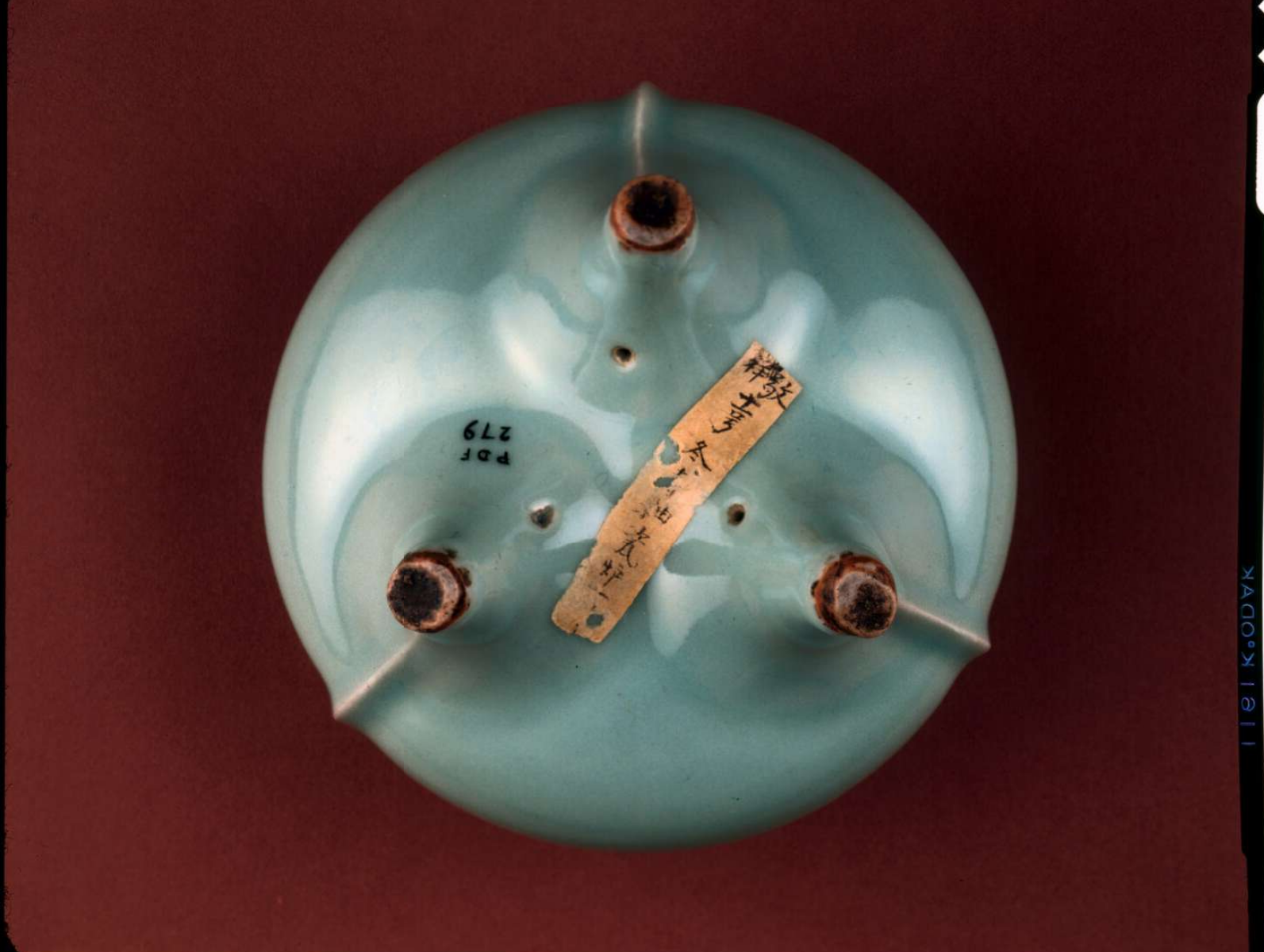
Description
Longquan porcelain incense burner of archaic bronze li form, with globular body, wide straight neck and flattened mouthrim, on three tapered legs. The incense burner has pale grey-green glaze. There is a vent hole in each leg just below the join with the body.
Cultures/periods:Southern Song dynasty
Production date :12thC-13thC
Production place :Made in Longquan (area)
Asia: China Zhejiang(province) Longquan (area)
Materials :porcelain
Ware :Longquan Ware
Technique :glazed
Dimensions Height: Height: 114 millimetres
Curator’s comments
Published PDF date : Southern Song 12th-13thC
Room 95 label text:
PDF 279 :Tripod incense burner
This three-legged incense burner is in the form of an ancient ritual bronze food vessel, called a li (鬲). It is covered with a pale grey-green glaze. In the Song dynasty, educated men revived interest in antiques and in collecting objects from the past. They published catalogues…
PDF 279
青釉三足鬲式香爐
此三足香爐器形仿遠古青銅食器鬲,施淺青灰色釉。宋代,文人熱衷於古物和金石學,關於青銅與玉器的著作頗豐。這一時期的工匠們也將這些古物的造型應用於不同材質的器物上,以滿足當時富裕階層的需求。新的使用者們改變了器物原有的功用,如將此器作為臺案上所用之香爐,而非青銅器中原來作為向去世的祖先供奉食物的鬲。
炻器,属廣義瓷器,青釉
龍泉窯
浙江省龍泉地區
南宋,約1200-1279年
Bibliographic references
Pierson 1997 / Illustrated Catalogue of Celadon Wares in the Percival David Foundation of Chinese Art (p.48, no.279)
Medley 1977 / Illustrated Catalogue of Celadon Wares in the Percival David Foundation of Chinese Art (p.17, no.34)
Medley 1975 / Volume 7: Percival David Foundation of Chinese Art (Monochrome pl. 37)
Location
On display (G95/dc52/s4) (G95/dc52/s4)
Acquisition name
On loan from: Sir Percival David Foundation of Chinese Art
借展单位:戴维德中国艺术品基金会
参考:苏富比
凝盈一色
10 七月 2020 • 香港
Monochrome
Lot 117
AN EXTREMELY RARE LONGQUAN ‘GUAN’ TRIPOD INCENSE BURNER SOUTHERN SONG DYNASTY
南宋 龍泉官青釉鬲式爐
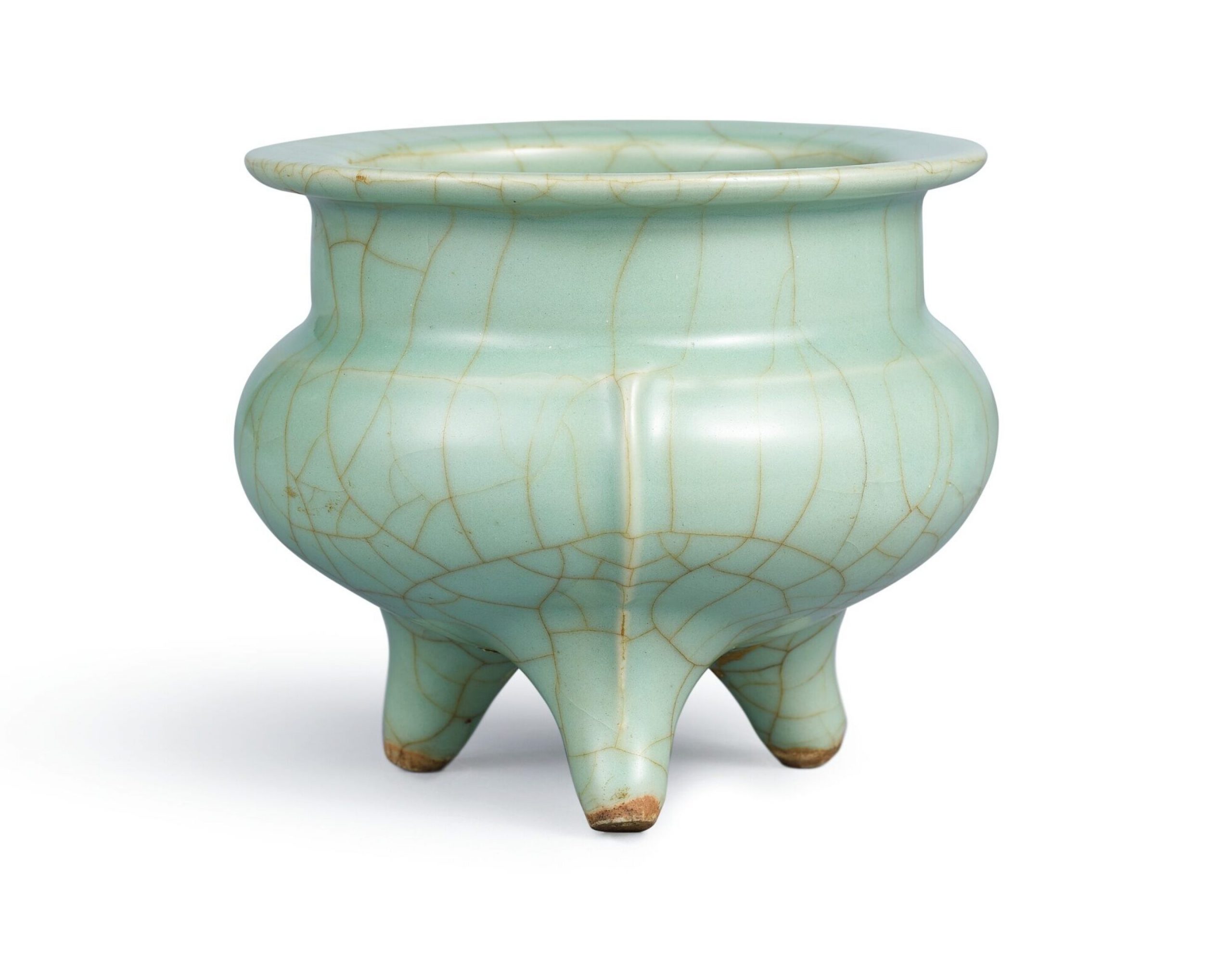
Estimate 6,000,000 – 8,000,000 HKD
Sold 6,775,000 HKD
Description
with a compressed globular body rising to a constricted cylindrical neck and flat everted rim, all supported on three slightly splayed tapering legs, the rounded exterior with three evenly spaced ridges extending from the shoulder to the centre of each leg, superbly covered with a soft bluish-green glaze suffused with a delicate network of golden-brown crackles stopping short of the tips of the legs and exposing the pale grey body
参考:國立故宮博物院
宋 龍泉窯 粉青鬲式爐
南宋-元 龍泉窯 青瓷鬲式爐
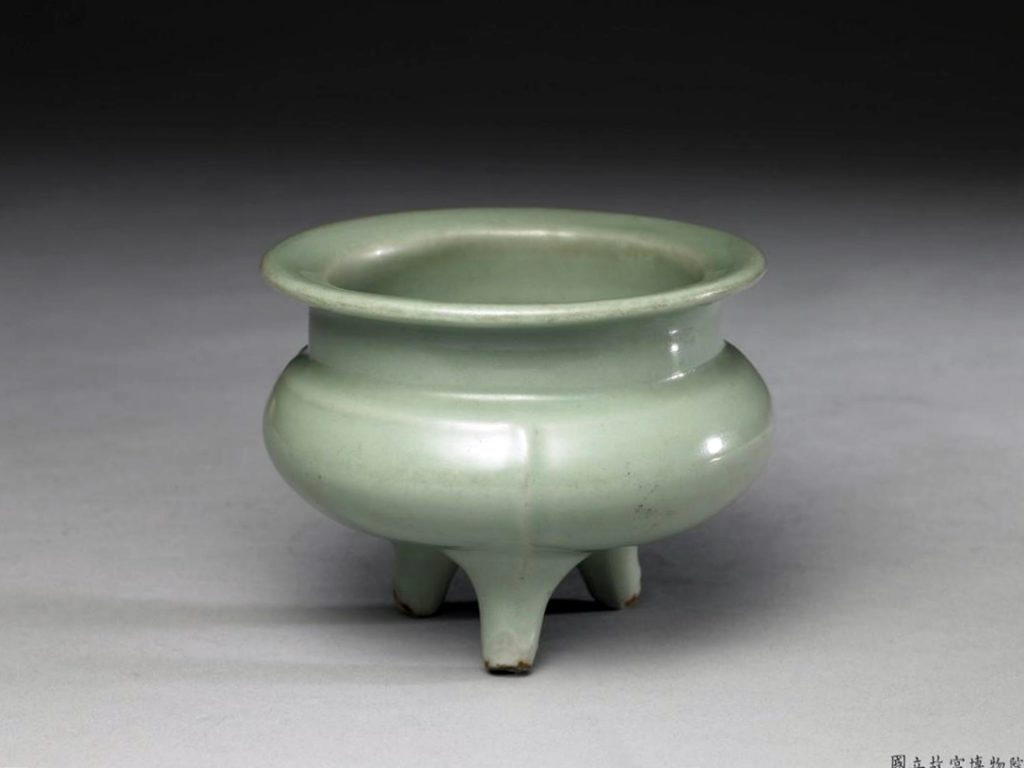
描述:鬲式爐為龍泉窯最常見的香爐形式,類此的造型數量甚多。平折口沿、短直頸、三乳狀足外撇,肩部飾有一道凸弦紋,腹部與三足外側有稜線突起。稜線處釉薄而色淡白,有「出筋」之稱。胎色灰白,足端無釉微呈朱紅。香爐亦宋、元時期常見到的器類,亦官方祭器中最常提及的陶瓷項目。此種造型,與南宋吳奧墓(1268)出土物相近,唯體型稍大,腹較鼓出;四川遂寧窖藏、韓國新安沈船皆有類似器。
日期:1200 A.D.-1350 A.D.
格式:高9.9公分 口徑13公分
關聯:《故宮歷代香具圖錄》
《碧綠—明代龍泉窯青瓷》
《故宮瓷器錄 第一輯 宋元》(上編)
參考:國立故宮博物院 南宋 龍泉窯 青瓷鬲式爐

資料識別:故瓷005168N000000000
資料類型:陶瓷器
描述:取樣於銅鬲造形,侈口折邊,短頸碩腹,三乳足向外斜伸,肩部稜起弦紋一周,並接腹部三條直向至足的稜痕;釉色粉青無紋片,瑩潔滋潤,邊稜多呈淺白色。足底露灰胎,胎釉之際現朱色火石線。內壁光潤,與三足相應處有三凹槽深入足內。
日期:1101 A.D.-1300 A.D.
格式:全高10.8公分 口徑13.5公分
關聯:《千禧年宋代文物大展》
《故宮文物菁華百品展(Ⅱ)》
《故宮瓷器錄 第一輯 宋元》(上編)
参考:國立故宮博物院
仿汝釉瓷爐

資料識別:中瓷003601N000000000
資料類型:陶瓷器
描述:
取樣於銅鬲造形,平口折沿,直短頸,三乳狀足外撇,肩部飾一道凸弦紋,腹部與三足外側有棱線凸起。釉色粉青無紋片,瑩潔滋潤,棱線處釉薄而色淡白。足底露灰胎。足端無釉微呈朱紅。附圓形束腰雲形足木座一只。
格式:高11公分 口徑13.4公分
關聯:《故宮瓷器錄 第一輯 宋元》(下編)
参考:Sotheby’s 中國藝術珍品
2019年5月15日 | 上午 10:30 BST
倫敦
19 中國藝術珍品
瑞秀樓珍藏
南宋 龍泉窰青瓷鬲式爐 連 銀蓋


60,000 — 80,000英鎊
成交價 (含買家佣金) 106,250 英鎊
拍品詳情
南宋 龍泉窰青瓷鬲式爐 連 銀蓋
數量: 2
14公分,5 1/2英寸
來源
林原一郎收藏
倫敦蘇富比2012年11月7日,編號220
相關資料
本三足爐器型典雅,釉面亮澤均勻,弦紋之間聚釉處顏色較深。此器型流行於宋朝,反映當時理學說流行對藝術之影響。宋初,士大夫經科舉遴拔為官,理學大興,崇尚鑑史以修德,高古銅器及玉器亦因而復興,仿古瓷器,遂成宋代流行典型。此類爐形制古雅,仿高古食具銅鬲,三足、帶弦紋 。比較一例,斷代西周,陝西扶風齊家村,圖載於Jessica Rawson,《Western Zhou Bronzes from the Arthur M. Sackler Collections》,華盛頓 D.C.,1990年,圖28.2。
此器型之香爐,見於世界各大博物館及重要私人收藏,北京故宮博物院收藏兩例,載於《故宮博物院藏文物珍品全集.宋瓷(下)》 ,香港,1996年,圖版121及122;台北故宮博物院亦收藏一例,曾展於《故宮歷代香具圖錄》,1994年,編號13;另一例藏於東京國家博物館,曾展於《東洋陶磁大觀》,卷1,東京,1982年,編號97;倫敦大英博物館收藏一例,戴維德爵士故藏,載於Margaret Medley,《Illustrated Catalogue of Celadon Wares in the Percival David Foundation of Chinese Art》,倫敦,1997年,彩色圖版34。再比一例,尺寸較大,藏於哈佛藝術博物館,編號1997.122;;尚有一例售於紐約佳士得2015年9月17至18日,編號2344。
参考:北京东正拍卖有限公司
六朝赏珍·北京东正(南京)2014秋季艺术品拍卖会
2014-12-20
古董珍玩专场
LOT号: 1214 明或更早 龙泉鬲式炉

拍品信息
尺寸 高12.5cm
估价 RMB 800,000-1,200,000
成交价 RMB 1,288,000HKD 1,614,035USD 193,200EUR 141,680
说明
炉扳口宽折沿,短粗颈扁腹下收,底微下凹,腹下承三素面足,通体施青釉,釉色青中带绿,足底露灰白色胎,微显火石红。口沿,肩上弦纹及腿脊部分突起,有出筋现象,为宋龙泉梅子青之佳品。整体造形端正浑厚,曲线流畅,釉面纯净柔和,置于案间,做焚香之用,烟缕安详,值得珍藏。
附鉴定证书
参考:苏富比 615
IMPORTANT CHINESE ART
南宋 龍泉窰青釉鬲式爐

150,000 — 200,000美元
拍品詳情
南宋 龍泉窰青釉鬲式爐
狀況報告
整體品相良好,惟足之底側見輕微磨痕,屬正常,有窰燒微瑕(如口沿見數釉線,器腹有細微爆釉),扉棱(如圖錄所示)見色變小斑。釉面經清理磨光。較圖錄印刷所示,實物釉色略微偏青
IMPORTANT CHINESE ART
2019年3月20日 | 上午 10:00 EDT
紐約
参考:苏富比 314
中國藝術品
心懩堂收藏
宋 龍泉青釉鬲式爐

20,000 — 30,000港幣
拍品已售 275,000 港幣 成交價 (含買家佣金)
拍品詳情
宋 龍泉青釉鬲式爐
13 公分, 5 1/8 英寸
來源
香港永寶齋,1990年代
中國藝術品
2019年5月30日 – 2019年5月31日 | 上午 10:30 HKT
香港
参考:苏富比 362
中國藝術品
宋 龍泉青釉鬲式爐

40,000 — 60,000港幣
拍品已售 106,250 港幣 成交價 (含買家佣金)
拍品詳情
宋 龍泉青釉鬲式爐
10.9 公分,4 1/4 英寸
中國藝術品
2018年5月31日 – 2018年6月1日 | 上午 11:15 HKT
香港
参考: 苏富比 386
中國藝術品
宋 龍泉窰青釉三足爐

50,000 — 70,000港幣
拍品已售 175,000 港幣 成交價 (含買家佣金)
拍品詳情
宋 龍泉窰青釉三足爐
9 公分,3 1/2 英寸
中國藝術品
2017年6月1日 – 2017年6月2日 | 下午 2:00 HKT
香港
参考:苏富比 650
中國藝術品
南宋 龍泉窰青釉三足爐

30,000 — 40,000港幣
拍品已售 125,000 港幣 成交價 (含買家佣金)
拍品詳情
南宋 龍泉窰青釉三足爐
10.1 公分,4 英寸
中國藝術品
2016年12月2日 | 上午 10:00 HKT
香港
参考:苏富比 662
中國藝術品
宋 龍泉窰青釉三足爐
25,000 — 35,000港幣
拍品已售 150,000 港幣 成交價 (含買家佣金)
拍品詳情
宋 龍泉窰青釉三足爐
9.4 公分,3 5/8 英寸
狀況報告
整體品相良好。見些許正常窰燒瑕疵,最明顯為一縮釉及一鐵斑,均見於外壁。
中國藝術品
2016年6月2日 – 2016年6月3日 | 下午 2:00 HKT
香港
参考:苏富比
中國藝術品
02 六月 2016 • 香港
673 宋至明 龍泉窰青釉三足爐

30,000 — 50,000港幣
拍品已售 375,000 港幣 成交價 (含買家佣金)
拍品詳情
宋至明 龍泉窰青釉三足爐
幅 13 公分,5 1/8 英寸
狀況報告
整體品相良好。
中國藝術品
2016年6月2日 – 2016年6月3日 | 下午 2:00 HKT
香港
参考: 北京保利
2018春季拍卖会
中国古董珍玩(Ⅰ)
6052 元 龙泉出筋小炉

龙泉出筋小炉
拍品信息
尺寸 宽9.8cm
估价 50,000-80,000
成交价 RMB 57,500
小炉折沿口,短束颈,扁鼓腹,肩部起凸棱一周,三面腹部至足背“出筋”,三足微外侈呈鼎立之势。其器式比例得宜,端庄典雅。里外满釉,由于烧制温度极高,底部稍有流釉,瓷化程度极佳,胎骨白而釉水青亮通透,莹澈如春水,有冰清玉洁之质感。
炉口径10厘米,在诸多传世龙泉窑鬲式炉中属尺寸小巧,工艺纯熟精良的佳品。
本品带日本原装双层精制漆盒。
来源:日本藏家旧藏
参考: 北京保利2018秋季拍卖会
中国古董珍玩Ⅰ—元明清瓷器
5578 明 龙泉青釉炉

龙泉青釉炉
拍品信息
尺寸 高11.5cm
估价 60,000-80,000
成交价 RMB 69,000
折沿口微上倾,直颈略收,扁圆腹,底周置三足,三足内侧各开一通气小孔,三面腹部至足背各凸起一条棱脊,微露白痕,俗称“出筋”。通体施青釉,色青莹,质温润,足底露胎,呈火石红色。鬲式炉造型仿自商周铜鬲,亦是龙泉窑最为常见的经典炉式之一。由于产量较大,其具体规格大小、器式比例、审美风格往往存有差异。若本品口径13、高12 公分,已属尺寸较大者。尤其颈腹足三部分比例协调得当,整器挺拔秀逸,当属鬲式炉制品中之佼佼者。
备注:日本藏家旧藏。
参考: 北京保利2019秋季拍卖会
宸趣——文房清玩隽品集珍
7138 元 龙泉窑梅子青釉鬲式炉

龙泉窑梅子青釉鬲式炉
拍品信息
尺寸 直径13.5cm
估价 1,200,000-1,500,000
成交价 RMB 1,380,000
备注
1.东京Daijindo Gallery 高树让治先生旧藏;
2.日本重要私人藏家旧藏,入藏于20世纪初,后家族递藏
以厚釉青瓷著称的龙泉窑是中国青瓷史上一颗璀璨的明珠,自宋代兴起以来,历经元明,凭其肥美的釉汁和优雅的形态称绝于世。本品即为南宋龙泉窑的代表作品。
此龙泉青釉三足鬲式炉通体满施青釉,釉质紧密而均匀,釉层略带透明,釉面光洁而沈稳,色泽照人,直颈,鼓腹,底部略微下垂,底部三足,略为外撇且刚劲有力,三足跟内各穿一孔。中腹部起棱线,并延至足跟设无釉尖足,可见坚实的胎土,有返璞归真之气。此炉釉色为柔润如玉的「梅子青」色,深浅适度,其釉的色泽和质地美代表了中国历史上青釉的最高水平。南宋龙泉青瓷以釉色取胜,其中梅子青釉深沈华滋,釉色葱翠,釉层略带透明,色泽照人,犹如梅子初生,因而得名。与本件作品形制相近者不乏,可比瑞士著名收藏家鲍尔(The Baur Collection)所藏一件南宋龙泉窑梅子青釉鬲式炉,其釉色莹润,大小形制与本件作品近似。另可比较香港苏富比售于2003年一件南宋龙泉窑鬲式炉,与本件作品极为近似,出版于《香港苏富比30周年》图录,页133,值得壹提的是,本件作品与苏富比售这件龙泉窑鬲式炉来自同一日本重要藏家宝藏。
此器整体造型流线柔和光滑。为典型的三足鬲式炉造型。香炉,是「香道」必备的器具,造型多样,但万变不离其器型用意,此件龙泉青釉三足鬲式炉在保证器具用途的前提下,整体气质淡雅,实符礼佛所需的清净素雅之气,形神兼备,为南宋龙泉窑名器。此炉婉约静谧,传承有绪,品相完美。旧配日本木盒及包装,木盒墨书签条「龙泉青磁绔腰香炉」。
参考:苏富比
重要中國瓷器及工藝品
2012年9月11日 – 2012年9月12日 | 上午 10:00 EDT
紐約
134 南宋 龍泉窰鬲式爐



估價 30,000 — 40,000 美元
拍品已售 43,750 美元 成交價 (含買家佣金)
拍品詳情
南宋 龍泉窰鬲式爐
高 3 1/2 英寸,8.9 公分
狀況報告
There are three small chips, minor fritting, burst air bubbles and iron spots to the rim edge. There is a small area of glaze pull to one leg. There are light scratches and general wear overall.
來源
日內瓦鮑氏收藏, A99 號。
比利時私人收藏。
倫敦蘇富比2005年11月9日,拍品編號274。
参考:佳士得拍賣 14612
中國宮廷御製藝術精品/ 重要中國瓷器及工藝精品
Convention Hall|2017年5月31日
拍品3180
明 仿官鬲式爐
MING DYNASTY (1368-1644)
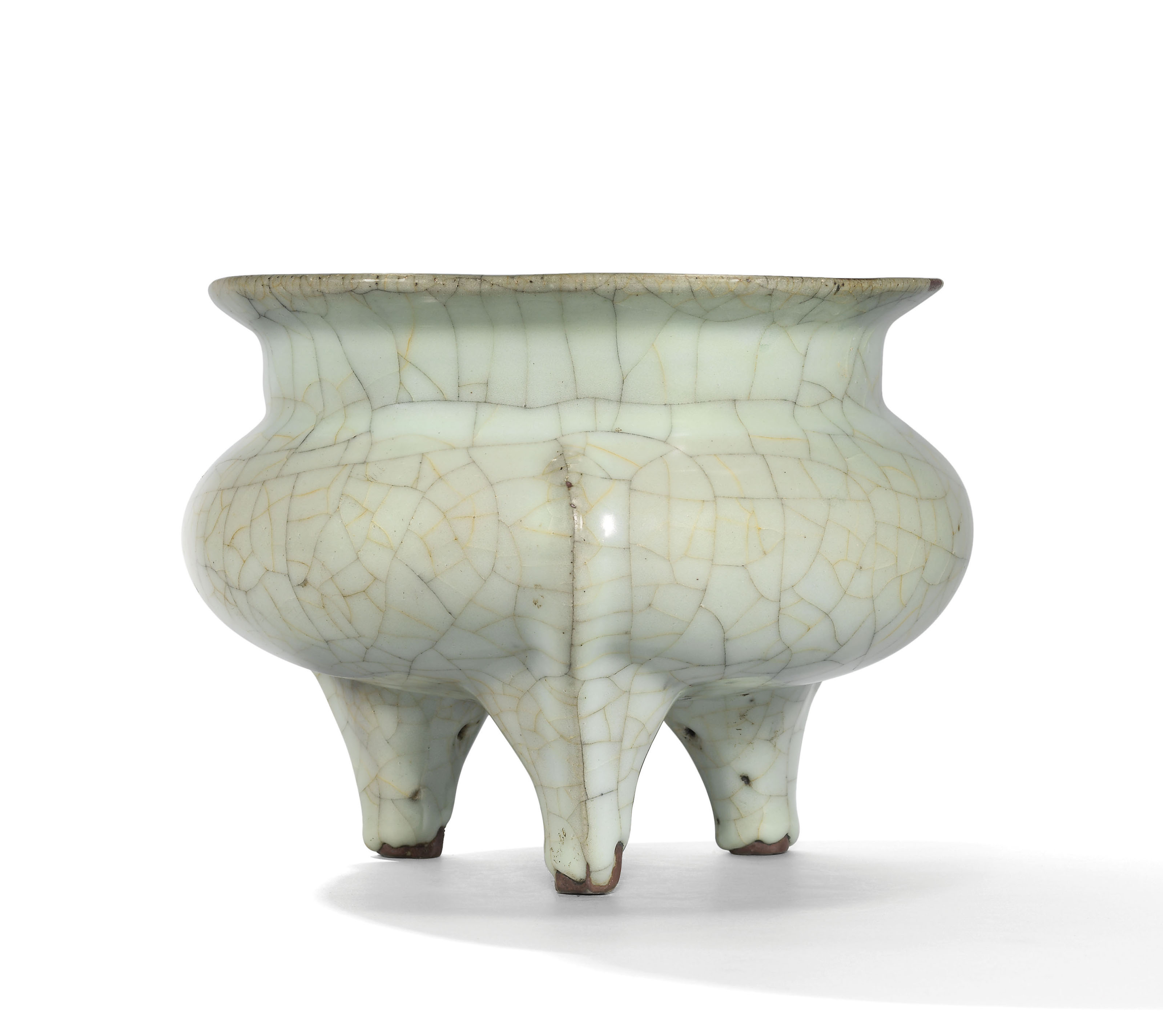
明 仿官鬲式爐
成交總額 HKD 750,000
估價 HKD 120,000 – HKD 180,000
明 仿官鬲式爐
9 ½ in. (24 cm.) wide
拍品專文
可參考一件無論器形、釉色及大小 (21公分寬)均與本拍品非常相似的例子,2016年6月1日於香港佳士得拍賣,拍品3310號。
参考:佳士得拍賣 15449
中國瓷器及工藝精品
紐約|2018年3月22日 – 23日
拍品709
南宋 龍泉青釉鬲式爐
SOUTHERN SONG DYNASTY (1127-1279)
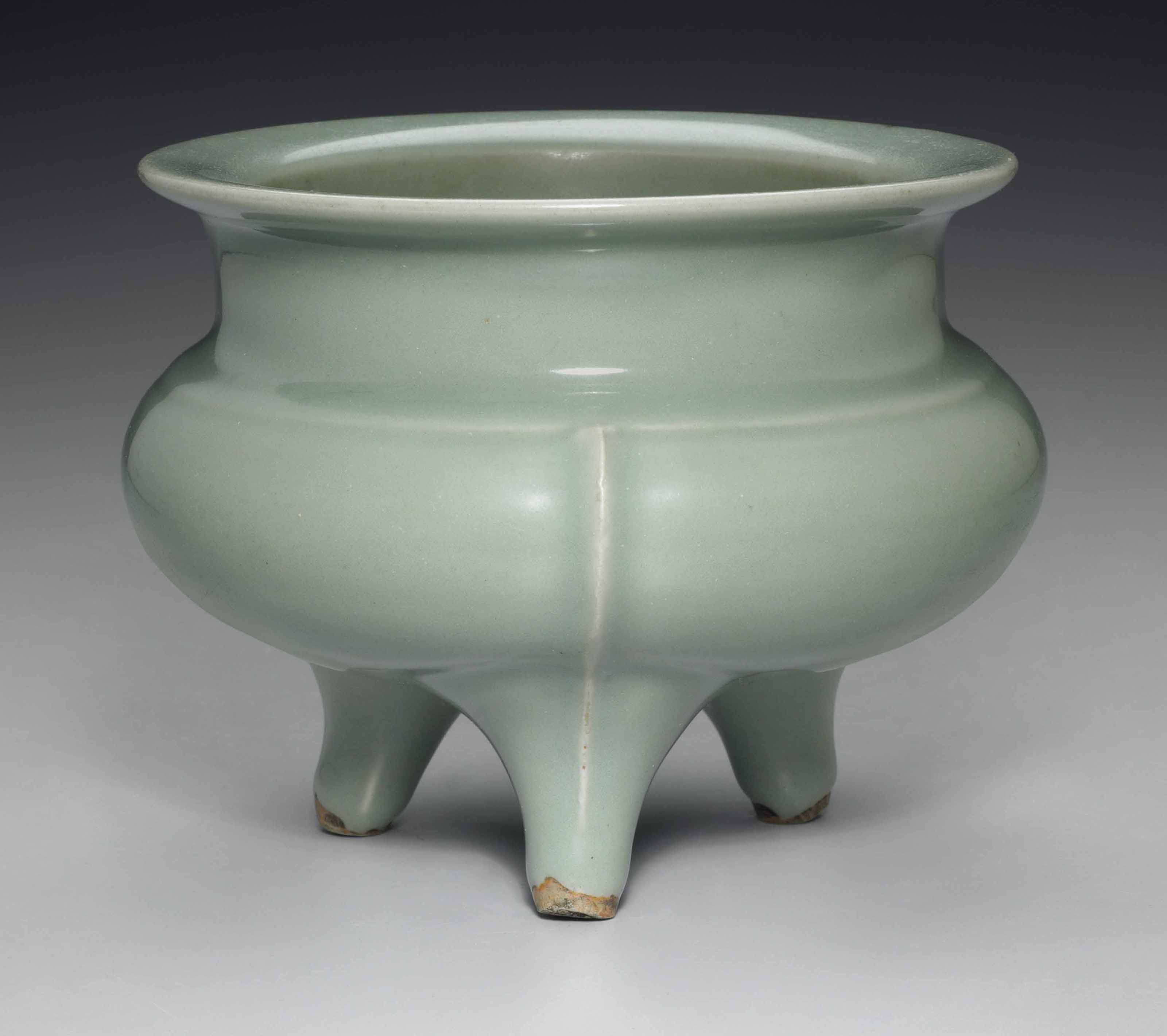
南宋 龍泉青釉鬲式爐
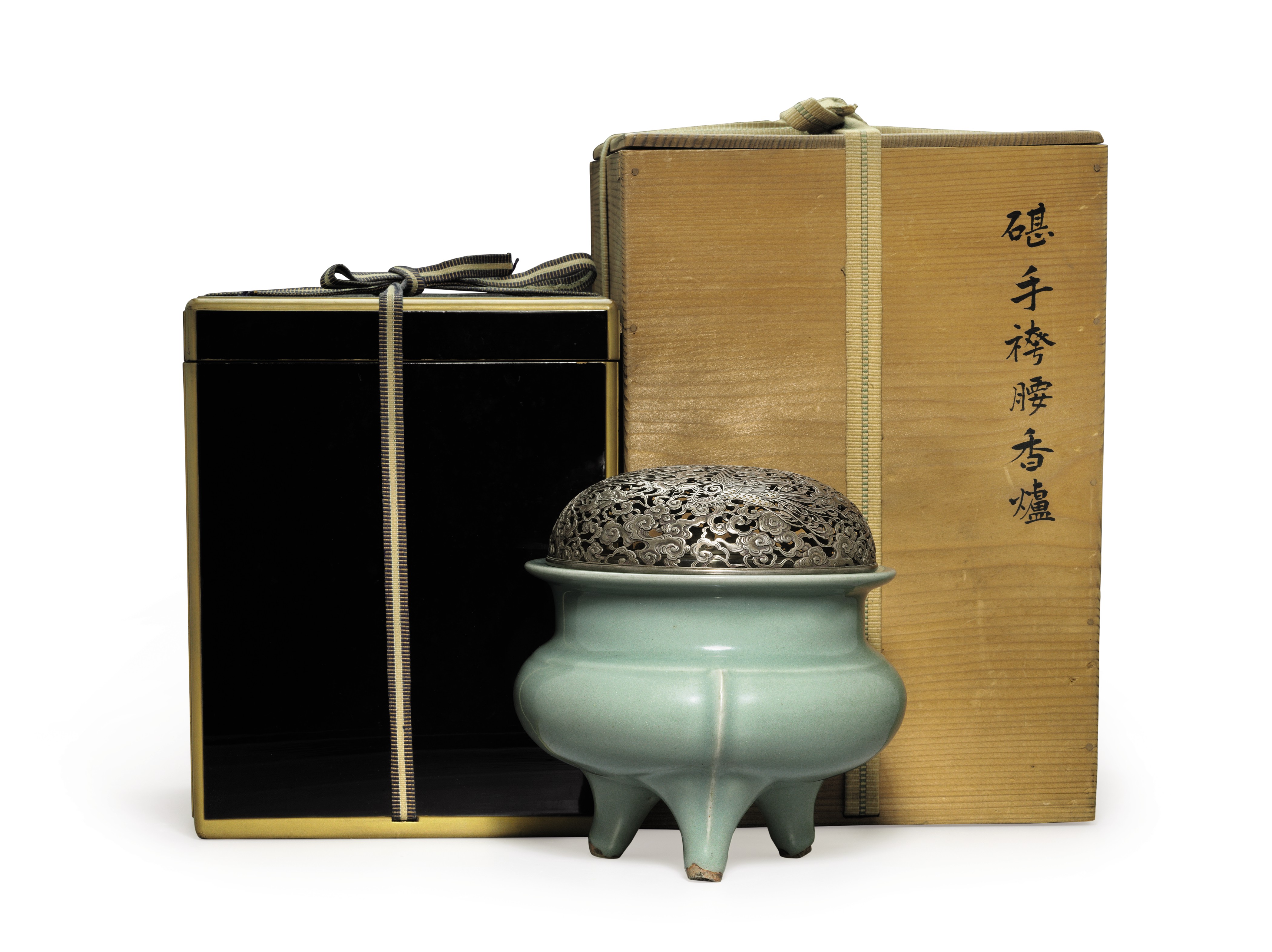
南宋 龍泉青釉鬲式爐
成交總額 USD 187,500
估價 USD 50,000 – USD 70,000
南宋 龍泉青釉鬲式爐
5 ½ in. (14 cm.) high, reticulated silver cover, gold-lacquered cover, Japanese lacquered box and wood box
來源
Japanese private collection, Meiji-Taisho period (1868-1912).
拍品專文
The shape of this censer, based on that of the ancient bronze li, was produced from the Southern Song into the Yuan period for the domestic as well as the export market. The numerous tripod censers retrieved from the Sinan shipwreck provide evidence that this shape was much sought after in Japan, the original destination of the ship’s cargo, and where they have since been widely collected.
The thick, translucent glaze is typical of this type of Southern Song Longquan ware, as is the lack of any decoration other than the flanges. A number of Longquan celadon censers of the same shape are published, including several in renowned museum collections. Examples in the Tokyo National Museum and Percival David Foundation, London, are published in Oriental Ceramics, The World’s Great Collections, Tokyo, 1982, vol. 1, no. 97, and vol. 6, no. 37, respectively. Others include the example by J. Ayers, The Baur Collection: Chinese Ceramics, vol. I, Geneva, 1972, no. A99; and the National Palace Museum, Taiwan, included in the Illustrated Catalogue of Sung Dynasty Porcelain, Taipei, 1974, no. 12. A larger example (19.7 cm. diam.), found in 1991 in Jinyu village of Nanqiong, Suining city, Sichuan province, is illustrated in Longquan Celadon: The Sichuan Museum Collection, Macau, 1998, pp. 210-11, no. 83.
参考:佳士得
拍賣 2872
中國瓷器及工藝精品
紐約|2014年9月18日 – 19日
拍品745
南宋 龍泉仿官釉三足爐
SOUTHERN SONG DYNASTY (1127-1279)
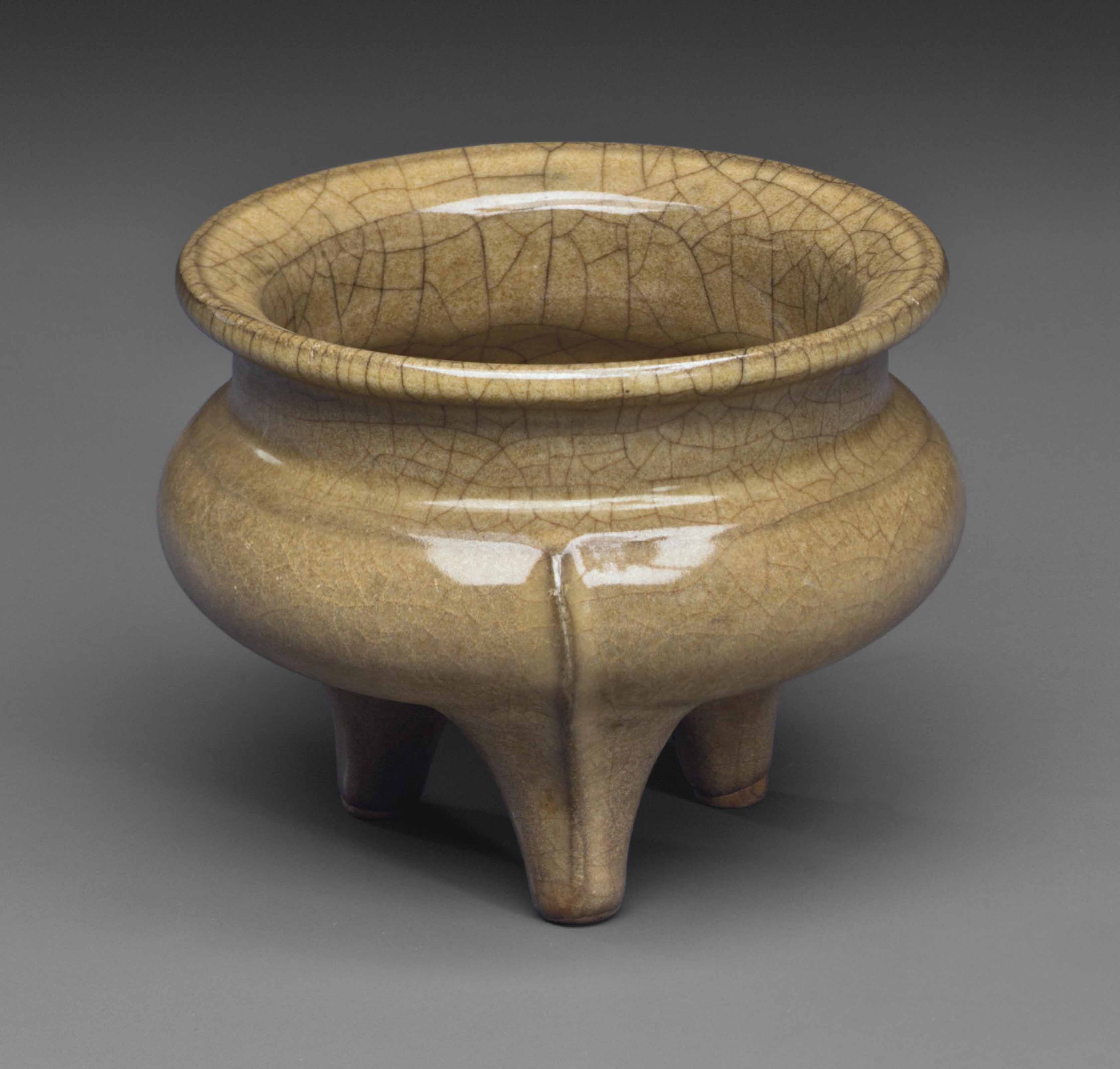
南宋 龍泉仿官釉三足爐
成交總額 USD 173,000
估價 USD 100,000 – USD 150,000
南宋
龍泉仿官釉三足爐
來源
Sekido family, Edo period (1603-1868), Japan (according to Shokaken seal on box)
拍品專文
This Longquan tripod censer assumes the form of a Shang- or Zhou-dynasty liding cauldron, a bronze vessel that in antiquity was used to boil millet for use in ceremonies honoring the spirits of deceased ancestors. In both early bronzes and later ceramics, the tri-lobed bodies of such liding-form vessels resolve themselves in a circular neck and lip, as seen in this fine example.
The association of later ceramics with Bronze Age antiquities came about as the literati, following the lead of the Imperial Court, began to collect ancient bronzes and jades during the Northern Song period. On rare occasions, when learned friends of taste and sophistication would gather for an afternoon of poetry, painting, and collection viewing, a collector might press several of his collected antiquities into service as vases and censers, using an ancient bronze gu or zun wine vessel as a flower vase, for example, and an ancient bronze ding or liding cooking vessel or a gui food-serving vessel as a censer. The collectors and their guests knew that in antiquity such bronzes were used as vessels for food and wine in funerary ceremonies, but they nevertheless repurposed them to serve their own needs and tastes. However, realizing that too frequent use would damage, or even ruin, their collected antiquities, such collectors began to rely on related pieces made in ceramic ware, thereby giving rise to the tradition of censers and vases in the shape of ancient bronzes.
The form, glaze, and dove-grey stoneware body indicate that this censer was made at the Longquan kilns during the Southern Song period. Fired in an oxygen-deprived, reducing atmosphere, the exposed body clay at the bottom of the feet has fired russet brown, a notable characteristic of wares produced at the Longquan kilns.
Standard Southern Song Longquan wares typically feature thick, semi-opaque glazes of cool, bluish-green hue over dove-grey stoneware bodies. The jade-like glaze’s semi-opacity results from the presence of numerous tiny bubbles and particle inclusions. Most Longquan celadons are unornamented, relying on precisely defined forms and perfectly hued glazes for aesthetic appeal. In that context, the Longquan potters definitely took their aesthetic cues from aristocratic wares made at the Guan kilns.
Although the glazes of most Longquan celadon wares exhibit a cool, bluish-green hue and lack craquelure, fine crackled wares were also made at the Longquan kilns during the Southern Song period. Renowned ceramics specialist Professor Zhu Boqian has suggested that the Longquan kilns began to make crackled wares around 1200 in imitation of the Southern Song crackled Guan wares made at the Jiaotanxia kilns, near Hangzhou. (Rosemary Scott, “Guan or Ge Ware: A Re-Examination of Some Pieces in the Percival David Foundation”, Oriental Art, Summer 1993, vol. 39, no. 2, p. 19.) According to excavation reports, places where these Longquan wares in Guan style were made include Xinting, Aodi, and Shanshu Lianshan in Dayao County and Wayaoqing, Kulouwan, and Lijiashan in Xikou County. See Sung Guan Yao Te Zhan (Catalogue of the Special Exhibition of Sung Dynasty Kuan Ware), National Palace Museum, Taipei, 1989, p. 30.
Guan-type wares produced at the Longquan kilns show considerable variation, some pieces exhibiting the dark, slate-grey bodies and crackled, greyish-blue glazes characteristic of the finest works made at the Guan kilns, while others merely imitate the form of Guan pieces but claim the light grey stoneware bodies typical of standard Longquan celadon ware. The most difficult to categorize are those Longquan pieces with a golden-brown glaze, such as the present tripod censer, as it is uncertain whether the glaze is golden brown by intention or simply by accident of exposure to an oxidizing atmosphere within the kiln at the beginning of the cooling cycle. A few Guan vessels boast crackled, greyish-blue glazes with undercurrents of pale, café-au-lait brown, as exemplified by a cuspidor in the collection of the National Palace Museum, Taipei, which the curators there attribute to the Southern Song period and to the Jiaotanxia kilns; alas, it remains unclear whether the brownish cast is the result of exposure to an oxidizing atmosphere during firing or to a stain spreading outward between glaze and body from the brown veins within the craquelure. See Sung Guan Yao Te Zhan (Catalogue of the Special Exhibition of Sung Dynasty Kuan Ware), National Palace Museum, Taipei, 1989, no. 42.
That both the slight ridge that distinguishes neck from shoulder and the vertical ribs that embellish the legs are brown, rather than white – as they are on similarly shaped Longquan liding-form censers with classic bluish-green glaze – suggests that this piece was intended from the beginning to have a golden-brown glaze, as does the even, homogeneous hue of that golden-brown glaze. If so, the body, or at least those areas where the glaze was expected to run thin during firing, might have been dressed with an iron-oxide-bearding slip before the glaze slurry was applied, causing the vertical ribs on the legs and the slight ridge at the base of the neck to appear brown.
A censer of related form with crackled, brownish-hued glaze was sold at Sotheby’s Hong Kong, 14 November 1989, lot 9. A Longquan long-necked bottle and a bowl with vertical side walls, each with golden-brown glaze and attributed to the Southern Song period, are illustrated in Longquan Yao Qing Ci (Celadons from Longquan Kilns), Taipei, 1998, p. 139, pl. 106, and p. 170, pls. 141-1 and 141-2, respectively.
Finally, a tripod incense burner with delicately cusped body, upright S-curved handles, mock-ring embellishments, and a golden-brown glaze in the collection of the Metropolitan Museum of Art, New York, is attributed to the Song dynasty (960-1279) and has been identified as Guan-type ware (accession number 17.118.27a,b). If the Metropolitan Museum censer truly is Guan ware, dates to the Song dynasty, and fired to the intended color, perhaps its glaze can be cited as aesthetic inspiration for the golden-brown glaze of the present censer.
Robert D. Mowry
Alan J. Dworsky Curator of Chinese Art Emeritus, Harvard Art Museums, and Senior Consultant, Christie’s
参考:佳士得拍賣 2208
重要中國瓷器
香港|2005年11月28日
拍品1443| 南宋 龙泉三足香炉
A LONGQUAN CELADON TRIPOD CENSER

成交總額 HKD 168,000
估價 HKD 150,000 – HKD 200,000
A LONGQUAN CELADON TRIPOD CENSER
SOUTHERN SONG DYNASTY, 12TH/13TH CENTURY
The compressed globular body moulded with a raised rib at the shoulder, connected to three raised lines running vertically from the shoulder to each conical foot, the straight neck supporting a flattened everted mouth rim, covered overall in a crackled pale celadon glaze
5 1/8 in. (13 cm.) diam., gilt-silver openwork cover, Japanese wood boxes
來源
A Japanese private collection
参考:佳士得拍賣 2963
重要中國瓷器及工藝精品Hong Kong|2012年11月28日
拍品2273 南宋 龍泉青釉鬲式爐
SOUTHERN SONG DYNASTY (1127-1279)
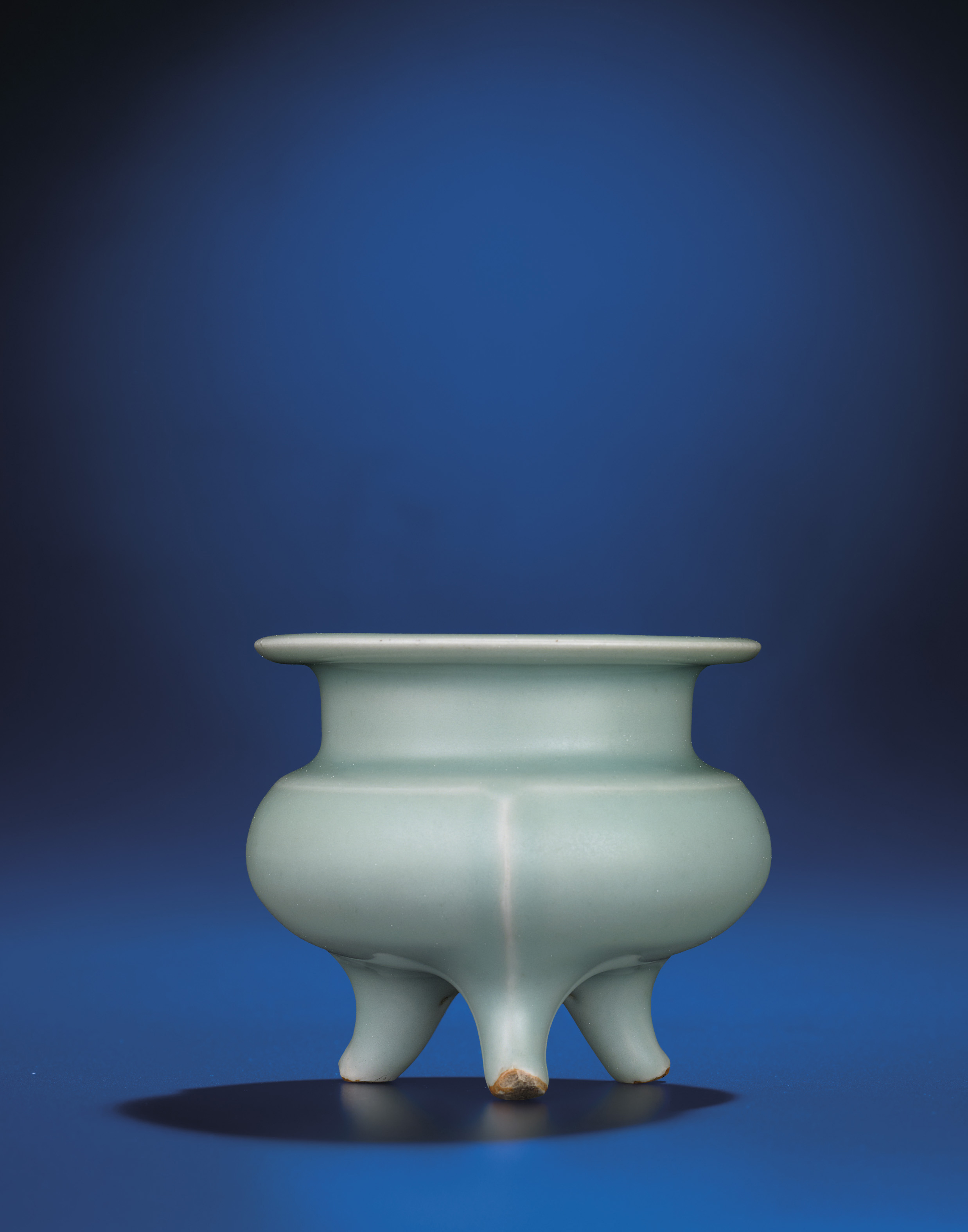
成交總額 HKD 740,000
估價HKD 300,000 – HKD 500,000
來源
A Japanese private collection, Kyoto, acquired in the first half of the 20th century
拍品專文
This shape, inspired by ancient bronze li, was produced during the Southern Song through the Yuan period for the domestic as well as the export market. The numerous examples of Longquan tripod censers retrieved from the Sinan shipwreck provide evidence that this shape was much sought after in Japan, the original destination of the ship’s cargo, and where they have since been widely collected.
A number of Longquan celadon censers of same shape are published, including several in renowned museum collections. Examples in the Tokyo National Museum and Percival David Foundation, London, are published in Oriental Ceramics, The World’s Great Collections, Kodansha series, Tokyo, 1982, vol. 1, no. 97, and vol. 6, no. 37, respectively. Others include the example in the Idemitsu Museum of Arts, Tokyo, illustrated in the exhibition catalogue, Ice and Green Clouds: Traditions of Chinese Celadon, Indianapolis Museum of Art, p. 196, no. 79; The Baur Collection, illustrated by J. Ayers, in the Catalogue, vol. I. Geneva, 1972, no. A99; the National Palace Museum, Taipei, included in Illustrated Catalogue of A Special Exhibition of Sung Porcelain, Taipei, 1978, no. 13; and in the Cleveland Museum of Art, illustrated in the Catalogue of the Severance and Greta Milikin Collection, Cleveland, 1990, no. 6. Other examples were sold at Christie’s Hong Kong, 1 December 2009, lot 1861; and 30 May 2012, lot 4233.
参考:佳士得拍賣 3213
中國宮廷御製藝術精品
重要中國瓷器及工藝精品
Hong Kong, HKCEC Grand Hall|2013年5月29日
拍品2225 南宋 官窰三足爐
SOUTHERN SONG DYNASTY (1127-1279)
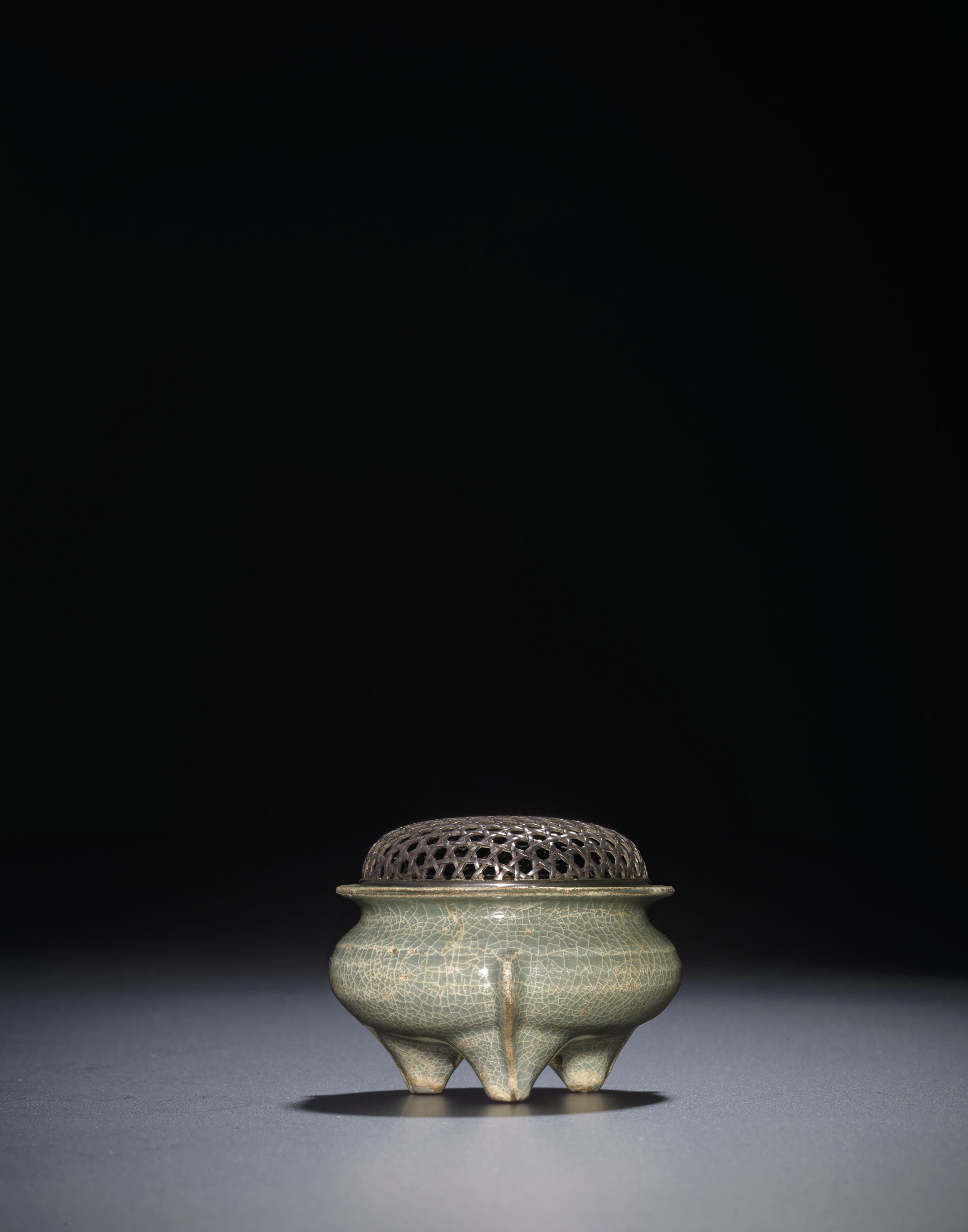
成交總額 HKD 300,000
估價 HKD 200,000 – HKD 300,000
此器源自1960年代日本私人收藏。
來源
A Japanese private collection, acquired in the 1960s
參考:紐約大都會博物館 青釉三足香炉Incense burner
China

Object Details
Period:
Culture:China
Medium:Porcelain
Dimensions:H. 3 7/8 in. (9.8 cm); W. 5 1/4 in. (13.3 cm)
Classification:Ceramics
Credit Line:Rogers Fund, 1922
Accession Number:22.30
Provenance
Li Mu Kung (until 1922, his sale, American Art Galleries, New York, February 9–10, No.155, to MMA)
Timeline of Art History
Timelines
Central and North Asia, 1800-1900 A.D.
Central and North Asia, 1900 A.D.-present
China, 1800-1900 A.D.
China, 1900 A.D.-present
参考:北京东正
2015年春季艺术品拍卖会
中国古董珍玩专场
Lot 4025 元/明 龙泉鬲式炉

估价:250,000-300,000 RMB
成交价: 287,500 RMB (含买家佣金)
尺寸:直径14cm
参考:苏富比
重要中國瓷器及工藝品
2013年11月6日 | 上午 10:00 GMT
倫敦
南宋 龍泉窰青釉鬲式爐
FINE CHINESE CERAMICS & WORKS OF ART
231 A ‘Longquan’ celadon tripod censer Southern Song dynasty
估價 50,000 — 70,000 英鎊
拍品已售 116,500 英鎊 成交價 (含買家佣金)

A ‘Longquan’ celadon tripod censer
Southern Song dynasty
of compressed globular form with a straight neck and broad everted rim, supported on three splayed legs each moulded with a vertical flange, covered overall with an attractive sea-green glaze
12.9cm., 5 1/8 in.
The censer is in very good condition.
EXHIBITED
The Splendor of Chinese Celadons, National Taiwan Museum, Taiwan, 1991, cat.no.54.
展覽
《青瓷之美: 奪得千峰翠色來》,國立台北博物館,台灣,1991年,編號54
参考:佳士得 拍賣 14710
重要中國瓷器及工藝精品
香港|2017年11月29日
拍品2992 南宋 龍泉青釉鬲式爐
SOUTHERN SONG DYNASTY (1127-1279)
成交總額 HKD 1,000,000
估價 HKD 800,000 – HKD 1,200,000

南宋 龍泉青釉鬲式爐
5 7/8 in. (15 cm.) diam., box
A FINE LONGQUAN TRIPOD CENSER
SOUTHERN SONG DYNASTY (1127-1279)
The compressed bombe body is decorated with three evenly spaced vertical flanges that runs down to the short tripod feet. The neck raises from the body and flares at the mouth rim. It is covered overall with a rich bluish-green glaze, thinning slightly over the rim and raised decoration, and pooling at the recesses.
5 7/8 in. (15 cm.) diam., box
狀況報告
謹請注意,所有拍品均按「現狀」拍賣,閣下或閣下的專業顧問應於拍賣前親自查看拍品以評鑑拍品之狀況。
– 整體品相良好
– 足底有正常磨損
参考 佳士得
拍賣 12675
養德堂珍藏中國古陶瓷
Hong Kong, HKCEC Grand Hall|2016年11月30日
拍品3132
南宋/元 龍泉青釉鬲式爐
SOUTHERN SONG-YUAN DYNASTY (1127-1368)
LOT 3132 A RARE LONGQUAN CELADON TRIPOD CENSER
SOUTHERN SONG-YUAN DYNASTY (1127-1368)
成交總額 HKD 1,187,500
估價 HKD 500,000 – HKD 800,000

南宋/元 龍泉青釉鬲式爐
5 1/8 in. (13 cm.) diam.
來源
倫敦蘇富比,1983年12月3日,拍品215號
A RARE LONGQUAN CELADON TRIPOD CENSER
SOUTHERN SONG-YUAN DYNASTY (1127-1368)
The compressed body is moulded with three narrow flanges each above a slightly splayed, conical leg with animal mask, surmounted by a cylindrical neck rising to the flat, everted rim. The censer is covered overall with a soft green glaze of even tone ending at the bottom of the legs to expose the pale grey ware.
5 1/8 in. (13 cm.) diam., box, silver cover
文獻及展覽
文獻
譚旦冏,《中國陶瓷史》,下冊,台北,1985年,503頁
拍品專文
鬲式爐是南宋龍泉窯的經典器形,然而如本件鬲式爐這樣在足上加飾獸面紋的則極為罕見。這一裝飾手法開創了明代龍泉窯運用獸面足的先河,參見兩件明龍泉青釉獸足鼓釘洗,載於《龍泉窯青磁展 :日本人の愛した中国陶磁》,2012年,93頁,編號108及109。南宋龍泉窯鬲爐取材於商周青銅器鬲的器形,反映了當時文人士大夫崇古復古的風氣。前揭書亦載有一件與本件鬲爐器形相近,尺寸稍大(口徑20公分)的南宋龍泉窯鬲式爐,見該書47頁,編號38。亦可比一件南宋龍泉鬲爐,2016年10月4日在香港佳士得拍賣,拍品編號119。
Provenance
Sold at Sotheby’s London, 3 December 1983, lot 215
Literature
Tan Dan-jiong, History of Chinese Ceramics, vol. 2, Taipei, 1985, p. 503
Lot Essay
The form of the current censer is closely modelled after archaic bronze li of the Shang and Zhou periods. This transfer of form between mediums reflected a trend of antiquarianism popular during the Southern Song dynasty. The present censer, however, has additional moulded taotie masks on the feet, which is rarely found on Longquan wares of this period, but more commonly seen during the Ming dynasty, as exemplified by two Longquan basins illustrated in Longquan Ware: Chinese Celadon Beloved of the Japanese, 2012, p. 93, nos. 108 & 109. For a Southern Song Longquan tripod censer of very similar form and proportion but of larger size (20 cm. diam.), see an example in the Idemitsu Museum of Arts, Tokyo, illustrated in ibid., p. 47, no. 38. Compare also a similar Longquan tripod censer sold at Christie’s Hong Kong, 4 October 2016, lot 119.
南宋 镂空如意银盖青釉出戟鬲式三足香炉香薰



参考:北京东正拍卖有限公司
2014-05-18 2014年春季艺术品拍卖会
中国古董珍玩专场 Part1
0529 元/明 龙泉窑出戟三足炉

拍品信息
估价 260,000至280,000
成交价 —
规格 直径9.5cm
拍品描述:此件器物是龙泉窑三足炉,其器唇口外撇平沿,束颈,鼓腹,下呈承足。此件器物凭借丰厚釉层使釉色莹润葱翠,是属典型的梅子青色调。微露白色胎体,造成边角转折处的楞线出筋,使之具有深浅不同的层次变化,烧造技术之高,可说是代表了中国古代青瓷的最高水平。并且此物的造型古拙典雅,形制玲珑小巧,精美可爱,温雅喜人。
参考:ARTS D’ASIE
18 DECEMBER 2012 | 10:00 AM CET / PARIS

95 BRÛLE-PARFUM EN PORCELAINE CÉLADON LONGQUAN
CHINE, DYNASTIE SONG (960-1279)
Estimate 35,000 — 45,000
A LONGQUAN CELADON CENSER AND COVER, CHINA, SONG DYNASTY, (960-1279)
reposant sur trois petits pieds, la panse bombée rehaussée de trois fines arêtes en relief, le col droit terminé par une bordure plate accueillant un couvercle en argent finement ajouré de motifs géométriques, boîte japonaise en bois (4)
14,4 cm, 5 5/8 in.
The censer in very good overall condition with a burst air bubble near one foot, a 1cm glaze fault to the shoulder and another burst air bubble to the shoulder as well.
PROVENANCE
Acquired in 1939 in Japan.
CATALOGUE NOTE
The form of the present censer derives from an archaic bronze vessel form known as li. With the revival of archaic bronze shapes in the Song Dynasty, this form was adapted into the repertoire of the Song potter. Its simple lines were enhanced by the unctuous celadon glaze, and censers of this shape from the Longquan kilns were particularly sought after in Japan where until this day they are an integral part of the Japanese tea ceremony. Compare similar examples illustrated, for instance, in Yutaka Mino and K. Tsiang, Ice and Green Clouds: Traditions of Chinese Celadon, Indianapolis, 1986, p. 196, no. 79, and John Ayers, The Baur Collection: Chinese Ceramics, vol. I, Geneva, 1972, no. A99.

![[临渊阁]天地一家春](https://www.antiquekeeper.ca/wp-content/uploads/2023/03/antiquekeeper_banner_image_2-4.jpg)

